

Paul’s Missionary Journeys: The Beginner’s Guide
by Ryan Nelson | Jul 6, 2020 | Bible topics
Paul’s missionary journeys helped spread the gospel throughout much of the ancient world. Over the course of his ministry, the Apostle Paul traveled more than 10,000 miles and established at least 14 churches.
The Book of Acts records three separate missionary journeys that took Paul through Greece, Turkey, Syria, and numerous regions you won’t find on modern-day maps. Some scholars argue that Paul also took a fourth missionary journey, since parts of the New Testament appear to reference travels that may have taken place after the events in Acts.
Paul’s travels played a crucial role in the formation and development of the early Christian church. Many of the communities he encountered on these missionary journeys were the same ones he wrote to in his pastoral epistles.
In this guide, we’re going to follow Paul’s footsteps as he travelled across the ancient world, looking at the places he went and the major events that took place along the way. At times it can be challenging to distinguish between ancient cities, provinces, and regions (and there are sometimes multiple names that refer to the same area), so as we go, we’ll make some of those distinctions more clear.
Paul’s first missionary journey (Acts 13–14)
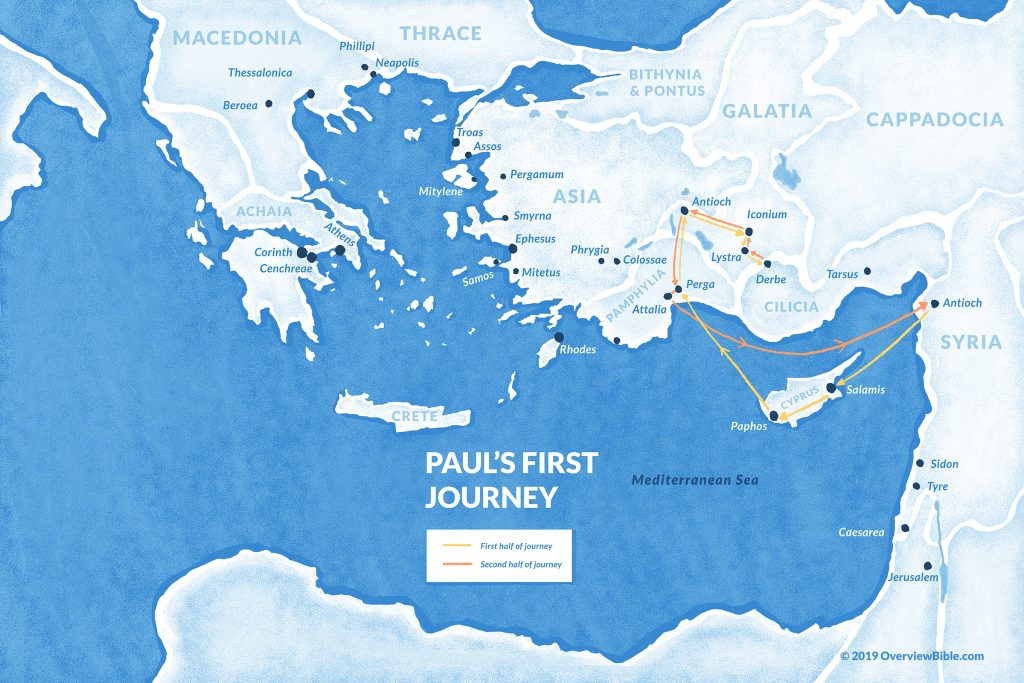
Paul’s first missionary journey began in Antioch. You may notice that maps of the ancient world often have two cities labelled Antioch. They’re both named after Antiochus, father of Seleucid I. The Antioch in Acts 13 was the third largest city in ancient Rome and capital of the province of Syria. Today, it’s part of southern Turkey. The other Antioch was part of Pisidia, an ancient region which is also now part of Turkey. Your Bible likely refers to it as Pisidian Antioch or Antioch of Pisidia.
In Antioch (the big city in Syria), the Holy Spirit singled out Paul and Barnabas from the believers worshiping there, and sent them on their first missionary journey.
Paul’s first journey took him by boat to the Roman province of Cyprus. Today, Cyprus is a country known as the Republic of Cyprus. It’s a mediterranean island south of Syria. Paul and Barnabas arrived in the port city of Salamis, where John Mark (who was possibly Barnabas’ cousin), helped them share the gospel in Jewish synagogues.
From Salamis, the group moved across the island to Paphos, where they were met by a Jewish sorcerer named Bar-Jesus (also known as Elymas the sorcerer). This sorcerer worked for the governor—Sergius Paulus—who sent for Paul and his companions because he wanted to hear the word of God. Elymas opposed them and tried to turn Sergius from the faith, and so Paul, filled with the Holy Spirit, called him a “child of the devil” and struck him blind. Sergius saw what happened, and believed.
Ironically, Elymas meant to steer Sergius away from Christ, but he became the very vehicle God used to draw Sergius toward him.
From Paphos, Paul and company set sail for the Roman province of Pamphylia, located in modern day Turkey. They arrived in the city of Perga, where John Mark left them and returned to Jerusalem (which, interestingly, was in the opposite direction from where they just came). We don’t know why John Mark decided to leave, but this would later create a rift between Paul and Barnabas.
Together, Paul and Barnabas travelled to Pisidian Antioch, where local synagogue leaders invited them to speak. Initially, the Jewish people were receptive to the gospel, but a week later, the entire city gathered to hear Paul and Barnabas, and the Jewish leaders became jealous. They resisted the message of the gospel, and so Paul and Barnabas made an important pivot: they began preaching to the Gentiles.
Many of the Gentiles believed the gospel, and Luke (the traditional author of Acts) tells us that:
“The word of the Lord spread through the whole region. But the Jewish leaders incited the God-fearing women of high standing and the leading men of the city. They stirred up persecution against Paul and Barnabas, and expelled them from their region.” —Acts 13:49–50
Driven out of Pamphylia, Paul and Barnabas travelled to Iconium, an eastern city in the region of Phrygia. Iconium still exists today as the Turkish city of Konya.
Once again, Paul and Barnabas spoke in the synagogue, where Jews and Greeks alike accepted the gospel. But the Jews who didn’t accept it stirred up trouble, even as Paul and Barnabas began performing signs and wonders (Acts 14:3). As support for Paul and Barnabas grew, so did the opposition they faced, and eventually, they became aware of a plot to abuse and stone them. So they left.
Fleeing the threat in Iconium, Paul and Barnabas left Phrygia altogether and travelled to Lystra, a city in the province of Lycaonia. Here, Paul healed a man who was lame.The locals who witnessed this miracle thought Paul and Barnabas were gods in human form, calling Barnabas Zeus and Paul Hermes. The priest from the temple of Zeus brought bulls and wreaths to offer sacrifices to them.
Paul and Barnabas attempted to redirect their praise to God, but struggled to keep the crowds from offering sacrifices to them.
Jews came from Antioch and Iconium and continued what they’d started. They riled up the crowds and convinced them to stone Paul. Believing he was dead, they dragged him outside the city. When the disciples gathered around him, Paul got up and went back inside the city.
Then Paul and Barnabas went to Derbe, another city in Lycaonia. There, they “won a large number of disciples” (Acts 14:21).
The return to Antioch
After a time in Derbes, Paul and Barnabas went back the way they came, working their way through Lystra, Iconium, Pisidian Antioch, and Perga. In each city, they encouraged the believers there and strengthened their faith, as they would continue doing on their future missionary journeys. They did, however, stop in a new Pamphylian city on the way: Attalia. Acts only mentions it in passing, but presumably, they established a community of believers there as well.
From there, they skipped a return voyage to the island of Cyprus and went straight back to Antioch (the big one), where they told the church what happened on their journey.
Paul’s second missionary journey (Acts 16:23–20:38)
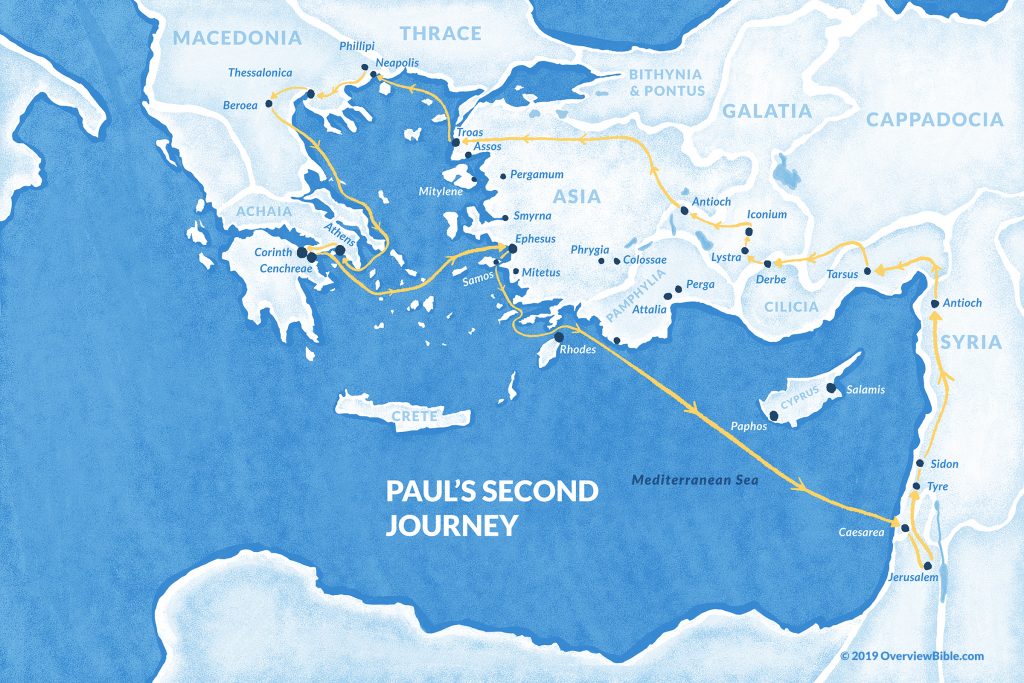
Paul’s second missionary journey established many of the churches he would later write to in his pastoral epistles. Interestingly, this may have happened in part because of a “sharp disagreement” he had with Barnabas. Paul’s original plan was to essentially have a rerun of their first trip, strengthening the communities they’d formed in each city and telling them what the Council of Jerusalem had ruled in regards to Gentile believers.
But Barnabas wanted to take John Mark—who had left them shortly into their previous journey. Paul was so opposed to the idea that they parted ways, initiating two separate missionary journeys. Barnabas took John Mark and went with the original plan, making their way back to the island of Cyprus. Paul took a man named Silas and travelled through the provinces of Syria and Cilicia.
The first cities that Acts mentions by name on Paul’s second journey are Derbe and Lystra. At this time, Paul and Silas picked up a new companion: Timothy.
The locals spoke highly of Timothy, and Paul wanted to bring him along even though he was half Greek, which meant local Jews would have a harder time accepting their message. Out of concern for these local Jews, Paul circumcised Timothy—even though, ironically, one of the things they were coming to tell Christians was that Gentiles didn’t have to be circumcised. (See Acts 16:3–4.)
Acts doesn’t specify where in Phrygia Paul and his companions stopped, but since he’d established a church in Iconium on the first trip, that community would’ve been on his mind (even though last time he was there, people had plotted to stone him). Interestingly, Acts notes that Paul and his companions journeyed here after they were “kept by the Holy Spirit from preaching the word in the province of Asia” (Acts 16:6).
Just north of Phrygia was the province of Galatia. Acts makes no mention of what happened here, but this is the province Paul wrote to in his letter to the Galatians . Interestingly, part of the purpose of Paul’s second trip was to share the news from the Council of Jerusalem regarding the Law of Moses and whether or not Gentiles (or Christians in general) should be expected to follow it. The council decided the Torah didn’t apply to Gentile believers (though they did hang on to a few rules). But by the time Paul wrote the Book of Galatians, Christians there were feeling pressure to obey the law (particularly in regards to circumcision) in order to be saved.
From Galatia, Paul’s group traveled west, until they reached the border of Mysia—a western region in the province of Asia, which is now part of Turkey. They intended to head north to the region of Bithynia, “but the spirit of Jesus would not allow them to” (Acts 16:7). So they passed by Mysia and headed to the city of Troas. Here, Paul had a vision of a man in Macedonia, begging him to “Come over to Macedonia and help us.” Paul took this vision as a sign that God was calling them to Macedonia, which was across the Aegean Sea.
From Troas, Paul and his companions sailed across the Aegean Sea, making a pitstop on the island of Samothrace before landing in Neapolis and then traveling to Philippi. In Philippi, they spoke with women outside the city gate. One of them was a wealthy cloth dealer named Lydia. After her household was baptised, she persuaded Paul’s group to stay with her for a while.
Later, Paul, Silas, and the others were confronted by a spirit-possessed slave woman who could predict the future. She followed them for many days, shouting, “These men are servants of the Most High God, who are telling you the way to be saved” (Acts 16:17). Paul became so annoyed that he cast out the spirit. Her owners were furious, because they had been profiting off of her fortune telling. So they turned the local magistrates against them, claiming Paul and Silas were stirring up trouble and trying to get Roman citizens to believe and do illegal things.
The authorities had Paul and Silas severely flogged and thrown in prison. Late at night, while they were worshiping, an earthquake shook the foundations of the prison, opened the doors, and freed the prisoners from their chains. When the jailer awoke and saw the doors open, he prepared to kill himself. But Paul stopped him and assured him everyone was still in the prison.
After listening to Paul and Silas share the gospel, the jailer believed in Jesus and had his whole household baptized.
The next morning, the magistrates ordered Paul and Silas released. Paul revealed that they were Roman citizens, who had just been beaten and imprisoned without trial, and the authorities became afraid. Paul and Silas returned to Lydia’s house, and then left the city of Troas.
After passing through the Macedonian cities of Amphipolis and Apollonia, they arrived in Thessalonica. Since Thessalonica had a synagogue, Paul turned to his usual method—preaching the gospel on the Sabbath. Over the course of three weeks, he achieved the usual result—many Jews and Greeks alike embraced the gospel . . . and those who didn’t were outraged by it.
At night, the Thessalonian believers sent Paul and his companions away to the nearby city of Berea.
The Bereans listened eagerly to the gospel and carefully examined the Scriptures to see if they supported Paul’s claims. Many Jews and Greeks became believers, but some agitators from Thessalonica heard Paul was in Berea, and they stirred up the crowds. Silas and Timothy stayed in Berea, while Paul was escorted out of Macedonia to Athens.
In the first century, Athens was in the region of Achaia, just south of Macedonia. Today, it’s the capital of Greece, and the largest city in the country.
Paul was essentially waiting around for Silas, Timothy, and the others to rejoin him. But while he waited, he noticed that Athens was full of idols. He debated with philosophers in both the synagogue and marketplace. Some Athenians were open to his ideas, and they were eager to discuss them. One idol in particular caught his eye—it had an inscription that read: “to an unknown god.” He seized on this as an opportunity to tell them about the “unknown God” who died and rose so that all might have eternal life.
Paul’s message in Athens incorporated observations about what he saw around him as well as quotes from famous Greek philosophers to point back to the gospel. After establishing a group of believers in Athens, Paul headed west to the city of Corinth.
In Corinth, Paul stayed and worked with a couple of Jewish tentmakers named Priscilla and Aquila. Every Sabbath, he preached to Jews and Greeks in the synagogue. Silas and Timothy rejoined Paul here, and Paul began focusing his energy on testifying about Jesus to the Jews.
When the Jews opposed his message, Paul devoted himself to reaching Gentiles, and he left the synagogue. As more Greeks embraced the gospel, the Corinthian Jews brought Paul before the governor, who basically told them to take a hike and refused to help.
Paul stayed in Corinth for a year and a half, and he left with Priscilla and Aquila.
The return journey
Before setting off for Syria, Paul stopped for a vow-fulfilling haircut in the port city of Cenchreae, which was just a hop, skip, and a jump from Corinth. With his companions, he sailed across the Aegean Sea to Ephesus, where he dropped of Priscilla and Aquila, and promised to come back if he could. After a short stay in Ephesus, Paul set sail for Caesarea, which was across the Mediterranean and far to the southeast. From there, he made the trek south to Jerusalem.
Paul’s second missionary journey ended in Jerusalem.
Paul’s third missionary journey (Acts 18:23–20:38)
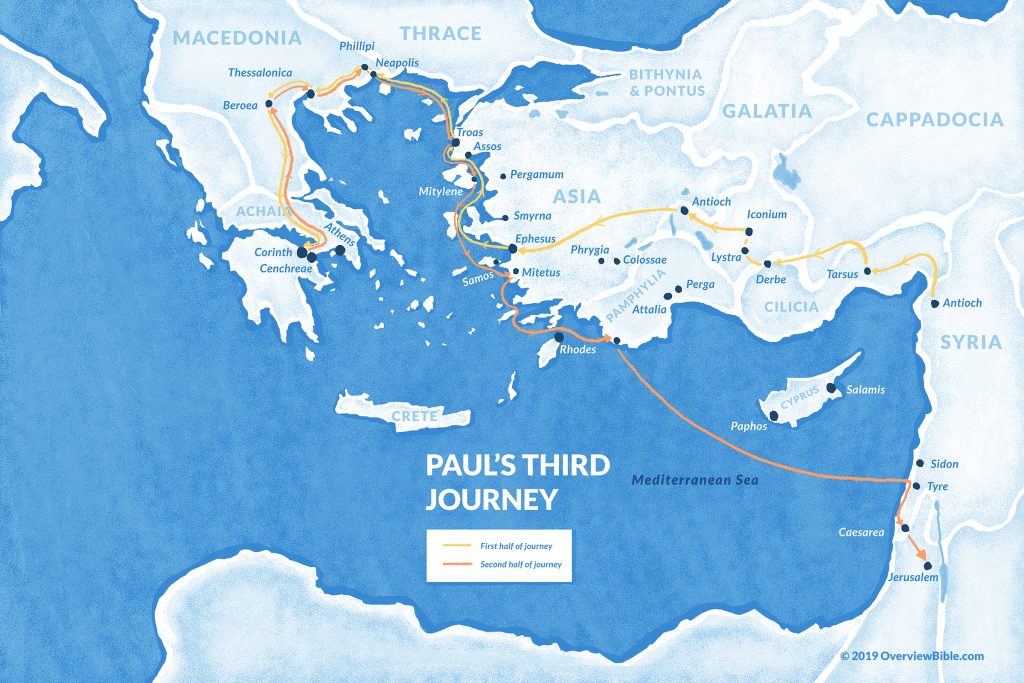
When you read Acts, there’s no transition from Paul’s second missionary journey to his third. His arrival in Jerusalem almost immediately began his next trip. But while his second journey ends in Jerusalem, the beginning of his third journey is actually in Antioch, which is about 300 miles north.
Phrygia and Galatia
From Antioch, Paul once again worked his way west, passing “from place to place throughout the region of Galatia and Phrygia, strengthening all the disciples” (Acts 18:23). This included Derbe, Lystra, and Iconium.
Paul traveled west to Ephesus, the capital of the province of Asia, where he’d left Priscilla and Aquila on his previous journey. Since he’d last visited, a man named Apollos had been preaching part of the gospel, but he didn’t know about the Holy Spirit. So when Paul arrived, he taught the Ephesians about the difference between water baptism and the baptism of the Spirit.
For three months, Paul preached in the synagogues. When people started criticizing Christianity, he left and began holding discussions in a lecture hall.
This went on for two years, and all the while, God used Paul to perform miracles. Even things Paul had touched—handkerchiefs and aprons—healed the sick and drove out evil spirits.
Some Jews thought invoking Paul’s name would let them drive out demons. Seven sons of a chief priest named Sceva said to an evil spirit, “In the name of the Jesus whom Paul preaches, I command you to come out” (Acts 19:13). The spirit replied that it knew Jesus and Paul, but not them, and then it pulverized all seven of them.
As word spread about what happened, people began to revere the name of Jesus. Local sorcerors came to repent, and they burnt scrolls that would have been worth more than 130 years’ worth of wages (Acts 19:19).
Around this time, a local silversmith named Demetrius realized that the future of his business (making idols) was jeopardized by the gospel. The demand for idols was going down all across the province of Asia, but especially in Ephesus, where he lived. So Demetrius gathered all the craftsmen and workers whose businesses were impacted, and stirred the entire city into an uproar. They seized two of Paul’s companions and brought them into a theater.
Paul wanted to address the crowd, but the disciples didn’t let him. Instead, a city clerk told everyone that unless they were going to bring formal charges against the men in a legal assembly, they were in danger of being charged with rioting.
Macedonia and Greece
After things settled down in Ephesus, Paul headed across the Aegean Sea to Macedonia. He traveled throughout the region, encouraging believers, and eventually arrived in Greece, where he stayed for three months. He intended to sail back to Syria (where his journey started), but some people plotted against him, so he took another lap through Macedonia instead.
Along the way, disciples joined Paul from many of the communities he’d ministered to. He had companions from Berea, Thessalonica, Derbe, and the province of Asia. These followers went ahead of Paul to Troas, in Asia. Paul stayed briefly in Philippi, then joined them.
Paul stayed in Troas for seven days. The night before he left, he stayed up late talking in a room upstairs. A young man sat in a window, drifted off to sleep, and fell to his death. Paul threw his arms around the man and declared that he was alive, and he was. Then Paul went back upstairs and continued talking until daylight.
Paul walked from Troas to Assos, which was just to the south, and then sailed for the nearby city of Mitylene. Eager to reach Jerusalem before Pentecost, Paul sailed past Ephesus and stopped in Miletus. There, he met with the leaders of the Ephesian church and essentially told them that he had taught them everything they needed to know, that he would not see them again, and that they needed to be on guard against false teachers. This is when Paul also famously quoted Jesus, sharing words that aren’t recorded in any of the gospels: “It is more blessed to give than to receive” (Acts 20:35).
And then he set sail.
Paul and his companions stopped briefly in Kos, Rhodes, and Patara before heading across the Mediterranean Sea to Phoenicia (the coastal region south of ancient Syria, which is now part of Syria). They arrived in Tyre, where “through the Spirit” (Acts 21:4), the local disciples urged Paul not to go to Jerusalem. He ignored them.
From Tyre, the voyage continued to the port city of Ptolemais, and then Caesarea, where the group stayed with Philip the evangelist (not to be confused with Philip the apostle ). Here, a prophet warned Paul that he would be bound by the Jews in Jerusalem and handed over to the Gentiles.
Still, he pressed on to Jerusalem, and by the end of Acts, the Jewish leaders had handed him over to Roman rulers.
Paul’s fourth missionary journey
Acts explicitly records three distinct missionary journeys. But some scholars and even ancient Christian writers have claimed that there was also a fourth missionary journey which was only hinted at in the Bible.
The argument for a fourth journey is primarily based on clues from Paul’s letters. He occasionally refers to events and visits that may not be accounted for in Acts or the epistles.
For example, Paul suggested he would travel to Spain (Romans 15:24), but he provides no record of this journey in his letters. However, early church fathers claimed Paul did, in fact, travel to Spain.
In his letter to the Corinthians, first-century church father Clement of Rome said Paul “had gone to the extremity of the west,” which at the time presumably meant Spain. Fourth-century church father John of Chrysostom said, “For after he had been in Rome, he returned to Spain, but whether he came thence again into these parts, we know not.” And Cyril of Jerusalem (also from the fourth century) wrote that Paul “carried the earnestness of his preaching as far as Spain.”
In 2 Timothy 4, Paul makes an ambiguous reference to “my first defense” and claims he was “delivered from the lion’s mouth” (2 Timothy 4:16-17). Some have interpreted this as a reference to his first defense before Emperor Nero, which he was heading for at the end of Acts.
Paul’s letters make other references to events not recorded in Acts, but since there is so much overlap in the locations mentioned, and Paul spent multiple years in some of these places on his three recorded journeys, it’s difficult to say whether or not this fourth journey ever actually happened.
Take a closer look at Paul’s footsteps
Paul’s missionary journeys are a key part of the New Testament. Paul’s epistles were originally written to the communities he formed on these journeys, and they show us exactly how Christianity spread to the Gentiles so rapidly.
Here at OverviewBible, we’ve charted each of Paul’s missionary journeys into beautiful, full-color posters you can display in your classroom or church office. Each comes in multiple sizes on fine art paper with a matte finish.

Get an overview of the entire Bible
The Bible is huge. Together, its 66 books are three times longer than Moby Dick . It’s so big that even if you’ve been reading it your whole life, you can still miss the point. Jeffrey Kranz, founder of OverviewBible, wrote The Beginner’s Guide to the Bible to help Christians and non-Christians alike get a better grasp of this important text.
This non-preachy, jargon-free guide will walk you through the Bible’s major themes and characters and help you see how each book fits into the larger story of Scripture.
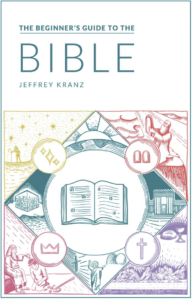
Explore the Bible with us!
We create research-based articles and handy infographics to help people understand the Bible.
Join our email list, and we’ll send you some of our best free resources—plus we’ll tell you whenever we make something new.
You have Successfully Subscribed!

- Bible Books
- Bible characters
- Bible facts
- Bible materials
- Bible topics
Recent Posts
- Interesting Facts about the Bible
- Logos Bible Software 10 review: Do you REALLY need it?
- Who Was Herod? Wait… There Were How Many Herods?!
- 16 Facts About King David
- Moses: The Old Testament’s Greatest Prophet
Privacy Overview

What happened on Paul's second missionary journey?
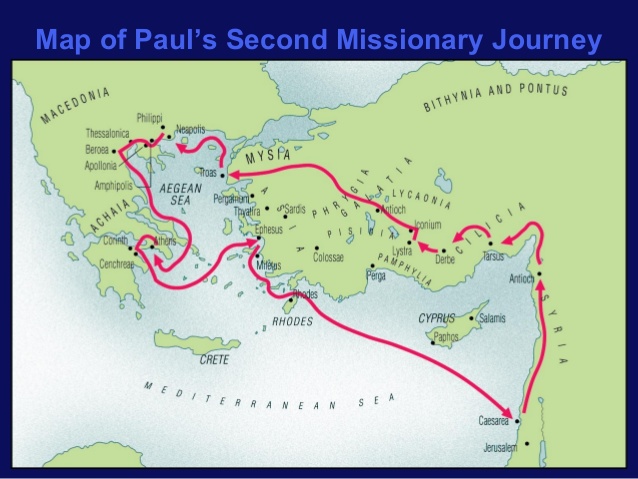
Acts 16-18 New Living Translation
Paul’s second missionary journey.
16 Paul went first to Derbe and then to Lystra, where there was a young disciple named Timothy. His mother was a Jewish believer, but his father was a Greek. 2 Timothy was well thought of by the believers [ a ] in Lystra and Iconium, 3 so Paul wanted him to join them on their journey. In deference to the Jews of the area, he arranged for Timothy to be circumcised before they left, for everyone knew that his father was a Greek. 4 Then they went from town to town, instructing the believers to follow the decisions made by the apostles and elders in Jerusalem. 5 So the churches were strengthened in their faith and grew larger every day.
A Call from Macedonia
6 Next Paul and Silas traveled through the area of Phrygia and Galatia, because the Holy Spirit had prevented them from preaching the word in the province of Asia at that time. 7 Then coming to the borders of Mysia, they headed north for the province of Bithynia, [ b ] but again the Spirit of Jesus did not allow them to go there. 8 So instead, they went on through Mysia to the seaport of Troas.
9 That night Paul had a vision: A man from Macedonia in northern Greece was standing there, pleading with him, “Come over to Macedonia and help us!” 10 So we [ c ] decided to leave for Macedonia at once, having concluded that God was calling us to preach the Good News there.
Lydia of Philippi Believes in Jesus
11 We boarded a boat at Troas and sailed straight across to the island of Samothrace, and the next day we landed at Neapolis. 12 From there we reached Philippi, a major city of that district of Macedonia and a Roman colony. And we stayed there several days.
13 On the Sabbath we went a little way outside the city to a riverbank, where we thought people would be meeting for prayer, and we sat down to speak with some women who had gathered there. 14 One of them was Lydia from Thyatira, a merchant of expensive purple cloth, who worshiped God. As she listened to us, the Lord opened her heart, and she accepted what Paul was saying. 15 She and her household were baptized, and she asked us to be her guests. “If you agree that I am a true believer in the Lord,” she said, “come and stay at my home.” And she urged us until we agreed.
Paul and Silas in Prison
16 One day as we were going down to the place of prayer, we met a slave girl who had a spirit that enabled her to tell the future. She earned a lot of money for her masters by telling fortunes. 17 She followed Paul and the rest of us, shouting, “These men are servants of the Most High God, and they have come to tell you how to be saved.”
18 This went on day after day until Paul got so exasperated that he turned and said to the demon within her, “I command you in the name of Jesus Christ to come out of her.” And instantly it left her.
19 Her masters’ hopes of wealth were now shattered, so they grabbed Paul and Silas and dragged them before the authorities at the marketplace. 20 “The whole city is in an uproar because of these Jews!” they shouted to the city officials. 21 “They are teaching customs that are illegal for us Romans to practice.”
22 A mob quickly formed against Paul and Silas, and the city officials ordered them stripped and beaten with wooden rods. 23 They were severely beaten, and then they were thrown into prison. The jailer was ordered to make sure they didn’t escape. 24 So the jailer put them into the inner dungeon and clamped their feet in the stocks.
25 Around midnight Paul and Silas were praying and singing hymns to God, and the other prisoners were listening. 26 Suddenly, there was a massive earthquake, and the prison was shaken to its foundations. All the doors immediately flew open, and the chains of every prisoner fell off! 27 The jailer woke up to see the prison doors wide open. He assumed the prisoners had escaped, so he drew his sword to kill himself. 28 But Paul shouted to him, “Stop! Don’t kill yourself! We are all here!”
29 The jailer called for lights and ran to the dungeon and fell down trembling before Paul and Silas. 30 Then he brought them out and asked, “Sirs, what must I do to be saved?”
31 They replied, “Believe in the Lord Jesus and you will be saved, along with everyone in your household.” 32 And they shared the word of the Lord with him and with all who lived in his household. 33 Even at that hour of the night, the jailer cared for them and washed their wounds. Then he and everyone in his household were immediately baptized. 34 He brought them into his house and set a meal before them, and he and his entire household rejoiced because they all believed in God.
35 The next morning the city officials sent the police to tell the jailer, “Let those men go!” 36 So the jailer told Paul, “The city officials have said you and Silas are free to leave. Go in peace.”
37 But Paul replied, “They have publicly beaten us without a trial and put us in prison—and we are Roman citizens. So now they want us to leave secretly? Certainly not! Let them come themselves to release us!”
38 When the police reported this, the city officials were alarmed to learn that Paul and Silas were Roman citizens. 39 So they came to the jail and apologized to them. Then they brought them out and begged them to leave the city. 40 When Paul and Silas left the prison, they returned to the home of Lydia. There they met with the believers and encouraged them once more. Then they left town.
Paul Preaches in Thessalonica
17 Paul and Silas then traveled through the towns of Amphipolis and Apollonia and came to Thessalonica, where there was a Jewish synagogue. 2 As was Paul’s custom, he went to the synagogue service, and for three Sabbaths in a row he used the Scriptures to reason with the people. 3 He explained the prophecies and proved that the Messiah must suffer and rise from the dead. He said, “This Jesus I’m telling you about is the Messiah.” 4 Some of the Jews who listened were persuaded and joined Paul and Silas, along with many God-fearing Greek men and quite a few prominent women. [ d ]
5 But some of the Jews were jealous, so they gathered some troublemakers from the marketplace to form a mob and start a riot. They attacked the home of Jason, searching for Paul and Silas so they could drag them out to the crowd. [ e ] 6 Not finding them there, they dragged out Jason and some of the other believers [ f ] instead and took them before the city council. “Paul and Silas have caused trouble all over the world,” they shouted, “and now they are here disturbing our city, too. 7 And Jason has welcomed them into his home. They are all guilty of treason against Caesar, for they profess allegiance to another king, named Jesus.”
8 The people of the city, as well as the city council, were thrown into turmoil by these reports. 9 So the officials forced Jason and the other believers to post bond, and then they released them.
Paul and Silas in Berea
10 That very night the believers sent Paul and Silas to Berea. When they arrived there, they went to the Jewish synagogue. 11 And the people of Berea were more open-minded than those in Thessalonica, and they listened eagerly to Paul’s message. They searched the Scriptures day after day to see if Paul and Silas were teaching the truth. 12 As a result, many Jews believed, as did many of the prominent Greek women and men.
13 But when some Jews in Thessalonica learned that Paul was preaching the word of God in Berea, they went there and stirred up trouble. 14 The believers acted at once, sending Paul on to the coast, while Silas and Timothy remained behind. 15 Those escorting Paul went with him all the way to Athens; then they returned to Berea with instructions for Silas and Timothy to hurry and join him.
Paul Preaches in Athens
16 While Paul was waiting for them in Athens, he was deeply troubled by all the idols he saw everywhere in the city. 17 He went to the synagogue to reason with the Jews and the God-fearing Gentiles, and he spoke daily in the public square to all who happened to be there.
18 He also had a debate with some of the Epicurean and Stoic philosophers. When he told them about Jesus and his resurrection, they said, “What’s this babbler trying to say with these strange ideas he’s picked up?” Others said, “He seems to be preaching about some foreign gods.”
19 Then they took him to the high council of the city. [ g ] “Come and tell us about this new teaching,” they said. 20 “You are saying some rather strange things, and we want to know what it’s all about.” 21 (It should be explained that all the Athenians as well as the foreigners in Athens seemed to spend all their time discussing the latest ideas.)
22 So Paul, standing before the council, [ h ] addressed them as follows: “Men of Athens, I notice that you are very religious in every way, 23 for as I was walking along I saw your many shrines. And one of your altars had this inscription on it: ‘To an Unknown God.’ This God, whom you worship without knowing, is the one I’m telling you about.
24 “He is the God who made the world and everything in it. Since he is Lord of heaven and earth, he doesn’t live in man-made temples, 25 and human hands can’t serve his needs—for he has no needs. He himself gives life and breath to everything, and he satisfies every need. 26 From one man [ i ] he created all the nations throughout the whole earth. He decided beforehand when they should rise and fall, and he determined their boundaries.
27 “His purpose was for the nations to seek after God and perhaps feel their way toward him and find him—though he is not far from any one of us. 28 For in him we live and move and exist. As some of your [ j ] own poets have said, ‘We are his offspring.’ 29 And since this is true, we shouldn’t think of God as an idol designed by craftsmen from gold or silver or stone.
30 “God overlooked people’s ignorance about these things in earlier times, but now he commands everyone everywhere to repent of their sins and turn to him. 31 For he has set a day for judging the world with justice by the man he has appointed, and he proved to everyone who this is by raising him from the dead.”
32 When they heard Paul speak about the resurrection of the dead, some laughed in contempt, but others said, “We want to hear more about this later.” 33 That ended Paul’s discussion with them, 34 but some joined him and became believers. Among them were Dionysius, a member of the council, [ k ] a woman named Damaris, and others with them.
Paul Meets Priscilla and Aquila in Corinth
18 Then Paul left Athens and went to Corinth. [ l ] 2 There he became acquainted with a Jew named Aquila, born in Pontus, who had recently arrived from Italy with his wife, Priscilla. They had left Italy when Claudius Caesar deported all Jews from Rome. 3 Paul lived and worked with them, for they were tentmakers [ m ] just as he was.
4 Each Sabbath found Paul at the synagogue, trying to convince the Jews and Greeks alike. 5 And after Silas and Timothy came down from Macedonia, Paul spent all his time preaching the word. He testified to the Jews that Jesus was the Messiah. 6 But when they opposed and insulted him, Paul shook the dust from his clothes and said, “Your blood is upon your own heads—I am innocent. From now on I will go preach to the Gentiles.”
7 Then he left and went to the home of Titius Justus, a Gentile who worshiped God and lived next door to the synagogue. 8 Crispus, the leader of the synagogue, and everyone in his household believed in the Lord. Many others in Corinth also heard Paul, became believers, and were baptized.
9 One night the Lord spoke to Paul in a vision and told him, “Don’t be afraid! Speak out! Don’t be silent! 10 For I am with you, and no one will attack and harm you, for many people in this city belong to me.” 11 So Paul stayed there for the next year and a half, teaching the word of God.
12 But when Gallio became governor of Achaia, some Jews rose up together against Paul and brought him before the governor for judgment. 13 They accused Paul of “persuading people to worship God in ways that are contrary to our law.”
14 But just as Paul started to make his defense, Gallio turned to Paul’s accusers and said, “Listen, you Jews, if this were a case involving some wrongdoing or a serious crime, I would have a reason to accept your case. 15 But since it is merely a question of words and names and your Jewish law, take care of it yourselves. I refuse to judge such matters.” 16 And he threw them out of the courtroom.
17 The crowd [ n ] then grabbed Sosthenes, the leader of the synagogue, and beat him right there in the courtroom. But Gallio paid no attention.
Paul Returns to Antioch of Syria
18 Paul stayed in Corinth for some time after that, then said good-bye to the brothers and sisters [ o ] and went to nearby Cenchrea. There he shaved his head according to Jewish custom, marking the end of a vow. Then he set sail for Syria, taking Priscilla and Aquila with him.
19 They stopped first at the port of Ephesus, where Paul left the others behind. While he was there, he went to the synagogue to reason with the Jews. 20 They asked him to stay longer, but he declined. 21 As he left, however, he said, “I will come back later, [ p ] God willing.” Then he set sail from Ephesus. 22 The next stop was at the port of Caesarea. From there he went up and visited the church at Jerusalem [ q ] and then went back to Antioch.
23 After spending some time in Antioch, Paul went back through Galatia and Phrygia, visiting and strengthening all the believers. [ r ]
Apollos Instructed at Ephesus
24 Meanwhile, a Jew named Apollos, an eloquent speaker who knew the Scriptures well, had arrived in Ephesus from Alexandria in Egypt. 25 He had been taught the way of the Lord, and he taught others about Jesus with an enthusiastic spirit [ s ] and with accuracy. However, he knew only about John’s baptism. 26 When Priscilla and Aquila heard him preaching boldly in the synagogue, they took him aside and explained the way of God even more accurately.
27 Apollos had been thinking about going to Achaia, and the brothers and sisters in Ephesus encouraged him to go. They wrote to the believers in Achaia, asking them to welcome him. When he arrived there, he proved to be of great benefit to those who, by God’s grace, had believed. 28 He refuted the Jews with powerful arguments in public debate. Using the Scriptures, he explained to them that Jesus was the Messiah.
- 16:2 Greek brothers; also in 16:40 .
- 16:6-7 Phrygia, Galatia, Asia, Mysia, and Bithynia were all districts in what is now Turkey.
- 16:10 Luke, the writer of this book, here joined Paul and accompanied him on his journey.
- 17:4 Some manuscripts read quite a few of the wives of the leading men.
- 17:5 Or the city council.
- 17:6 Greek brothers; also in 17:10 , 14 .
- 17:19 Or the most learned society of philosophers in the city. Greek reads the Areopagus.
- 17:22 Traditionally rendered standing in the middle of Mars Hill; Greek reads standing in the middle of the Areopagus.
- 17:26 Greek From one; other manuscripts read From one blood.
- 17:28 Some manuscripts read our.
- 17:34 Greek an Areopagite.
- 18:1 Athens and Corinth were major cities in Achaia, the region in the southern portion of the Greek peninsula.
- 18:3 Or leatherworkers.
- 18:17 Greek Everyone; other manuscripts read All the Greeks.
- 18:18 Greek brothers; also in 18:27 .
- 18:21 Some manuscripts read “I must by all means be at Jerusalem for the upcoming festival, but I will come back later.”
- 18:22 Greek the church.
- 18:23 Greek disciples; also in 18:27 .
- 18:25 Or with enthusiasm in the Spirit.
Holy Bible , New Living Translation, copyright © 1996, 2004, 2015 by Tyndale House Foundation. Used by permission of Tyndale House Publishers, Inc. , Carol Stream, Illinois 60188. All rights reserved.

Bible Gateway Recommends


Paul’s Four Missionary Journeys: The Complete Guide
God did many amazing things through the life and ministry of the apostle Paul. The gospel was spread to many people across the known world thanks to Paul’s efforts, despite the severe opposition and persecution Paul faced.
What were Paul’s missionary journeys? Paul took four missionary journeys. Paul’s first three missionary journeys are recorded in the book of Acts. The fourth is alluded to in Paul’s letters. On the first missionary journey Paul went through Cyrus, Pamphylia, and Galatia. On his second missionary journey he went through Galatia, Macedonia, and Achaia. Paul’s third journey took him through Galatia, Asia, Macedonia, Achaia, and ended in Jerusalem. After his third missionary journey Paul was imprisoned in Caesarea for two years and later transported to Rome where he was then placed under house arrest for another two years. His fourth missionary journey is not clear, but it may have included Spain, Crete, Asia, Achaia, and Macedonia.
By looking at Paul’s missionary journeys we can look and reflect on the beginning of the fulfillment of God’s command to “Go therefore and make disciples of all nations” (Matthew 28:19).
Timeline of Paul’s Missionary Journeys
- A.D. 37: Converted on the road to Damascus
- A.D. 37-40: Spends three years in Arabia
- A.D. 40: Brief visit to Jerusalem to meet with the apostle Peter
- A.D. 40-44: Preaches and ministers in Tarsus and surrounding regions
- A.D. 44 or 45: Relocates to Antioch in Syria
- A.D. 45 or 46: Travels with Barnabas to visit Jerusalem, brings a famine relief offering
- A.D. 46 or 47: First missionary journey with Barnabas, likely lasts 1-2 years
- A.D. 50: Attends the Jerusalem Council
- A.D. 51: Leaves on second missionary journey, trip lasts 2.5 to 3 years, including 18 months in Corinth
- A.D. 54: Leaves on third missionary journey, trip lasts more than 4 years, including 3 years in Ephesus
- A.D. 58: Arrested in Jerusalem, put on trial before the Roman governor Felix
- A.D. 58-60: Held in Caesarea for two years
- A.D. 60: Put back on trial by Festus the new Roman governor; eventually transported to Rome
- A.D. 61: Arrives in Rome
- A.D. 61-63: Placed under house arrest for two years
- A.D. 63: Released from house arrest, likely launches his fourth missionary journey
- A.D. 66 or 67: Imprisoned in Rome again
- A.D. 67 or 68: Martyred under Nero’s persecution
*Dates are approximate.
Paul’s Background
Before he was known as the apostle Paul, he was first known as Saul of Tarsus. He was a brilliant, pious, zealous, and well-educated Pharisee, from a wealthy and well-connected family. Saul was obviously intimately acquainted with the Hebrew Scriptures, but was also thoroughly acquainted with Greco-Roman history, language, and culture.
Saul became famous in Palestine because of his persecution of Christians. But things changed, dramatically. By God’s providence, Saul became a Christian after a supernatural encounter with Jesus on the road to Damascus (Acts 9).
After Saul’s conversion, he traveled to a few different places, over several years, including three years in Arabia (Gal. 1:17–18), a brief visit to Jerusalem (Gal. 1:18), and then several years of preaching in the regions of Syria and Cilicia (Gal. 1:21).
Partnership with Barnabas
After some heavy persecution of the Christians in Jerusalem, some believers ended up living in the city of Antioch. They preached the gospel there and a “great number” believed in Jesus (Acts 11:21). When the apostles in Jerusalem heard about this, they sent a man named Barnabas to Antioch to serve in the church there (Acts 11:22).
Barnabas was a prophet (Acts 13:1) and an apostle (Acts 14:14). Through his ministry a “great number of people were brought to the Lord” (Acts 11:24).
After being in Antioch a while, Barnabas traveled to Tarsus to find Saul. Barnabas recruited Saul to come teach and lead and serve in the church in Antioch in Syria (Acts 11:25-26). Saul relocated to Antioch sometime between 44 and 46 A.D. and served as one of the leaders of the church there.
Barnabas and Saul would become ministry traveling partners for the next few years, including at least one earlier trip to Jerusalem (Acts 11:27-30) in order to bring a famine relief offering to the Christians in Jerusalem (likely sometime between 45 and 46 A.D.).
First Missionary Journey
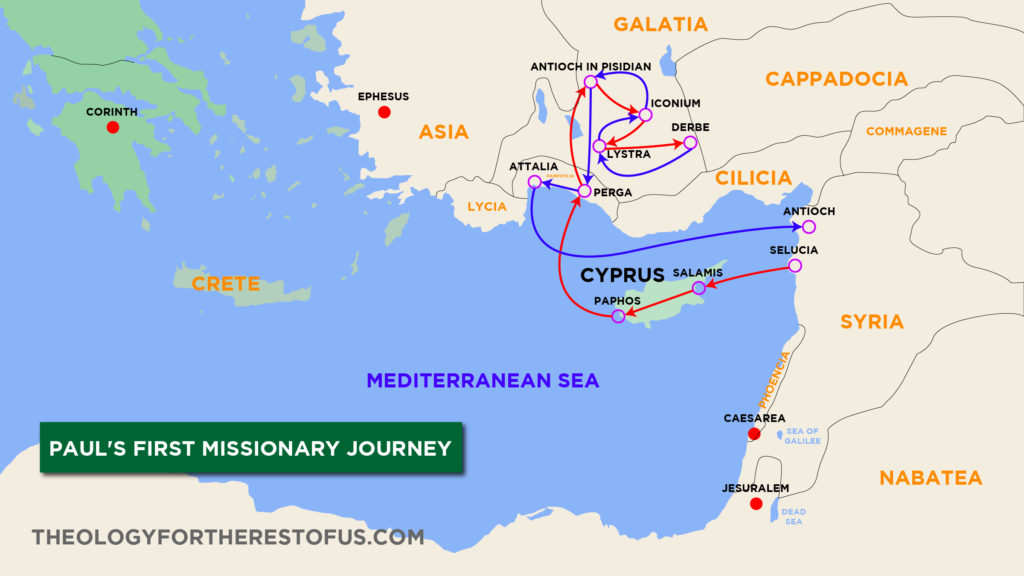
Barnabas and Saul sensed the call of the Holy Spirit to go out on their first missionary journey (Acts 13-14). Sometime around 46 A.D. (or 47 A.D.), Barnabas and Saul were set apart by the Holy Spirit and sent out on their first missionary journey by the church at Antioch.
Before Barnabas and Saul officially left on their first missionary journey, they recruited a young man named John Mark to go with them. John Mark was the son of a woman named Mary (mentioned in Acts 12:12). She owned the house where the Christians had been meeting and praying when Peter was miraculously delivered from jail by the angel.
It is likely that, as a young boy, John Mark had witnessed Jesus’ ministry first-hand. Sadly, however, during the missionary journey, John Mark would eventually abandon Barnabas and Saul. This would later lead to a significant dispute between Barnabas and Saul a few years in the future.
Barnabas and Saul sailed from Seleucia to the island of Cyprus, apx. 100 miles off the coast of Syria. They began by preaching to Jewish people in the synagogues of Salamis. The crew did ministry in several parts of the island until they got to Paphos (Acts 13:4-6).
During their ministry they faced significant opposition. One of their earliest opponents was a magician who was a Jewish false prophet. Saul performed a supernatural act that blinded this false prophet. These events led to the conversion of the Roman proconsul Sergius Paulus (Acts 13:6-12).
Saul Becomes Paul
After the events in Cyprus, the author of the book of Acts, Luke, begins to refer to Saul as Paul. Some Christians have asserted that Saul changed his name. However, it’s more likely that Saul and Paul were two different names for the same person all along; he was known by both names for many years.
After launching a Gentile-focused ministry, Paul would have been interacting with many Gentiles, and they would have likely preferred to refer to him by the Gentile name. It appears Luke sought to make this a point of emphasis. Scholar Greg Lanier says :
“When Saul Paul launches his Gentile-focused ministry among primarily Greek-speakers (beginning with Acts 13:9), it’s natural for Luke, the author of Acts, to begin referring exclusively to him by his Greek name. Nor is it surprising that he’s later referred to as ‘Paul’ in Jerusalem, since there were Greek speakers there too. Indeed, Luke could be making a thematic point by shifting from Saul to Paul around chapter 13, given the broader theme of Acts (e.g., 1:8). After all, the church’s nucleus is shifting from predominantly Jewish-centered Jerusalem to the Greek-centered ‘ends of the earth,’ such as Rome.”
Pamphylia and Galatia
Barnabas, Paul, and John Mark then traveled across the Mediterranean Sea to Perga in Pamphylia. This is where John Mark deserts Paul and Barnabas and heads back to Jerusalem (Acts 13:13).
From Perga, Paul and Barnabas then continued northward into the province of Galatia, coming to the city of Antioch in Pisidia (not to be confused with their home base city of Antioch in Syria).
Archaeologists have discovered an inscription containing the name ‘Sergius Paulus’ in the city of Antioch in Pisidia (he was the Roman proconsul that became a Christian back on the island of Cyprus). This is strong evidence that Sergius Paulus had family roots in Antioch in Pisidia. Some scholars have argued that he was the person that probably encouraged Barnabas and Paul to travel up to Antioch in Pisidia.
Once they arrived in Antioch in Pisidia, Paul went to the synagogue and preached about the good news of Jesus. Paul effectively preached in the synagogue for multiple weeks. This resulted in many people coming to faith in Jesus (Acts 13:14-44).
Unfortunately, Barnabas and Paul faced significant opposition there too. Part of the problem they faced was the jealousy of certain Jews. There were many Gentiles showing up to hear the gospel preached. Some Jews became jealous and started to contradict what Paul had to say. Since the Gentiles were more willing to hear what Paul had to say, he turned and preached to the Gentiles.
And when the Gentiles heard this, they began rejoicing and glorifying the word of the Lord, and as many as were appointed to eternal life believed. —Acts 13:48
The Gentiles’ response to the gospel was positive. The gospel continued to spread amongst Gentiles, but yet again the jealousy of the Jews became a significant issue. The Jews eventually drove Barnabas and Paul out of Antioch.
After leaving Antioch in Pisidia, they traveled eastward, further into the Galatian region, arriving at the city of Iconium. There they preached and did miracles in the name of Jesus.
Very similar to what had happened in Antioch, Paul went into the synagogue in Iconium to teach and the result was that many Jews and Greeks believed in Jesus, but the unbelieving Jews there stirred up trouble against Paul, dividing the city (Acts 14:1-4). Barnabas and Paul left the city when they heard about attempts to stone them (Acts 14:5).
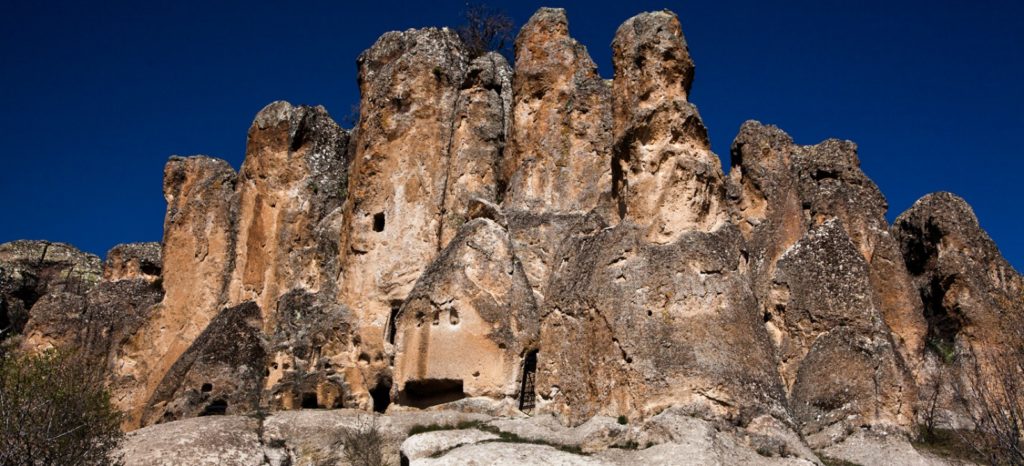
Lystra and Derbe
They then came to Lystra. There Paul performed a miracle causing a crippled man to walk again. When this occurred the people of the area assumed Barnabas and Paul were gods. The priest of Zeus brought animals to offer as sacrifices to Barnabas and Paul. When Barnabas and Paul realized what was happening, they tore their clothes in lament and told the people of the one true God (Acts 14:8-18).
The Jewish unbelievers from Antioch and Iconium had come to Lystra too, stirring up trouble. They convinced the people of Lystra to stone Paul and left him for dead outside the city. But Paul wasn’t dead. He got up walked back into the city (Acts 14:19-20).
The book of Acts doesn’t give us details about the events of that day when Paul walked back into the city, but I imagine the city’s residents were shocked. It was quite rare for anyone to survive stoning.
Barnabas and Paul then continued onto Derbe the next day. They preached and “won a large number of disciples” (Acts 14:21). Archeologists have discovered several inscriptions that show the Christian faith was a major presence in the city of Derbe after Barnabas and Paul’s visit.
Facing Tribulations for the Sake of Discipleship
Barnabas and Paul began their trek back home, but they decided that they’d first travel back through Galatia. When you look at a map, you see that it would have been much faster (and likely easier) to travel from Derbe directly to Antioch in Syria.
Derbe is less than 260 miles away from Antioch in Syria and less than 140 miles away from Paul’s original hometown of Tarsus. Barnabas and Paul could have traveled eastward through the region of Cilicia. Paul was very familiar with Cilicia and likely had friends throughout the region that could give them safe refuge along the way.
But Barnabas and Paul intentionally traveled more than 280 miles in the opposite direction of Antioch in Syria. Even though they had suffered great persecution in Galatia, they wanted to go back through the Galatian cities, before heading home, because they wanted to strengthen the disciples in those cities.
They returned to Lystra and to Iconium and to Antioch, strengthening the souls of the disciples, encouraging them to continue in the faith, and saying that through many tribulations we must enter the kingdom of God. —Acts 14:21-22
The journey through these cities for a second time gave them the opportunity to teach doctrine, establish elders in the churches, and pray with the believers.
After this, Barnabas and Paul then continued back down to Perga in Pamphylia. They preached in that region for a time. They eventually made their way over to the nearby port city of Attalia and sailed from there to Antioch in Syria (Acts 14:24-28).
Return to Antioch
Barnabas and Paul returned back home to Antioch in Syria stay there after the trip for “a long time” (Acts 14:28).
They had traveled more than 800 miles. Their first missionary journey had probably lasted between one and two years. When Barnabas and Paul arrived back in Antioch in Syria, they shared with everyone about the many people who had come to faith in Jesus and the churches that were established.
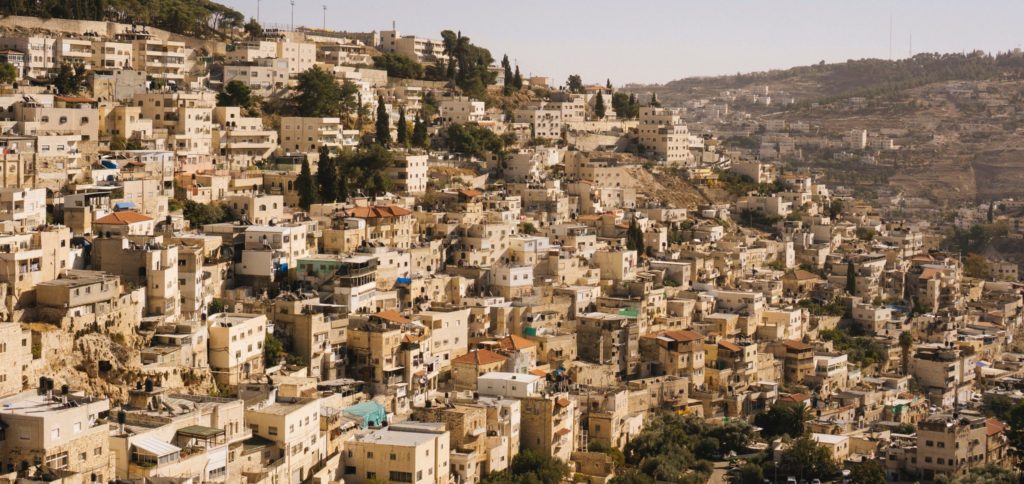
Jerusalem Council
After returning, Barnabas and Paul learned about a particular faction from Judea that had been confusing many Christians in the region by preaching a false gospel. This group had been preaching that, in order to become a Christian, the Gentiles must follow the Old Testament law, including circumcision (Acts 15:1).
Barnabas and Paul seem to have spent significant time disputing this false message and debated the Judean faction.
Eventually, this debate, about this false gospel, was appealed to the apostles in Jerusalem (Acts 15:2). This led to the Jerusalem Council (Acts 15:3-35), which likely took place sometime in 50 A.D. (some scholars date this event as early as 48 A.D. and some date it as late as 51 A.D.).
While traveling to Jerusalem for the council, Barnabas and Paul made stops along the way throughout Phoenicia and Samaria, encouraging believers wherever they went.
At the council, all the apostles concluded that the Gentiles do not need to follow the Jewish laws in order to become Christians. Barnabas and Paul (as well as several other men who had been at the council) headed back to Antioch to declare the good news. After the council they stayed in Antioch “some days” (Acts 15:36).
Paul and Barnabas Separate
Not long after the Jerusalem Council, Barnabas and Paul began planning their second missionary journey. They believed it was essential that they go to the Gentile world to proclaim the statements that came from the council.
Originally, Barnabas and Paul had intended to go out together again, however, they had a “sharp disagreement” (Acts 15:39). The source of this dispute was John Mark. Barnabas wanted John Mark to come along again, but Paul was against this idea since John Mark had deserted them on their previous missionary trip when they were in Pamphylia. Paul saw John Mark as a liability.
Due to this sharp disagreement, Barnabas and Paul would go on separate missionary journeys. Barnabas took John Mark and sailed to Cyprus. Paul took a young man named Silas and traveled by land (Acts 15:39-41).
Paul’s Second Missionary Journey
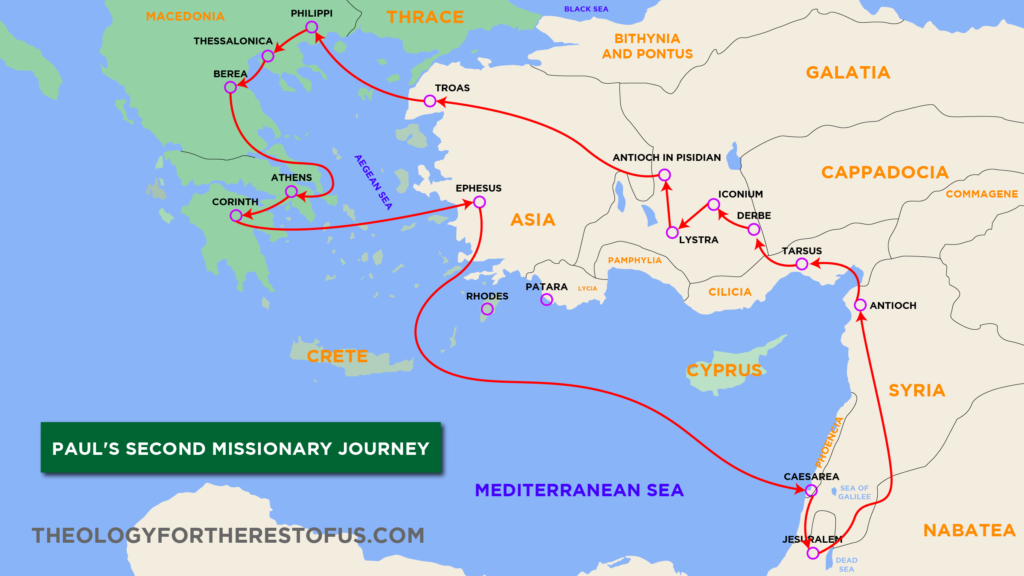
Paul likely started his second missionary journey (Acts 15-18) sometime late in 50 A.D. or early in 51 A.D. (but some scholars date both the council of Jerusalem and the launch of this missionary journey as early as 48 A.D.).
Paul and Silas started by traveling northwestward by land through the region of Cilicia. The Roman road that they would have used went directly through Paul’s hometown of Tarsus. I imagine this would have given Paul the sweet opportunity to reconnect with many old friends.
Paul and Silas made stops in the churches all throughout the region, along their way, “strengthening” believers (Acts 15:41).
Return through Galatia
Paul and Silas continued their travels westward into Galatia. They spent significant time in several Galatian cities including Derbe, Lystra, and Iconium, connecting with the churches that Paul had planted with Barnabas on this first missionary journey.
Paul and Silas taught the believers throughout Galatia what had been decided at the council in Jerusalem and the “churches were strengthened in the faith, and they increased in numbers daily” (Acts 16:5).
Paul Circumcises Timothy
Along the way, Paul and Silas meet a young man named Timothy from that region. He had a good reputation. Paul decided to let Timothy accompany them. However, Paul first circumcised Timothy (Acts 16:3).
It seems that Paul knew that having an uncircumcised man like Timothy with him could somehow impede the advance of the gospel wherever they preached.
Paul intended to continue to preach that circumcision was not necessary for salvation. But Paul knew that Timothy’s presence could potentially cause their opponents to claim that the only real reason that Paul was making these claims is because he had an uncircumcised friend (Timothy).
Paul’s Ministry Restricted
Paul and his crew traveled throughout the “region of Phrygia and Galatia” (Acts 16:6) looking for opportunities to preach the gospel in Asia (modern-day southwest Turkey), but they were restricted from doing so multiple times. They then traveled to the region of Mysia (modern-day northwest Turkey), attempting to eventually make their way northward toward Bithynia, but multiple times they were restricted or diverted by the Spirit (Acts 16:7).
It seemed that God’s providence was leading them somewhere other than what Paul had originally intended. They passed through Mysia again and eventually ended up in the city of Troas near the cost of the Aegean Sea.
Luke Joins the Team
In Troas, Luke joins their missionary crew. The book of Acts does not explicitly state this, but it’s implied. Throughout most of the book of Acts, Luke speaks in the third person. However, starting in Acts 16:10, Luke begins to speak in first person, as if he had joined the team by that point.
Luke would become one of Paul’s ministry protégés. He was a Greek physician, but he also functioned as an investigative journalist. He eventually writes both the Gospel of Luke and the book of Acts. Some scholars have also suggested that Luke wrote the book of Hebrews.
Macedonian Call and Travel to Philippi
While at Troas, Paul received a vision. This vision was of a Macedonian man asking for Paul to come and help them (Acts 16:9-10). After receiving this vision they sailed across the Aegean Sea to the island of Samothrace, and then onto Neapolis (modern-day northeastern Greece).
The missionary crew then traveled to Philippi where they stayed for “some days” (Acts 16:12). While there, they preached the gospel. One specific woman they met was Lydia. She became a believer along with the rest of her household and invited Paul and his companions to stay (Acts 16:13-15).
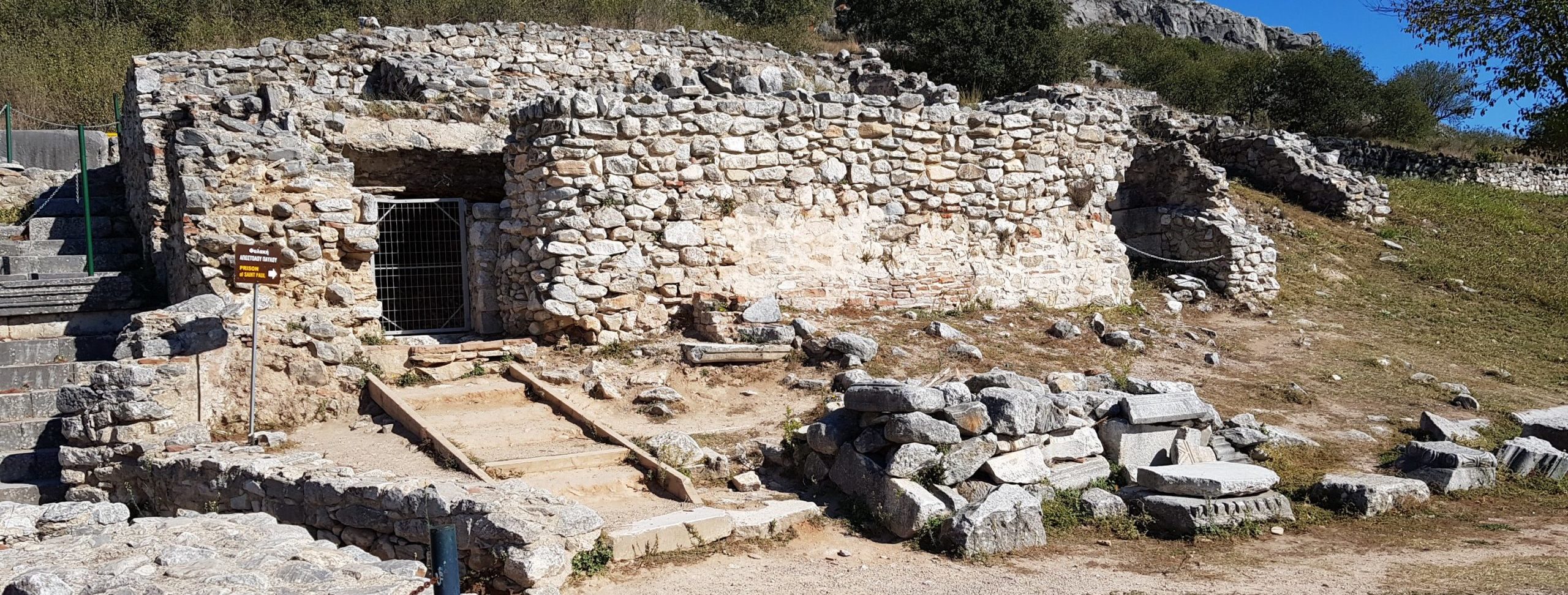
Paul and Silas Jailed in Philippi
While in Philippi, Paul and Silas met a slave girl who was demon possessed. Her owners made money off of her because the demon gave her the ability to function as a fortune-teller. For several days she followed Paul and Silas around, declaring that Paul and Silas were preachers of the one true God (Acts 16:16-18).
Paul cast the demon out of her. The girl’s owners realized that they wouldn’t make any more money from her, because she could no longer function as a fortune-teller. They were angry so they took Paul and Silas to the magistrates. Paul and Silas were beaten with rods and thrown into jail. Paul had previously been beaten and persecuted, but this marked the first time he was officially imprisoned (Acts 16:18-24).
While in prison, Paul and Silas prayed and sung hymns to the Lord. As they sang and prayed many of the other prisoners listened. Late in the night an earthquake occurred, this earthquake not only opened all the doors but broke their chains.
The jailer believed that all the prisoners had escaped and was about to kill himself (the Romans would’ve blamed the guard and likely would’ve executed him). But Paul and Silas stopped him and told him that no one had escaped. Then the jailer responded asking how to be saved.
And they said, “Believe in the Lord Jesus, and you will be saved, you and your household.” —Acts 16:31
God turned the persecution into an opportunity for gospel proclamation. Paul and Silas were not only able to witness to the jailer but all the prisoners listening to their hymns and prayers throughout the night. Paul went to the jailers home to preach and several people came to faith (Acts 16:25-34).
When the town magistrates learned that Paul and Silas were Roman citizens, the magistrates apologized for having unlawfully imprisoned them. This was a public vindication (of sorts) for Paul and Silas. Before leaving, Paul and Silas spent more time with Lydia and the other new converts in the region, encouraging them in the faith (Acts 16:35-40).
Thessalonica
Next, Paul and his crew passed through Amphipolis and Apponia and came to Thessalonica (Acts 17:1). As was his habit, Paul first went to the synagogue to preach to the Jews. He preached there on three consecutive Sabbath days. Many people believed, including many Gentiles.
Yet again, as Paul had seen before, many Jews became angry and jealous, and they caused an uproar. One of the brothers that had welcomed Paul was a man named Jason. The Jews dragged Jason before the city’s leaders. Jason was eventually released.
Paul and Silas left the city. It does seem that the church in Thessalonica continued to face persecution and trouble from their countrymen, but they flourished anyway. We read these words in Paul’s letter to the church:
For you, brothers, became imitators of the churches of God in Christ Jesus that are in Judea. For you suffered the same things from your own countrymen as they did from the Jews. —1 Thess. 2:14
Paul and his crew went to Berea. There, Paul yet again started in the Jewish synagogue, but this time he got a different response. Instead of jealousy and mobs, the Jews there examined the Scriptures to see if what Paul was saying was true. Many believed in Jesus.
Paul praised their willingness to study and pursue truth. Luke says the Jews of Berea were “more noble” than the Jews of Thessalonica (Acts 17:11).
Things seem to be going well. Many people became Christians. But the Jews from Thessalonica heard that Paul was teaching in Berea and they came to stir up the crowds and trouble. Paul was sent away by the brothers there, but Silas and Timothy stayed behind (Acts 17:13-14).
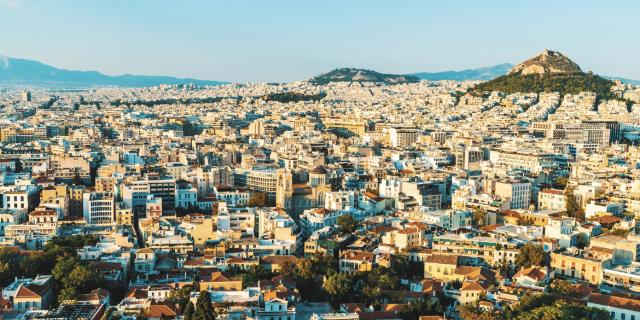
Traveling in Achaia
The apostle Paul was then escorted by some brothers more than 300 miles south, into the region of Achaia, reaching the city of Athens. When they arrived in Athens, the brothers headed back. Paul stayed in Athens, but told the brothers to tell Silas and Timothy that he wanted them to join him as soon as possible (Acts 17:15).
While Paul waited for Silas and Timothy, Paul’s “spirit was provoked within him” (Acts 17:16) because he saw an abundance of idols in the region.
Paul decided to make the best use of his time and talked with the Jews at the synagogue and preached to many Gentiles in the marketplace (Acts 17:17). Paul also talked with Epicurean and Stoic philosophers (Acts 17:18). They eventually brought Paul to the Areopagus, the court where men discussed philosophy, civics, and religion.
In the court of the Areopagus, Paul preached one of his most famous sermon (Acts 17:22-31). Paul’s sermons included quotes from famous Greek philosophers that they would have been familiar with. This gives us insights into Paul’s knowledge of their culture and insights into Paul’s missiology.
After hearing Paul’s sermon, there were some there who laughed at him, but there were also some who believed the gospel and joined Paul (Acts 17:32-34).
First Visit to Corinth
After leaving Athens, Paul traveled 53 miles southwest to Corinth. By this point in his second missionary journey, Paul had traveled more than 1,500 miles.
The apostle Paul probably arrived in Corinth apx. 8-12 months after the start of the second missionary journey, therefore, it’s likely that he got there sometime late in the year of 51 A.D. (or maybe sometime early in 52 A.D., depending on how we date his departure from Antioch in Syria). Paul stayed in Corinth for a year and a half (Acts 18:11), so Paul was likely in Corinth until the summer or fall of 53 A.D.
Silas and Timothy also rejoined Paul in Corinth.
While in Corinth, Paul met two Jews from Rome, Aquila and Priscilla. Like the apostle Paul, Aquila and Priscilla were also tentmakers. Paul stayed with them and worked while also going to the synagogues on the Sabbath to preach, seeking to convert both Jews and Greeks (Acts 18:1-4).
Paul faced some opposition from Jews in Corinth (Acts 18:5-9), but many people in the city believed anyway. Paul may have been considering leaving the city, but he stayed in Corinth after having received a vision from God that told him that “no one will attack or harm you” (Acts 18:10).
While in Corinth the apostle Paul wrote his letters to the Thessalonians, encouraging the new believers there to stand firm under the pressure and pain of persecution. He gives them instructions on how to live a godly lifestyle and gives doctrinal teaching about the future second coming of Christ.
Paul continued to preach the word of God faithfully for those 18 months. Many were saved and the church was established. But many Jews were upset.
The Jews of Corinth eventually tried to bring the apostle Paul before the Roman proconsul Gallio, who happened to be the older brother of the renowned dramatist and philosopher Seneca (the tutor of Emperor Nero). Gallio refused to even hear their case against Paul and sent them away (Acts 18:12-17).
Paul stayed in Corinth for “many days longer” (Acts 18:18) after being brought before Gallio. He then started his journey back home to Antioch in Syria, but planned to first make a stop in Ephesus. Priscilla and Aquila came with him.
Leaving from Cenchreae
Paul’s crew traveled to the nearby port city of Cenchreae, just eight miles from Corinth. We don’t know how long they stayed in Cenchreae, but they were there long enough for Paul to have his head shaved as part of a vow (Acts 18:18). It’s possible that this stop was very brief, but it’s also possible that they spent some time preaching and ministering there in the city.
There does seem to be some evidence that Paul spent some significant time in Cenchreae. But we cannot be certain. Also, we’re not sure if he spent time there during this second missionary journey or if that happened at a later time during his third missionary journey.
Brief Visit to Ephesus
When Paul arrived in Ephesus, he went into the synagogue to talk with the Jews about Jesus. His visit to Ephesus was brief. They requested that he stay in the city longer. He declined but said, “I will return to you if God wills” (Acts 18:21). Paul made plans to leave, but Priscilla and Aquila stayed in the city.
Paul traveled from Ephesus to Caesarea. Once he was there he visited with the believers in the region and preached the gospel in various towns and places. He briefly visited Jerusalem and then traveled back home to Antioch in Syria.
Paul’s second missionary journey lasted between two and a half years and three years, and likely ended back in Antioch sometime in the fall of 53 A.D. (or maybe early 54 A.D.).
Paul’s Third Missionary Journey
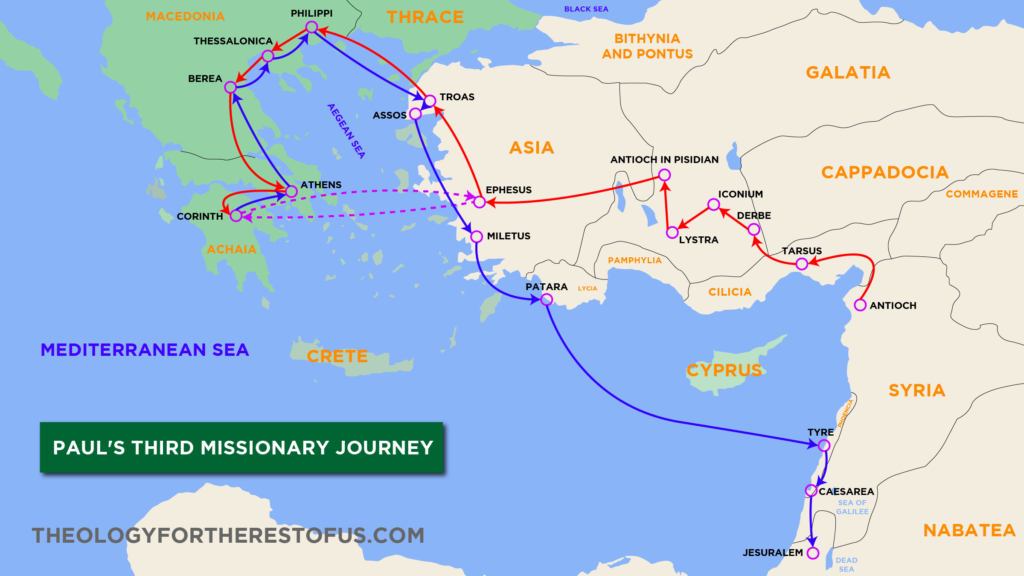
After getting back from his second missionary journey, the apostle Paul stayed Antioch for “some time” (Acts 18:23). Maybe just a few weeks or few months. He then launched his third missionary journey (Acts 18-21).
Paul likely left for his third missionary journey in the spring of 54 A.D. This third missionary journey was probably more than four years long and ended with Paul in Jerusalem in 58 A.D.
Galatia and Phrygia
Paul began his third missionary trip by visiting many of the same locations that he had visited on his first and second missionary journeys. We don’t know his exact route, but it’s likely he began by traveling through the region of Cilicia and through the city of Tarsus, on the way toward Galatia.
He spent several months traveling to the churches throughout the regions of Galatia and Phrygia, “strengthening all the disciples” (18:23). Paul passed through the “inland” route through Asia and traveled west to Ephesus (Acts 19:1).
Three Years in Ephesus
Paul spent three labor-intensive years in Ephesus (Acts 20:31). Paul was likely in Ephesus from the fall of 54 A.D. to the fall of 57 A.D.
Paul’s time in Ephesus was hard. He later says that he experienced many “afflictions” and he wasn’t confident that he would live through this season (2 Cor. 1:6-10). But God did many great things through Paul while he was in Ephesus.
For the first few months of Paul’s ministry in Ephesus, he spent time preaching in the synagogue. That was his focus. However there were many Jews stuck in unbelief, and they said evil things about Paul and the gospel message. So Paul decided to spend the last two and half years of his time in Ephesus preaching in the hall of Tyrannus, instead of the synagogue. He preached in the hall of Tyrannus daily and “all residents of Asia heard the word of the Lord” (Acts 19:10).
During Paul’s ministry, he performed many miracles in the name of Jesus, leading many to believe.
“God was doing extraordinary miracles by the hands of Paul… even handkerchiefs or aprons that had touched [Paul’s] skin were carried away to the sick, and their diseases left them and the evil spirits came out of them.” —Acts 19:11-12
God-Fearers Received the Holy Spirit
One of the most famous events from Paul’s time in Ephesus was when he corresponded with a group of disciples that had known about John’s baptism (referring to John the Baptist), but they did not know about Jesus (Acts 19:1-3). These types of believers were sometimes referred to as God-fearers.
These God-fearers had previously been taught by a great preacher named Apollos. He had taught them to revere the one true God, the God of Israel. But Apollos himself had not known about Jesus until after he had preached to this particular group of disciples. Apollos was later instructed by Paul’s friends, Priscilla and Aquila (Acts 18:24-28).
Paul taught this particular group about Jesus. They believed and received the Holy Spirit (Acts 19:4-7).
The Sons of Sceva
Another event that the book of Acts highlights, from Paul’s time in Ephesus, is about seven traveling Jewish exorcists, the sons of Sceva. These exorcists came across a demon-possessed man. They attempted to cast-out the demons (Acts 19:11-14). But one of the demons responded to them, “Jesus I know, and Paul I recognize, but who are you?” (Acts 19:15).
The demon-possessed man (under the control of the evil spirits) attacked the seven men and badly beat them (Acts 19:16). This caused many people in the region to respect Paul and his ministry. Many of the magicians in the area repented and burned their magic books (Acts 19:17-19) and “the word of the Lord continued to increase in the region” (Acts 19:20).
Demetrius, Riots, and Leaving Ephesus
Paul was planning to leave Ephesus. However, before he left Ephesus, a silversmith named Demetrius caused trouble. Demetrius made and sold idols. Paul preached against idolatry, so many people stopped buying Demetrius’ idols. This cost him money. Demetrius clearly was not happy.
There were other business owners that were also hurt financially because of Paul’s preaching. Many people had stopped buying their idols as they responded to the gospel. When these merchants got together, they started a massive riot in the city.
Paul wanted to go into the crowd to calm them down, but the disciples would not let him because they knew that Paul could get killed. Some of the Christians went into crowd and calmed the riot. Shortly after these riots, Paul set sail for Macedonia (Acts 19:21-20:1).

The “Painful” Visit
Paul had made plans to travel through Macedonia and then southward into Achaia (1 Cor. 16), which would likely include a visit to the church in Corinth.
At some point, Paul received some correspondence telling him that there were massive problems in the church of Corinth. How did Paul respond when he received this news? There are two main views from scholars.
View #1: Paul immediately changed plans and left from Ephesus to Corinth.
Some scholars argue that as soon as Paul received word that there were big problems in Corinth, Paul changed his plans and decided to visit the Corinthians immediately, skipping his original plans to travel through Macedonia.
Paul probably thought that once he was there in Corinth, that he’d be able to resolve the conflicts. But it seems that the exact opposite happened. Paul would later describe this visit as “painful” (2 Cor. 2:1). During this “painful” visit Paul was deeply hurt by someone in the church (2 Cor. 2:5).
The scholars that embrace View #1 say that Paul then left Corinth after this “painful visit” and headed back to Ephesus for a brief period of time.
It then appears that Paul was contemplating returning to Corinth, yet again, before heading over to Macedonia, but Paul ultimately decided against this additional visit, in order to “spare” the Corinthians (2 Cor. 1:23). Paul defends this decision in 2 Corinthians (vv. 1:12-2:2).
Paul then left from Ephesus to Macedonia (Acts 20:1). However, Paul would eventually make a third visit back to Corinth a few months later toward the end of this journey.
These scholars typically piece it all together like this:
- Paul (while in Ephesus) receives news of trouble in the church of Corinth and changes his plans
- Travels from Ephesus to Corinth for a second visit (known as the “painful” visit)
- Travels from Corinth back to Ephesus
- Contemplates another visit to Corinth, but decides against it
- Experiences the Demetrius-led riots in Ephesus
- Travels onto to Macedonia
- Goes from Macedonia down into Greece
- Eventually makes it back to Corinth (third overall visit)
Scholars that hold to View #1 assert that Paul ultimately made three total visits to Corinth; his first visit (the 18 months he spent there during his second missionary journey), the “painful” visit from Ephesus, and then a third visit toward the end of this third missionary journey.
View #2: Paul did not change his plans, but visited Corinth later.
Scholars that hold to View #2 say that Paul likely received some communication from Corinth (that there were indeed big problems in the church), but these scholars conclude that receiving this communication did not cause Paul to visit Corinth immediately.
The scholars that embrace View #2 argue that Paul did consider changing his plans, which would have consisted of a visit to Corinth before going through Macedonia, but these scholars argue that ultimately Paul decided against going to Corinth immediately, so he stuck to his plans to travel through Macedonia. They interpret Paul’s words in 2 Corinthians (vv. 1:12-2:2) as Paul giving a defense as to why he did not visit them.
These scholars say that eventually Paul did visit Corinth, a few months later, toward the end of his third missionary journey. Scholars that embrace View #2 often say that the word “painful” (2 Cor. 2:1) was not a description of an actual visit that ever happened, but that it was a description of the type of visit that would have ensued if Paul had indeed visited them. He knew that if he did visit, it would have been painful, so he sought to “spare” them (2 Cor. 1:23).
- Paul (while in Ephesus) receives news of trouble in the church of Corinth
- Contemplates an immediate visit to Corinth, but ultimately decides against it
- Goes from Ephesus to Macedonia
- Eventually travels to Corinth for his second visit
Scholars that hold to View #2 assert that Paul ultimately made two total visits to Corinth; his first visit (the 18 months he spent there during his second missionary journey) and then his visit to Corinth toward the end of this third missionary journey.
Leaving For Macedonia and the Sorrowful Letter
Paul leaves Ephesus and heads toward Macedonia. In the book of Acts, Luke gives us no details. He only says that Paul “departed for Macedonia” (Acts 20:1). However, by examining Paul’s letters, we get more insight into these travels.
It appears that, at some point during this journey, Paul had sent Titus to Corinth with a letter (this is sometimes referred to as the “sorrowful letter”). Paul later describes this “sorrowful” letter as having been written with “much affliction and anguish of heart and with many tears” (2 Cor. 2:4).
Some scholars contend that this “sorrowful letter” is the epistle that appears in the New Testament, that we know today as 1 Corinthians. Other scholars argue that the “sorrowful letter” is a separate correspondence that has been lost to history.
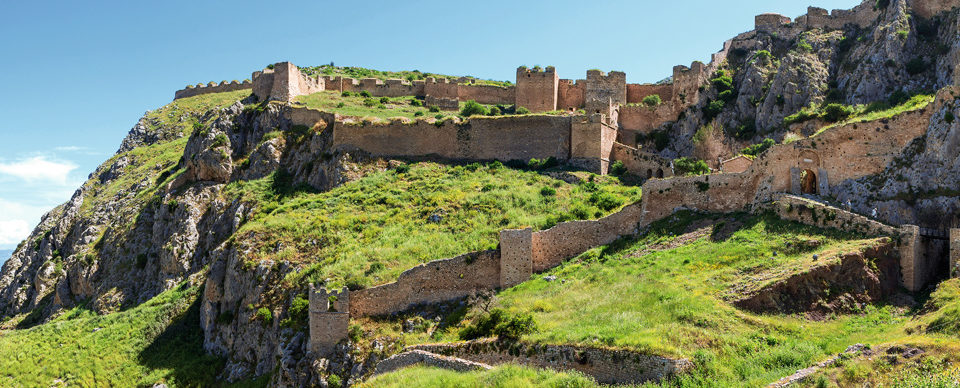
Ministry in Troas and Macedonia
On the way to Macedonia, Paul stopped in Troas to preach there and to await Titus’ return from Corinth. While waiting in Troas, Paul had great ministry opportunity. He called it an “open door” (2 Cor. 2:12).
However, when Titus’ return from Corinth appeared to be delayed, Paul was concerned for Titus’ safety. Paul decided to leave Troas and traveled to Macedonia to find Titus (2 Cor. 2:13).
Paul traveled throughout Macedonia, visiting the churches and friends in the region, and encouraging the believers in those churches (Acts 20:2).
Finally, while in Macedonia, Paul was reunited with Titus. Titus reported that many people in the church of Corinth had repented after hearing Paul’s letter (2 Cor. 2:5-11; 7:5-16). Paul was filled with joy.
However, Titus also reported that Paul’s opponents still wielded some influence over a small rebellious faction within the church questioning Paul’s authority and credibility. Paul responded to this faction by writing another letter (most likely from Philippi). This letter is in our New Testament, known today as 2 Corinthians.
Three Months in Greece
After these travels through Macedonia, the apostle Paul eventually traveled southward and finally arrived in Greece (i.e., Achaia). He stayed in the region for three months (Acts 20:2-3), including a lengthy stay in Corinth. This stay likely took place in late 57 A.D. or early 58 A.D.
While in Corinth, Paul wrote his theological masterpiece, the letter to the Romans.
As previously discussed in this article, some scholars believe that this was Paul’s second visit while others argue that this was his third visit.
Cenchreae and Phoebe
It’s also possible that during these three months in Achaia, Paul spent time in the nearby city of Cenchreae. In the book of Romans, Paul mentions Phoebe, a deaconess in the church of Cenchreae (Rom. 16:1).
Phoebe was the person that delivered Paul’s letter to the Romans, and Paul asked them to welcome her, praising her for being a “patron of many” (Rom. 16:2). It’s highly unlikely that Paul would have asked her to make this important delivery for him unless he knew her well and trusted her, pointing to the likelihood that Paul had spent time in Cenchreae before writing that letter.
As previously mentioned in this article, it’s also possible that Paul had spent some time in Cenchrea during his second missionary journey as well as this third missionary journey.
One More Lap Through Macedonia
After his time in Achaia, Paul had originally intended to sail directly to Jerusalem. Those plans were changed, however, when it was discovered that some of Paul’s opponents had been plotted against him. Paul decided to take another lap through Macedonia instead (Acts 20:3).
Paul had many companions with him, from various churches, which gave him protection while he traveled through Macedonia (Acts 20:4-5).
Throughout the spring of 58 A.D., Paul traveled through the Macedonian region, visiting towns such as Berea and Thessalonica, and eventually ending up in Philippi (again) during the “days of unleavened bread” (Acts 20:6).
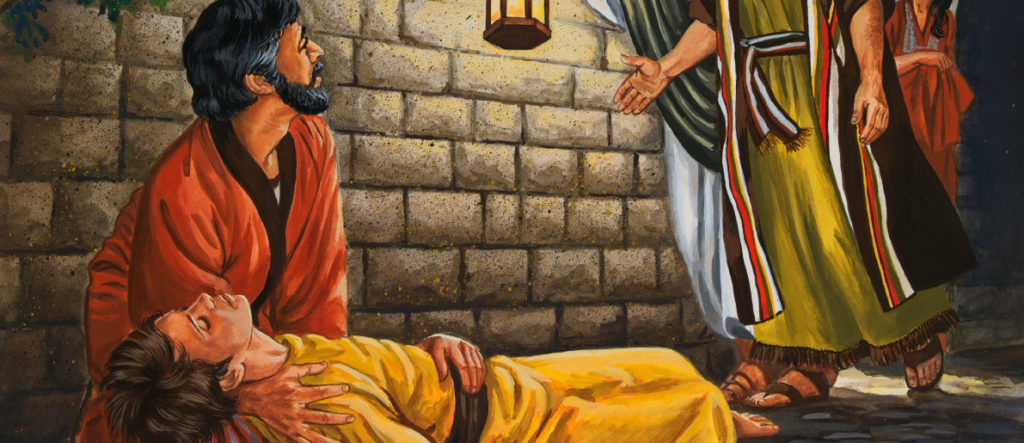
Eutychus Raises from the Dead at Troas
Paul and his companions then traveled to Troas (Acts 20:5). He ministered there again for a week. It was in Troas that a young man, Eutychus, was listening to one of Paul’s sermons and fell three stories out a window. When they found him he was dead on the ground, but Paul supernaturally restored life to this man (Acts 20:6-12).
After Troas, Paul’s companions went by ship to Assos, but Paul went by foot. Luke doesn’t tell us precisely why Paul did this. But what we do know is that distance from Troas to Assos was more than 30 miles through dangerous and mountainous terrain.
After meeting with his companions in Assos, they began their trek to Jerusalem. They made briefs stops in Chios and Samos, before arriving in Miletus (Acts 20:15).
Goodbye to the Ephesian Elders
It would make sense that Paul would have wanted to stop in Ephesus before heading to Jerusalem. considering the dear friends he had there, but he intentionally passed Ephesus because he wanted to be in Jerusalem by Pentecost, and he knew that traveling through Ephesus, and staying in Asia, would take much more time than he desired. In addition, he knew visiting Ephesus again could cause an uproar (Acts 20:13-16).
However, Paul did want to see his Ephesian friends and ministry partners, so when he arrived in Miletus, Paul called the elders from Ephesus to meet him there (Acts 20:17). In Miletus he encouraged the elders and commended them, letting them know that he would not be seeing them again since he knew that imprisonment and maybe death waited for him in Jerusalem. This was, no doubt, an emotional moment for Paul and his friends.
Paul had spent several years laboring with these men in ministry, and now he was saying goodbye for, what appeared to be, the last time. They wept and prayed together (Acts 20:17-38).
Sailing for Syria
From there, the apostle Paul and his companions then sailed towards Syria. They made brief stops in Cos, Rhodes, and Patara, before finally coming to Syria, landing at Tyre (Acts 21:1-3). Paul and his companions spent seven days with the disciples in Tyre. Through “the Spirit” they told Paul not to go onto Jerusalem, but Paul sensed that Jerusalem was the right place to go (Acts 21:4).
Then Paul and his companions went to Ptolemais (Acts 21:7), spending one day with the believers there, before heading onto Caesarea. There they were greeted by the believers there and they stayed with Philip the evangelist (Acts 21:8). While they were there, a prophet named Agabus came down from Judea and told Paul of the coming affliction he would face in Jerusalem (Acts 21:10-12).
Despite many people again urging Paul not to go to Jerusalem, Paul told them he knew what was instore and that he was ready to die.
Then Paul answered, ‘What are you doing, weeping and breaking my heart? For I am ready not only to be imprisoned but even to die in Jerusalem for the name of the Lord Jesus.’ —Acts 21:13
Paul and his companions then traveled to Jerusalem and was greeted by his brothers in Christ who lived there. He told the church there all God had been doing among the Gentiles (Acts 21:14-16). Once there, Paul visited with James and all the elders (Acts 21:17-18). He told them about all that God had done throughout the Gentiles.
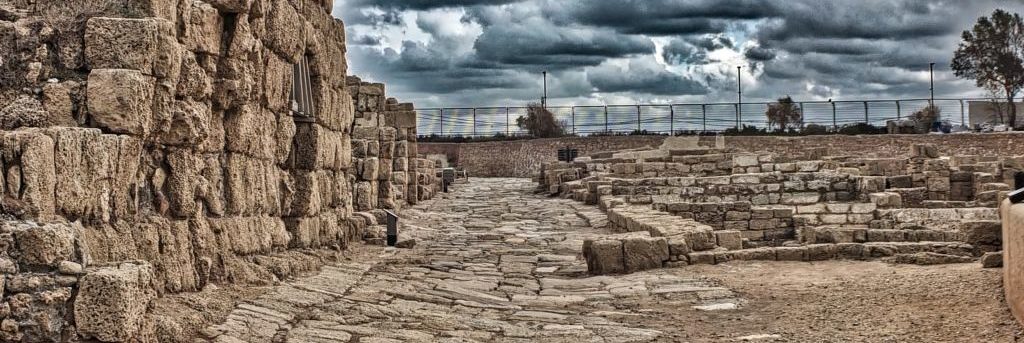
Arrested in Caesarea
While in Jerusalem, Paul went to the temple to worship and pray. While he was there, some Jews from Asia Minor stirred up trouble for Paul. They accused him of abandoning the one true God of Israel, of maligning the law of Moses, and of encouraging people to disobey the Jewish laws. Paul (obviously) denied this charge. This confrontation caused a riot in the temple. Paul was dragged out of the temple by a mob. The Romans then intervened and took Paul into custody (Acts 21:27-36).
Paul then addressed the crowd. He made it clear that he loved the law of God and that he had previously been a persecutor of Christians. But that he had become a preacher of the gospel after meeting Jesus on the road to Damascus. This caused another riot to erupt. The Romans then took Paul in their barracks. The Romans were going to flog him but Paul appeals to his own Roman citizenship (Acts 21:37-22:29).

On Trial Before Felix
Paul is taken to the Roman barracks in Caesarea. During this time the Roman governor over the region, Felix, brought Paul to trial. Ananias, the high priest, came from Jerusalem to bring charges against Paul. Felix gave Paul the opportunity to speak before the crowd. Paul shares his story and preaches truth. Felix was afraid of Paul’s message, so he doesn’t seemingly know what to do with Paul (Acts 23:23-35; 24:1-27).
Paul was imprisoned in Caesarea by the Romans for two years, but was given “some freedom” and his friends are allowed to visit him “to take care of his needs” (Acts 24:23).
On Trial Before Festus and Agrippa
When Festus became the governor of the region in 60 A.D. (or maybe earlier in 59 A.D.), he brought Paul back to trial. Some Jews came from Jerusalem again to bring charges against Paul, but they could not prove any of those charges (Acts 25:1-12).
King Herod Agrippa II visited with Festus. Festus asked him to hear Paul’s case. When Paul is called to defend himself, he gives one of his most famous defenses of the gospel and even encourages Agrippa to believe in Jesus (Acts 26:1-29). Agrippa famously responds, “Do you think that in such a short time you can persuade me to be a Christian?” (Acts 26:28). Paul says that he wants everyone to believe.
Festus calls Paul crazy (Acts 26:24), but both he and Agrippa agree that Paul had not done anything that might “deserve death or imprisonment” (Acts 26:31). Paul could have simply “been set free if he had not appealed to Caesar” (Acts 26:32). Paul had appealed to Caesar under his rights as a Roman citizen. This set into the motion the plans for Paul to be transported from Palestine to Rome to face trial in Caesar’s court.
Journey to Rome
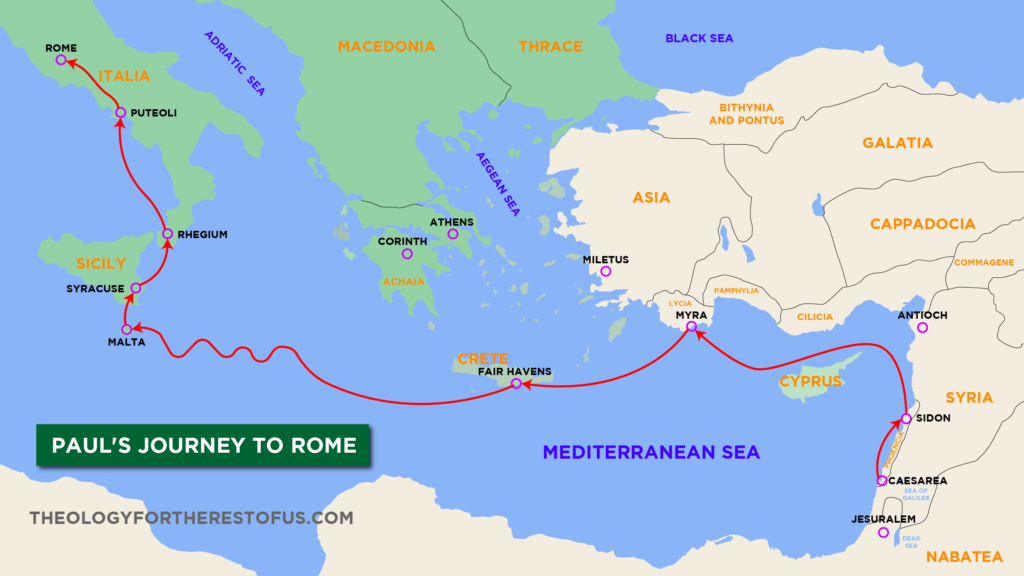
After his appeal to Rome, the apostle Paul is transported from Caesarea to Rome by ship under Roman guard (Acts 27:1-28:10). Some Bible scholars allude to this journey as Paul’s fourth missionary journey, but I don’t believe that’s the best or most accurate description for this trip.
Paul’s trip to Rome was tumultuous, filled with difficulties, including a shipwreck that caused him to be deserted on the island of Malta for three months. He also consistently faced belligerent resistance from people that opposed the gospel.
Paul and his companions eventually made it to Rome, sometime around 61 A.D. (or maybe somewhat earlier). When Paul arrived in Rome, he was placed under house arrest for two years.
Paul lived in a rented house where he served his house arrest. There he is able to visit with friends and preach the gospel to those who visit. During this time he also writes several letters that are now in the New Testament, including Philippians, Ephesians, Colossians, and Philemon.
The book of Acts ends there, with Paul under house arrest in Rome (Acts 28:11-31).
Paul’s Fourth Missionary Journey
The fourth missionary journey is not outlined in the narratives of Scripture. And there are some scholars that question whether such a journey ever really happened (we’ll cover that a bit more later in this article).
We don’t have a clear picture of what happened next in Paul’s life, after he was released from house arrest. But by carefully examining Paul’s epistles, I’m confident we can piece-it-together.
The early church father and historian Eusebius (writing in the 4th century) recorded that the most prominent church tradition had been that Paul was released from Roman house arrest and then re-arrested several years. According to this tradition, Paul’s second arrest eventually led to his martyrdom under the direction of Emperor Nero (see H.E. 2.22.6 ).
Also, Paul’s later letters (1 & 2 Timothy and Titus), commonly referred to as the Pastoral Epistles, are clearly written after the events of the book of Acts. In those letters Paul makes comments about his travels and plans. Paul is likely released from house arrest sometime around 63 A.D.
During his house arrest in Rome, Paul was clearly making plans to travel eastward. He asks Philemon to prepare a guest room for him (Philemon 22) and tells the Philippians that he intends to visit them (Phil. 2:24). Paul doesn’t strike me as the type of guy that would make plans in vain. Paul anticipated his release from house arrest.
These plans to go east make perfect sense. Paul’s habit was to go back and encourage the churches that he had previously established. That’s what he’d done on previous journeys.
Then, in 2 Timothy, written much later in life, during Paul’s second imprisonment, Paul mentions and alludes to people and moments that are connected to his post-Roman arrest ministry travels through Asia. He’s sort of looking back on past events and correspondences. Paul mentions:
- Having a significant dispute with some believers in Asia, including Phygelus and Hermogenes (2 Tim. 1:15)
- Receiving help from Onesiphorus (2 Tim. 1:18)
- Having been with Carpus at Troas (2 Tim 4:13-14)
- Being confronted by Alexander the coppersmith (2 Tim. 4:14)
- Needing to leave Trophimus in Miletus because he was ill (2 Tim 4:20)
All of these events happened after Paul’s release from Roman house arrest.
Paul says in 2 Timothy 4:20 that “Erastus remained at Corinth.” This is a clear statement that Paul had been in Corinth; he knew Erastus was there because he had first-hand knowledge, having recently visited the city.
In Titus 3:12, Paul invites Titus to join Paul in Nicopolis. Paul tells Titus that he plans on spending the winter in Nicopolis, a city in Achaia. Clearly, when Paul writes the letter to Titus he is already in Achaia or somewhere very close, hoping for Titus to meet him there.
In Paul’s letter to Titus, he alludes to having been in Crete and having left Titus in charge to help those churches flourish.
A few scholars have argued that Paul did ministry in Crete when he was shipwrecked there. Paul had been briefly shipwrecked in Crete while traveling from Caesarea to Rome, before his Roman house arrest (Acts 27).
However, Paul and the men from the shipwreck were in Crete just a short while. As we examine the events of the shipwreck, as they are described in the book of Acts, we see that Paul would not likely have had the opportunity to establish churches in the region during such a short period. Also, they didn’t travel throughout the island at all.
What seems much more likely is that Paul eventually made it back to the island of Crete, spend time preaching, establishing churches throughout the region, and that upon his departure Paul left Titus there to “complete [their] work there and appoint elders in each town” (Titus 1:5).
At the beginning of 1 Timothy Paul says “when I was going to Macedonia” (1 Timothy 1:3). When we examine this letter, we get the sense that he’s referring to events in the not-too-distant past. Seems likely Paul is referring to the moment when he had traveling to Macedonia after being released from Roman house arrest. After his time spent in Macedonia, he may have headed back to the church in Ephesus, which he asserted was his plan (1 Timothy).
Doubts about the Fourth Journey
There are clearly some comments in Paul’s letters that do not easily square with the events of the book of Acts, which means that those comments in his letters point to some missionary work that happened after Paul’s Roman house arrest.
However, a few scholars have argued that there’s significant (enough) overlap in the locations, types of events, and even the people mentioned during Paul’s first three journeys, therefore it’s hard to say for sure—they claim it’s possible that much of those things that do not seem to square with the events of the book of Acts can still potentially be things that happened on one of his first three missionary journeys.
Also, some scholars have sought to remind us that the apostle Paul spent long periods of time in some locations (like 18 months in Corinth and 3 years in Ephesus), and they’ve asserted it’s possible that many unrecorded things may have happened during those long stays, implying that those longer stays in those locations could account for some of the comments in Paul’s epistles.
These scholars claim there’s so much that we do not know about those time periods, that it’s entirely possible all of the events alluded to by Paul, in his own letters, took place during his first three journeys.
I happen to be confident that Paul did indeed take a fourth missionary journey, after his release from his Roman house arrest. I think that’s the best interpretation of the data we have. However, I also realize that there are some good New Testament scholars that don’t find the evidence as compelling as I do.
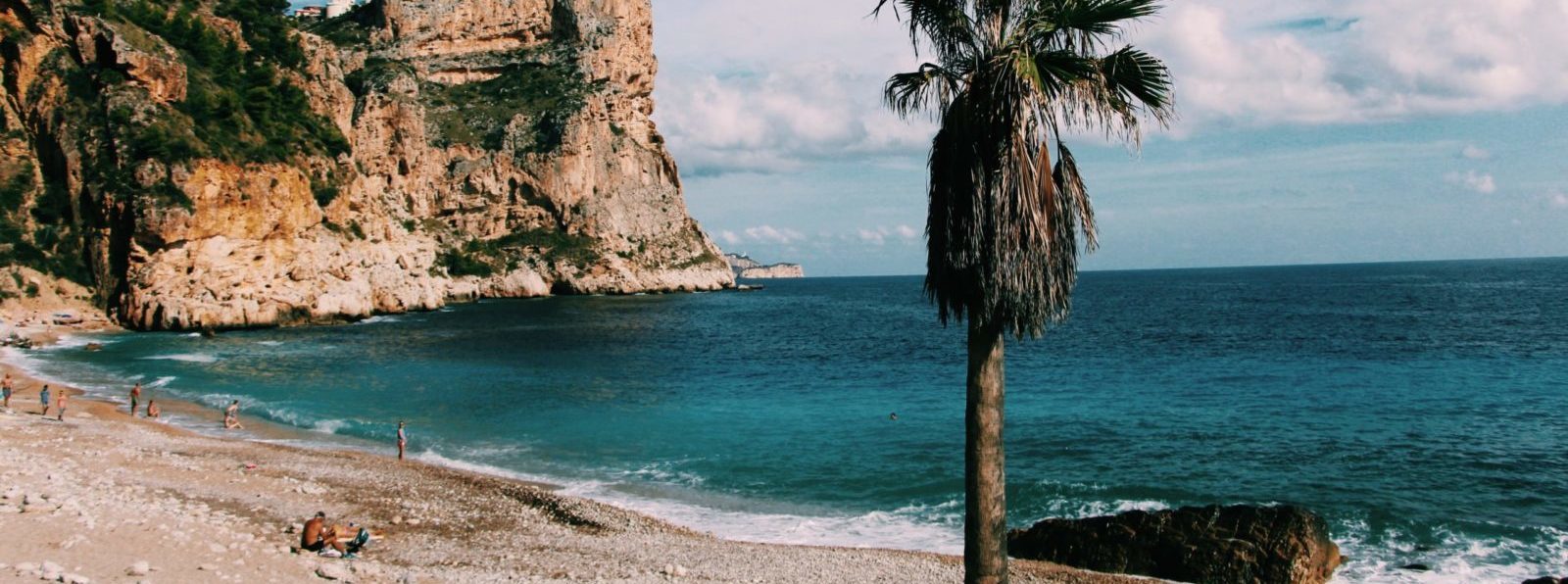
Potential Travel to Spain
Did Paul ever make it to Spain? We know from Scripture that the apostle Paul had a desire to preach in Spain (Rom. 15:22-29). After being released from Roman house arrest, he could have easily sailed westward.
Clement of Rome (writing in 95 A.D.) says that Paul had traveled and preached in “the farthest limits of the West” (1 Clement 5:5-7). This sort of language could have described a location west of Italy, such as Gaul or Britannia, but most scholars seem to think this describes Spain. However, it is also possible that Clement was speaking more broadly (or generically), referring to Paul traveling far westward from his home region, going from Palestine through much of the heart of the Roman Empire and eventually all the way to Rome. This latter interpretation seems odd to me.
The Muratorian fragment (written in apx. 170 A.D.), seems to affirm Paul’s missionary journey to Spain too, but some scholars question this; just because someone in the mid-to-late second century believed it doesn’t necessarily equate to strong evidence. However, this shows that church tradition was handing this down through the generations.
Paul’s missionary trip to Spain is also mentioned by Cyril of Jerusalem (313-386) and John Chrysostom (347-407).
There may not seem to be many significant (quality) pieces of evidence that corroborate the idea that Paul made it all the way to Spain, and there are not any comments in Paul’s later letters that point to him ever making it to Spain either. However, these extrabiblical evidences seem compelling. It’s possible that a trip to Spain may have been the first leg of Paul’s fourth missionary journey.
Paul Beheaded by Nero
In his second letter to Timothy, Paul mentions his “first defense” and says he was “delivered from the lion’s mouth” (2 Tim. 4:16-17). Most biblical scholars believe this is a reference to the first time he was in Caesar’s court, defending himself, eventually leading to his Roman house arrest (Acts 28).
Paul was released from his first Roman arrest, but there wouldn’t be a second release. Paul eventually ended up back in Rome. The second time, it wasn’t house arrest. It was a real Roman jail. This was most likely part of Nero’s persecution of Christians in the mid 60s. This was one of the most brutal times of persecution in Christian history.
When much of the city of Rome burndown in 64 A.D., Emperor Nero blamed the Christians. The emperor later requested that the apostle Paul be arrested and chained. It appears that Paul was arrested somewhat abruptly and unexpectedly, evidenced by the fact that he was not able to secure his cloak and his Old Testament parchments; Paul later requested that these be brought to him (2 Tim. 4).
Paul likely penned 2 Timothy during this second Roman imprisonment. Paul was beheaded shortly after he wrote 2 Timothy. Some scholars have concluded that Paul was killed as early as 64 A.D., but it is more likely that he was executed sometime between 67 A.D. and 68 A.D.
The legacy of the apostle Paul is second to none in Christian history. He is the greatest missionary evangelist the world has ever seen. Paul was a man on mission, focused on spreading the gospel and planting churches.
Paul was a man so impacted by Jesus, so compelled by God’s love, so humbled that the Messiah would choose him to be an ambassador, that he was willing to endure much pain and hardship to see others come to faith in Jesus Christ.
Featured illustration of Paul in prison courtesy of britannica.com. Images of the jails in Philippi and Caesarea courtesy of missionbibleclass.org. Illustration of Eutychus’ death courtesy of gfbtkingdomkids.com.
Recommended Resources:
“Handbook on Acts and Paul’s Letters” (by Thomas R. Schreiner)
“Paul: A Biography” (by N.T. Wright)
“Acts: An Expositional Commentary” (by R.C. Sproul)
“Dictionary of Paul and His Letters” (more than 100 contributors, edited by Gerald Hawthorne, Ralph Martin, and Daniel Reid)

Kenneth E. Ortiz (Th.M.) is Lead Pastor of Horizon City Church . He has 15+ years of vocational ministry experience. Kenneth previously served as a professor at Bethlehem College and adjunct faculty at Spurgeon College . Kenneth lives in Minneola, FL with his wife Malaina, they have two kids.
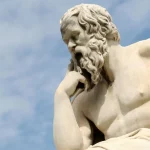

- Find Your Educational Consultant
- Review Our Catalogs
- Catholic Resources
- Scripture and Tradition
- Jesus and the New Testament
- Saint Paul and the Epistles
Paul’s Journeys
Paul traveled over 10,000 miles proclaiming the gospel of Jesus Christ. His journeys on land and sea took him primarily through present day Israel, Syria, Turkey, and Greece. Paul walked the roads built by the Romans to facilitate their control over their Empire. Travelers took to the roads in as large a group as they could find. There was constant danger of bandits. They hurried to get to the next wayside inn for shelter and whatever food might be available.
Traveling by sea was not comfortable. There were no cabins for travelers. They had to find a place on the deck exposed to sun, winds, and rain. Paul’s trade as a tentmaker probably held him in good stead, as he could fashion shelter for himself and his companions on the deck.
In 2 Corinthians 11: 25 – 27 Paul describes some of the dangers of traveling.
25 … three times I was shipwrecked, I passed a night and a day on the deep; 26 on frequent journeys, in dangers from rivers, dangers from robbers, dangers from my own race, dangers from Gentiles, dangers in the city, dangers in the wilderness, dangers at sea, … 27 in toil in hardship, through many sleepless nights, through hunger and thirst, through frequent fastings, through cold and exposure.
[Click on any of the images below to view a larger version.]
Paul’s First Journey
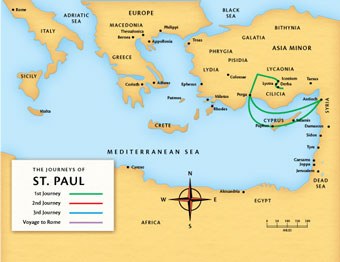
In response to a call of the Holy Spirit, the church in Antioch chose Barnabas and Paul to proclaim the gospel. They first traveled to Cyprus, then to Antioch in Pisidia, a city in present day west central Turkey. They then went to Iconium, Lystra and Derba. They then returned through Perga to Antioch. When they stopped in each city, they went to the synagogues to preach the coming of Jesus Christ, the messiah as the fulfillment of the promises made in the Old Testament.
Paul’s Second Journey
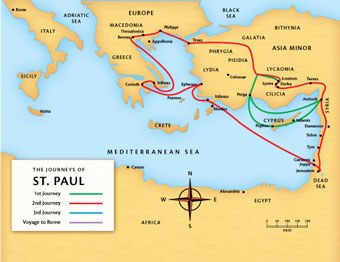
Barnabas and Paul separated over a disagreement (Acts 15: 36 – 40). Barnabas returned to Cyprus. From Jerusalem Paul went overland to revisit the churches in Lystra and Iconium. On this trip Paul had a dream calling him to bring the gospel to Macedonia. He crossed the Aegean Sea to present day Greece. He traveled down the east coast of Greece. Stopping in Athens, Paul attempted to proclaim the gospel in Athens, where he was met with polite indifference (Acts 17: 16 – 32). He then went to Corinth where he established a church that would give him both great joy and pain (see 1 and 2 Corinthians). Traveling back through Ephesus where his successful teaching won many to Christ to the annoyance of the local charm dealers (Acts 19: 21 – 40). Paul returned to Antioch by way of Jerusalem.
Paul’s Third Journey
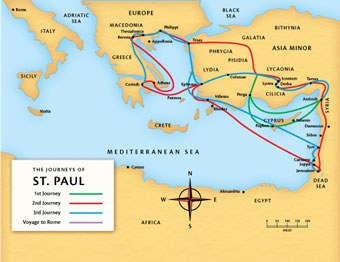
On his third and longest journey Paul went overland through present day Turkey then across the Aegean Sea to Greece. This was a pastoral journey revisiting the churches he had founded to strengthen them and give them further instruction. While in Ephesus Paul heard a prophecy that should he return to Jerusalem he would be imprisoned. The churches he visited pleaded to him not to go. But Paul felt called by Christ to continue to meet whatever God willed for him.
Paul’s Journey to Rome
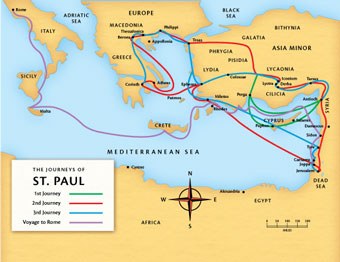
In Jerusalem Paul was arrested and accused of violating the sacred grounds of the Temple. (Acts 21: 27 – 36). He was saved from being beaten to death when the Roman tribune intervened and brought him to the barracks. In defending himself Paul claimed his right as a Roman citizen to appeal his case to the Emperor. He was then sent to Rome to have his case resolved.
Luke ends the Acts of the Apostles with Paul’s arrival in Rome. From Rome the gospel would be proclaimed throughout the world.
Related Links
The spirit of truth, a brief look at st. paul’s life and teachings, may crowning, pope john paul ii and his message of forgiveness, about the ten commandments.

Paul’s Second Missionary Journey: Key Points, Maps, And Lessons
Categories Bible Study Topics
In this article, we will explore Paul’s second missionary journey looking at key points, locations, lessons we can learn, and a map of his journey.
In the book of Acts, we read the story of the beginning of the early church and the role the apostles played. One prominent character in the book of Acts is Paul, who first persecuted the church, but became a significant role player in evangelizing the gospel and undertook several missionary journeys. Let’s consider some key points and lessons from his second journey.
We read all about Paul’s second missionary journey in Acts 15:36-18:22. Although the purpose of the journey was originally to revisit the new believers from his first journey, Paul was led by the Holy Spirit to avoid Asia and rather preach the gospel in new areas, especially Greece.
The primary purpose of any missionary journey is to reach and save the lost, and Paul’s second missionary journey was no exception. Paul preached the gospel to many people and even debated the gospel with Greek philosophers in Athens.
He saw the salvation of many across the European continent. Paul and Silas, his companion on this journey, were also imprisoned during the journey.
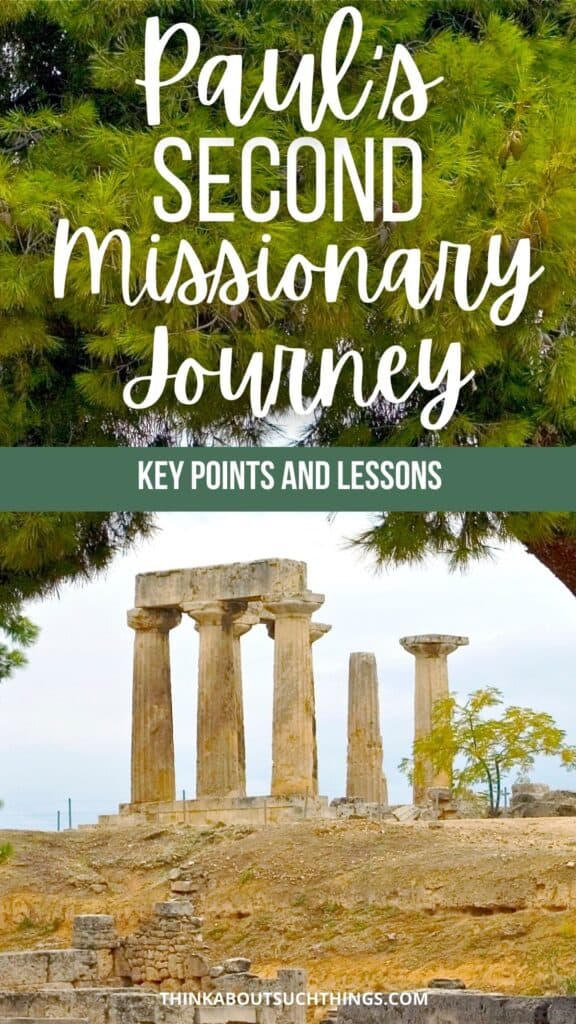
Before we get started, I do want to give a big thank you to Free Bible Images for letting me use their images of Paul’s journey.
What Happened On Paul’s Second Missionary Journey?
Paul’s second missionary journey lasted approximately 3 years, from 49 – 51 AD. After his first journey, he spent over a year in Antioch before setting out again. Paul asked Barnabas to accompany him, but a disagreement on whether Mark should join them led to them parting ways.
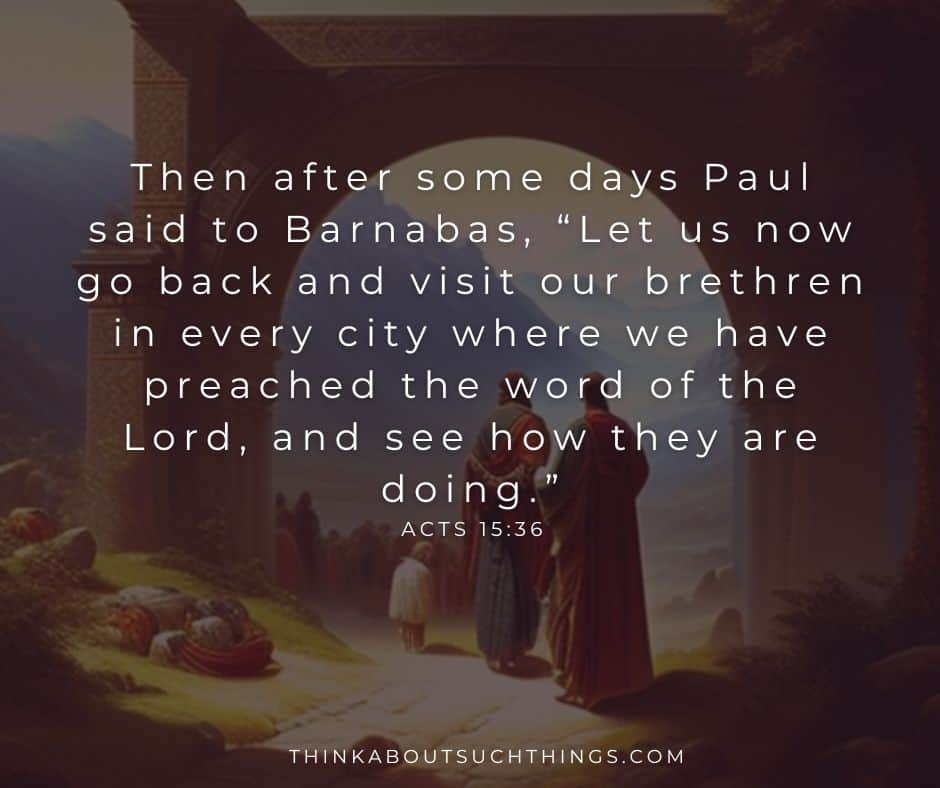
Therefore, Paul took Silas on this journey, along with others who joined him. As for Barnabas, him and Mark sailed to Cyprus to minister to the believers that they brought to Christ in Paul’s 1st missionary journey.
During their second missionary journey, Paul and his team visited many towns that had originally visited on their first journey. In this second round, many Jews and gentiles converted to Christianity.
A key thing to note is that Paul first met Timothy in Lystra. This young believer joined Paul and Silas. As the son of a Greek father and Jewish mother and being uncircumcised, Timothy was regarded as disrespecting his Jewish heritage by the Jews.
For this reason, Paul circumcised him, despite it being agreed that gentiles did not need to be circumcised to be Christians.
They traveled through Tarsus, Derbe, and Lystra, from where they headed to Troas.
In Troas, Paul’s original goal of revisiting the churches planted during his first missionary journey was altered. The Holy Spirit closed a door and prevented Paul from speaking in Asia and, through a vision, led the team to Macedonia, in the north of Greece.
In Philippi, the team went to the riverside on the Sabbath, where the Jews would meet. There they found a wealthy merchant who sold purple cloth named Lydia , who accepted the gospel. Lydia and her family converted to Christianity. The team stayed with her in her home for a while.
While still in Philippi, Paul freed a slave girl of a demon, used by her owners to generate an income through fortune telling.
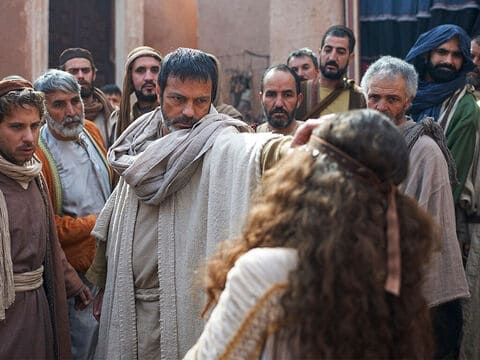
When the owners realized this, they took them to the magistrate, who had them flogged and imprisoned. At midnight in prison, while praying and singing psalms, an earthquake opened the prison doors and released their bonds!
When the prison guard noticed the doors were open, he thought all the prisoners had escaped and wanted to commit suicide. However, Paul spoke to him and told him they were all still there. The guard asked about their God, and Paul witnessed to him. The guard and his family believed and were baptized.
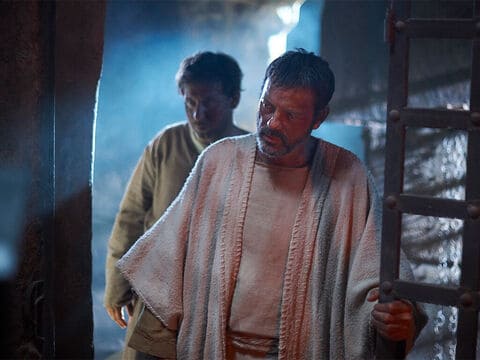
When they were released, Paul and Silas refused to leave until they received an apology from the town leaders. The leaders were shocked and came down to personally escort them out of town after learning they were Roman citizens. As Roman citizens, Paul and Silas were entitled to a trial before flogging and imprisonment.
Thessalonica
And some of them were persuaded to believe and joined Paul and Silas, along with a large number of the God-fearing Greeks and many of the leading women. – Acts 17:4 AMP
After their release from prison, Paul and his team traveled through Amphipolis and Apollonia to Thessalonica.
In Thessalonica, Paul and Silas preached the gospel to the Jews, but several refused to accept it. They also preached to gentiles and women, many of whom believed, infuriating the Jews. These non-believers then started a mob against them, which caused them to flee to Berea.
It is said in Acts 17 that the Bereans were nobler in character than the Thessalonians. Because they took what Paul said and went and examined the Scripture. They found what Paul was saying was true, and because of that man, Jews and Greeks were saved.
But word got out to those who caused problems in Thessalonica and went to Berea to stir up a mob there as well. Because of that, they sent Paul away to the coast, where he headed to Athens.
Silas and Timothy didn’t accompany him but stayed in Berea.
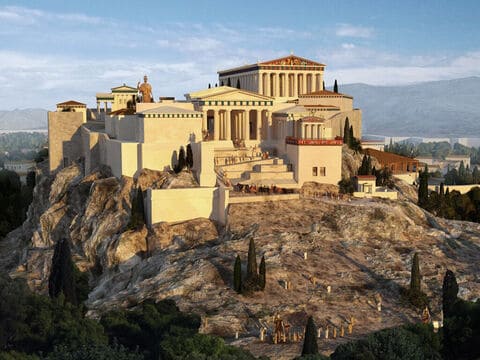
In Athens, Paul gave a famous speech to the Athenians at the Areopagus or the Hill of Ares. He had been preaching in the synagogues and marketplaces of Athens, where he had encountered some Epicurean and Stoic philosophers who were intrigued by his teachings.
They invited him to speak at the Areopagus, which was a place where philosophers and intellectuals would gather to discuss ideas.
In his speech, Paul spoke about the unknown God whom the Athenians had erected an altar to, and explained that this God was the one true God who had created everything. He also spoke about the resurrection of Jesus, which was a new and controversial idea to the Athenians.
While some Athenians were interested in what Paul had to say, others mocked him and dismissed his teachings. After his speech, Paul left Athens and continued on his journey.
Now the Lord spoke to Paul in the night by a vision, “Do not be afraid, but speak, and do not keep silent; 10 for I am with you, and no one will attack you to hurt you; for I have many people in this city.” 11 And he continued there a year and six months, teaching the word of God among them. – Acts 18:9-11 NKJV
Paul spent a significant amount of time in Corinth during his Second Missionary Journey. He arrived in around 50 AD, and stayed there for approximately 18 months, which made it one of the longest periods he spent in any one place during his missionary journeys. Silas and Timothy meet up with him there as well.
In Corinth, Paul worked as a tentmaker during the day and preached in the synagogues on the Sabbath. He was able to gain the support of some of the Jewish community in Corinth but also faced opposition from others who were resistant to his message.
One of the most significant events during Paul’s time in Corinth was his church establishment there. He worked closely with several other individuals, including Aquila and Priscilla, who became important figures in the early Christian church.
Paul faced many challenges during his time in Corinth, including physical threats and opposition from local authorities. Despite these challenges, however, he was able to establish a strong Christian community there and continued to spread the gospel throughout the region.
From there, they sailed to Ephesus, leaving Aquila, Priscilla , and Apollos there. Then returned to Caesarea and Jerusalem before returning back to Antioch in Syria.
Check Out The Other Missionary Journeys Of Paul

Maps of Paul’s 2nd Missionary Journey
As you can tell, Paul’s second journey is longer than his first, with LOTS of stops. We have covered the major events in these cities, but seeing a map is always nice. It helps give you a visual of where he and his team went.
Down below, you will find a map of Pauls’s 2nd journey route.
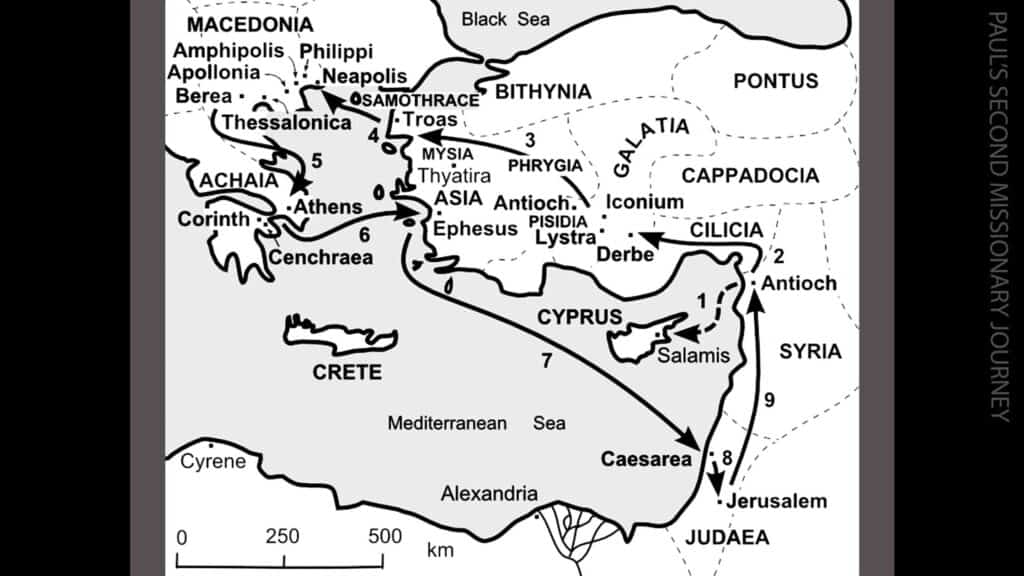
This map below gives you a nice overview of where key locations were in the Aegean sea .
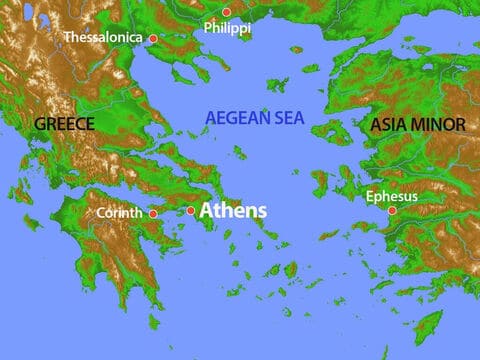
Key People On Paul’s 2nd Journey
Now, let’s take a look at the key players on this trip:
Paul, also known as Saul of Tarsus, was one of the most influential leaders in the New Testament. He was born a Jew and was a Pharisee. He later converted to Christianity after experiencing a vision of Jesus Christ while on his way to Damascus.
Paul played a crucial role in spreading the teachings of Christianity throughout the Roman Empire and authored many of the epistles or letters found in the New Testament. He faced numerous challenges and persecution as he traveled to various cities to share his faith.
Silas was a Jewish leader in Jerusalem and played an important role in the early Christian church. Silas was known for his eloquent speaking and persuasion skills, which made him a valuable asset to the apostle Paul on his missionary journeys.
Timothy is a young and faithful disciple of Paul, who played a significant role in spreading the gospel message throughout the ancient world. As an important figure in the early Christian church, Timothy was mentioned frequently in Paul’s letters to the Corinthians, Philippians, and Thessalonians, where he was described as a trusted co-worker and a dedicated leader.
Priscilla and Aquilla
Priscilla and Aquila were a couple who played a prominent role in the early Christian community. They are mentioned several times in the New Testament, including in Acts and Romans. Priscilla is believed to have been a Jewish woman from Rome, while her husband Aquila was likely of Jewish and Greek heritage.
Together, they were tent makers and worked alongside the Apostle Paul in his ministry. Priscilla and Aquila not only supported Paul financially, but they also taught and mentored other believers. Their partnership in both work and ministry sets an excellent example for couples and demonstrates the significant impact a husband and wife can make together in serving God.
Luke was a physician and companion of the apostle Paul. He was also one of the four Gospel writers, along with Matthew, Mark, and John. He also wrote the book of Acts.
FAQ About Paul’s Second Missionary Journey
You can read about the Apostle Paul’s second journey in Acts 15:36-18:22.
The second journey took place between 49-51AD.
It varies throughout the journey, but Silas, Timothy, Priscilla, and Aquilla accompany the apostle Paul.
Paul and his companions traveled through Syria, Turkey, Greece, and Jerusalem.
Paul traveled around 2,800 miles, making his first journey of 1,400 look like a cakewalk!
Important Lessons From Paul’s Second Missionary Journey
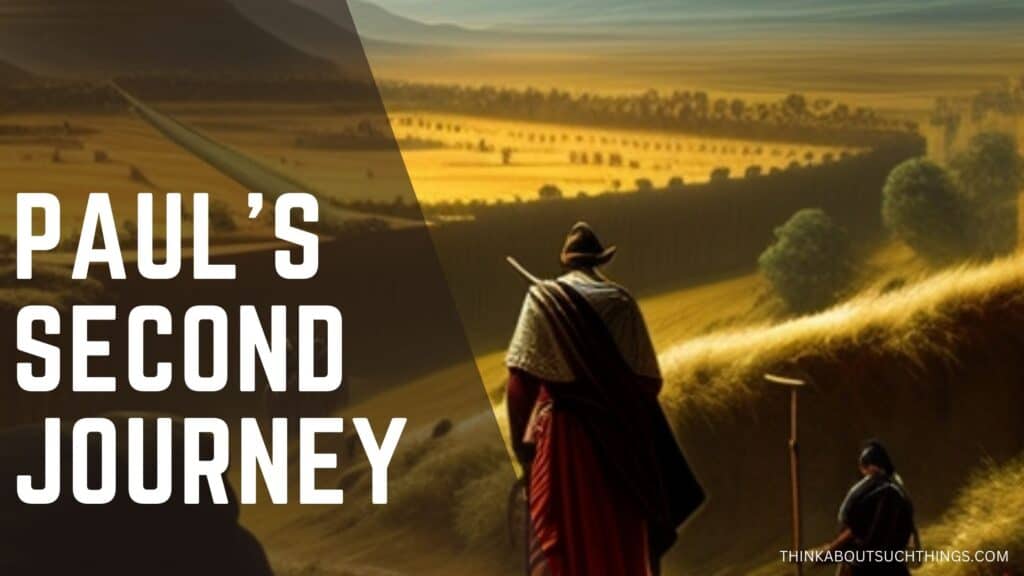
There are many lessons that Christian believers can learn from Paul’s life and letters. But here are few that I have found while studying his second journey.
- Consideration for the beliefs of fellow Christians – Through the circumcision of Timothy, Paul shows that Christians should consider the beliefs of fellow Christians to be able to evangelize to them. Although the circumcision was unnecessary, Timothy would not have been able to preach in the synagogues if he wasn’t circumcised, thus enabling him to reach more people.
- Be open to the prompting of the Holy Spirit – If Paul weren’t open to the prompting of the Holy Spirit and stuck to his original plans, many people who came to faith in Christ would not have been reached. As Christians, our plans should always be subjected to the will and plans of God.
- Praise God in all circumstances – Paul and Silas prayed and worshipped God while imprisoned. Christians are also encouraged to be steadfast in prayer (Colossians 4:2) and to praise God in all circumstances (1 Thessalonians 5:16-18).
- Always look out for persons to evangelize – As Paul traveled, he preached the gospel to whoever was prepared to listen. He preached the gospel to the prison guard in Philippi, saving his whole family, and even debated Christianity with Greek philosophers in Athens.
- Be prepared to do the right thing, even if it would cost you your freedom – Paul must have known that driving the fortune-telling demon out of the slave girl in Philippi would upset her owners, but he was prepared to do the right thing, even if it would land him in prison.
- We can talk to anyone about Jesus – Paul’s time in Athens is significant because it illustrates how he adapted his message to different audiences and engaged with people of different cultures and beliefs. Even though it was hard ground Paul was willing to try to reach the Greeks.
On Paul’s second missionary journey from 49-51 AD, he set out to revisit the churches planted during his first missionary journey. The Holy Spirit led him in a different direction, and he ended up preaching the gospel to multitudes in and around Greece and saw the salvation of many. Paul, with his resilience and connection to the will of God, is an excellent example to Christians today.
If you would like to leave me a comment below I would love to hear from my readers!
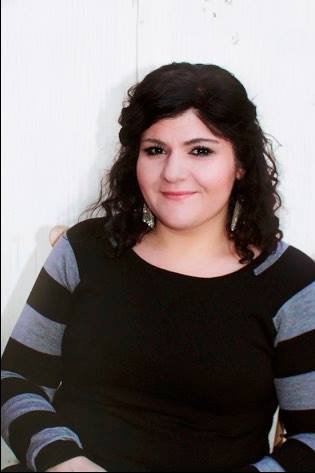
Melissa is a passionate minister, speaker and an ongoing learner of the Bible. She has been involved in church and vocational ministry for over 18 years. And is the founder of Think About Such Things. She has the heart to equip the saints by helping them get into the Word of God and fall more in love with Jesus. She also enjoys family, cooking, and reading.
She has spoken in churches in California, Oregon, Texas, and Mexico and has been featured in Guidepost Magazine and All Recipes Magazine. Read More…
I accept the Privacy Policy

Paul’s First and Second Missionary Journeys
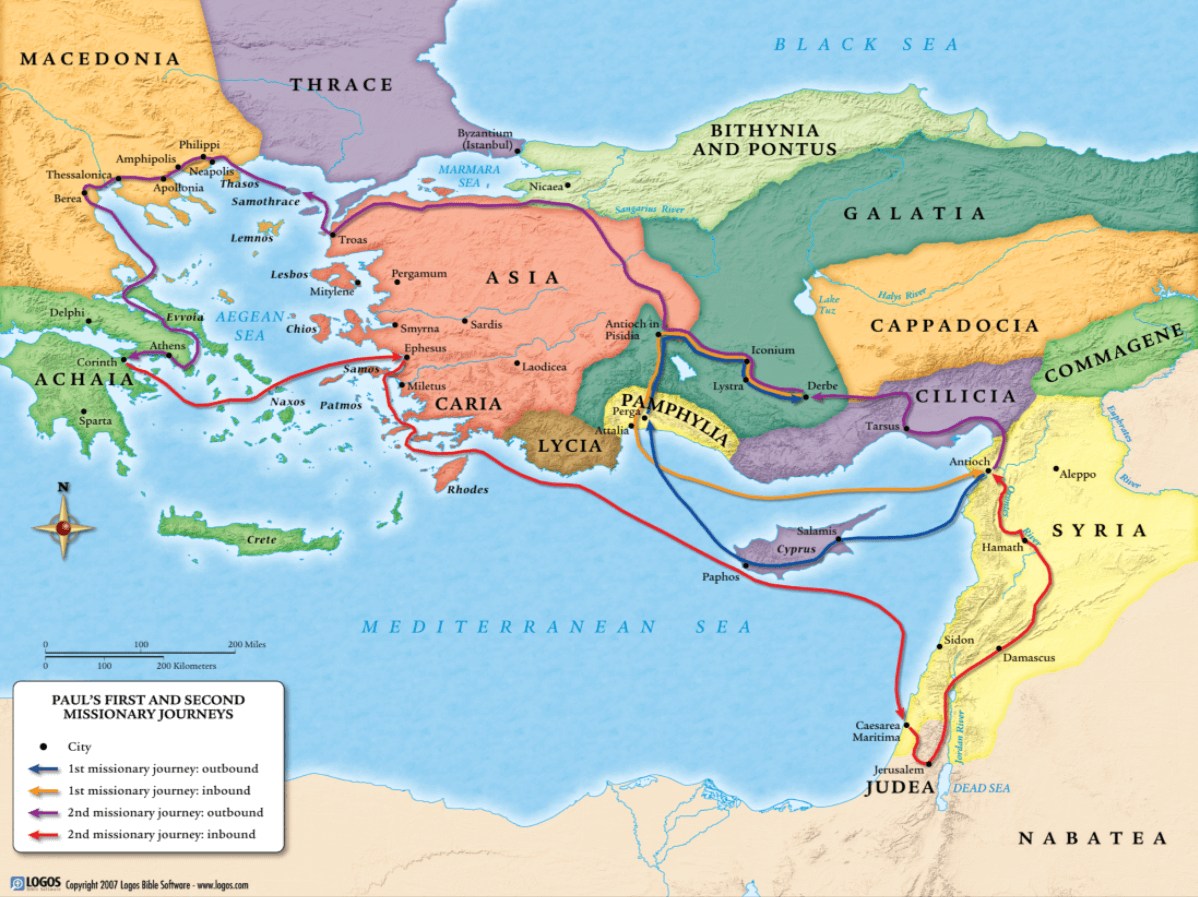
Paul and Barnabas set out from Antioch to Seleucia, where they set sail for the island of Cyprus.
Once Paul and Barnabas arrive on Cyprus, they begin to proclaim the Word of God in the Jewish synagogue. John Mark was with them as a helper.
Traveling through the whole island, they arrive at Paphos where they are opposed by a Jewish sorcerer called Elymas. The Lord causes Elymas to be blind, and Paul and Barnabas sail to Perga.
In Perga, John Mark leaves Paul and Barnabas and goes to Jerusalem. Paul and Barnabas then head for Pisidian Antioch.
In Pisidian Antioch, Paul stands up and delivers a sermon in the synagogue, prompting the people to invite him and Barnabas back the following week. However, the next week they are opposed by jealous Jewish leaders, who eventually convince the people to expel Paul and Barnabas. They declare they will turn their mission efforts to the Gentiles (non-Jews).
Arriving at Iconium, Paul and Barnabas once again speak in the synagogue. With the city divided on their teachings, Paul and Barnabas find out about a plot to stone them and leave the city for Lystra and Derbe.
In Lystra, Paul heals a man who was lame from birth. When the crowds see what Paul does, they hail him and Barnabas as Greek gods and try to sacrifice to them. However, after Jews in the city incite the people against Paul and Barnabas, they stone Paul and drag him outside of the city, assuming he is dead. The next day, he and Barnabas depart for Derbe.
Paul and Barnabas preach the Word of God successfully in Derbe, and then head back to the cities they had already visited to strengthen the brothers and sisters in each city before they return to Syrian Antioch. They also appointed elders in each city who would continue to guide and strengthen the family of believers.
Paul and Barnabas return to Lystra to encourage the believers there on their way to Iconium.
Paul and Barnabas return to Iconium to encourage the believers there on their way to Pysidian Antioch.
Paul and Barnabas return to Pysidian Antioch to encourage the believers there on their way to Perga.
Paul and Barnabas preach the Word in Perga, then set sail from Attalia back to Syrian Antioch.
Paul and Barnabas completed the First Missionary Journey in the late 40s AD. It does not appear that they spent much time in the cities they visited, so the entire journey could have been done in about a year and a half. Between the First and Second Missionary Journeys, Paul writes his letter to the Galatians (most likely the churches he visited on the First Journey) and also travels to Jerusalem for the Jerusalem Council around 49 AD (see Acts 15). Some time later, Paul and Barnabas decide to conduct a Second Missionary Journey, but they disagree as to whether they should bring John Mark with them again because he left them early on the First Journey. They split, with Barnabas taking John Mark and traveling to Cyprus, while Paul takes Silas and travels through Syria and Cilicia on their way to Derbe, thus beginning the Second Journey.
Paul travels from Derbe to Lystra, where he meets a young man named Timothy. Everyone in the surrounding towns spoke well of him, so Paul has him circumcised and brings him along on the journey. As he travels through Galatia, he delivers the decisions made at the Jerusalem Council and strengthens each church in the region on his way to Asia.
Paul and his companions were kept from preaching the gospel in the province of Asia by the Holy Spirit, so they head north toward Bithynia.
Luke tells us in Acts that “the Spirit of Jesus would not allow them” to enter Bithynia, so Paul and his companions head west to Troas.
While in Troas, Jesus’ plan for them on this journey is revealed to Paul in a vision. In the vision, Paul sees a man from Macedonia begging him, “Come over to Macedonia and help us.” Due to the abrupt change from third person to first person pronouns, it is also believed that this is where Luke, the physician and author of the Gospel of Luke and Acts, joins Paul and his other companions. In response to Paul’s vision, they all set out for Samothrace and Neapolis on their way to Philippi in Macedonia.
At Philippi, Paul and his companions meet a woman named Lydia who was a worshiper of God. After baptizing her and the members of her household, they accept an invitation to stay at her house while they were in Philippi.
Later, Paul and those with him were followed by a girl who had a spirit that allowed her to predict the future. For many days she would follow them and say, “These men are servants of the Most High God, who are telling you the way to be saved.” Paul eventually got annoyed and commanded the spirit to come out of the girl in the name Jesus Christ. The men who used the girl’s telling the future to make money were upset and had Paul and Silas thrown in prison.
While they were in prison, an earthquake shook the foundations of the prison and the prison doors and chains were all opened. With the jailer about to kill himself in fear of punishment from his superiors, he asks Paul and Silas what he must do to be saved. They tell him, “Believe in the Lord Jesus, and you will be saved—you and your household.” The jailer invited them over to his house, and that night he and his whole household believed and were baptized.
The next day, Paul and Silas were released from prison and left the city with the rest of their companions.
Paul and his companions travel to Thessalonica, where Paul spends three Sabbaths in the synagogue proclaiming Jesus as the Messiah. A number of Jews and Greeks believed, but some Jews became jealous and started a riot in the city. Looking for Paul at the house of a man named Jason, they dragged Jason and some other believers before the city officials. The officials made Jason and the others post bond, while Paul and his companions were sent away by the believers during the night.
When they arrive at Berea, according to their custom they enter the synagogue and begin preaching about Jesus. The Berean Jews are much more open to their message than the Thessalonicans were, so they examine the Scriptures every day to verify what Paul was saying about Christ.
The Jews in Thessalonica find out that Paul is in Berea and send people to agitate the crowds in the city. The believers in Berea then send Paul to the coast and eventually Athens, but Silas and Timothy stay behind.
While Paul waits for Silas and Timothy to join him in Athens, he reasons with the Jews in the synagogue as well as the Greeks in the marketplace that Jesus is the promised Messiah. Some philosophers bring him to a meeting of the Areopagus, a council of city elders and leaders, and have him explain this “new teaching” of Jesus as the Messiah. This is where Paul delivers his famous sermon using an Athenian altar inscription to an “UNKNOWN GOD.” Paul explains to them that the one, true God does not live in temples and that he has raised Jesus from the dead to prove that he is the Savior of the world. After some believe, Paul then travels to Corinth.
When Paul arrives in Corinth he meets a Jew named Aquila and his wife, Priscilla. Since they are tentmakers as he is, he stays and works with them, preaching Jesus as the promised Messiah each Sabbath in the synagogue. When Timothy and Silas arrive, Paul then dedicates his whole time to gospel ministry. With the Jews denying his message, he concentrates reaching out to the Gentiles (non-Jews). After Jesus appears in a vision to Paul and tells him to keep preaching in Corinth, he stays there for a year and a half. During this time, Paul writes the letters we know as 1 and 2 Thessalonians to the church he began earlier on this journey in Thessalonica. Also at this time, Gallio, the proconsul of Achaia, dismisses the non-believing Jews’ attempts to stop Paul, a very important decision for the spread of the gospel in Achaia. Paul eventually leaves Corinth with Aquila and Priscilla for Ephesus on his way back home to Syrian Antioch.
Paul stays briefly in Ephesus, preaching to the Jews in the synagogue and declining their request to stay. He tells them he will return if it is the Lord’s will (and from what we see during the Third Missionary Journey, it certainly was). Leaving Aquila and Priscilla in Ephesus, he sets sail for Caesarea.
Landing in Caesarea, Paul visits the believers in Jerusalem before heading back up north to Syrian Antioch.
Paul arrives back in Antioch having spent roughly 2.5 to 3 years on his Second Missionary Journey, being blessed to have preached the gospel in Europe. Perhaps up to one year later he begins his Third Missionary Journey.
- First Missionary Journey and Jerusalem Council – Acts 13-15
- Second Missionary Journey – Acts 16-18:22
Chronology of Jesus’ Life and Ministry
Chronology of paul’s ministry, chronology of the old testament kings, chronology of latter prophets and intertestamental period, chronology of the prophets, paul’s third missionary journey, genesis genealogical charts, chronology of the flood, the events of holy week, order of resurrection events, chronology of the old testament books, chronology of the new testament books, composite of the four gospels, timeline of salvation history.
This site uses cookies. By continuing to browse the site, you are agreeing to our use of cookies. Privacy Policy
Cookie and Privacy Settings
We may request cookies to be set on your device. We use cookies to let us know when you visit our websites, how you interact with us, to enrich your user experience, and to customize your relationship with our website.
Click on the different category headings to find out more. You can also change some of your preferences. Note that blocking some types of cookies may impact your experience on our websites and the services we are able to offer.
These cookies are strictly necessary to provide you with services available through our website and to use some of its features.
Because these cookies are strictly necessary to deliver the website, refusing them will have impact how our site functions. You always can block or delete cookies by changing your browser settings and force blocking all cookies on this website. But this will always prompt you to accept/refuse cookies when revisiting our site.
We fully respect if you want to refuse cookies but to avoid asking you again and again kindly allow us to store a cookie for that. You are free to opt out any time or opt in for other cookies to get a better experience. If you refuse cookies we will remove all set cookies in our domain.
We provide you with a list of stored cookies on your computer in our domain so you can check what we stored. Due to security reasons we are not able to show or modify cookies from other domains. You can check these in your browser security settings.
These cookies collect information that is used either in aggregate form to help us understand how our website is being used or how effective our marketing campaigns are, or to help us customize our website and application for you in order to enhance your experience.
If you do not want that we track your visit to our site you can disable tracking in your browser here:
We also use different external services like Google Webfonts, Google Maps, and external Video providers. Since these providers may collect personal data like your IP address we allow you to block them here. Please be aware that this might heavily reduce the functionality and appearance of our site. Changes will take effect once you reload the page.
Google Webfont Settings:
Google Map Settings:
Google reCaptcha Settings:
Vimeo and Youtube video embeds:
The following cookies are also needed - You can choose if you want to allow them:
You can read about our cookies and privacy settings in detail on our Privacy Policy Page.
Header Text
Footer Text
- The Landscapes of Palestine
- The Rulers of Palestine
- The Climate of Palestine
- Major Jewish Religious Festivals
- What is the New Testament?
- Who wrote the Gospels?
- English Translations of the New Testament
- John's mission foretold
- The birth of John
- John's message
- John begins baptising
- John criticises Herod
- Was John the promised Elijah?
- Jesus's birth announced
- Mary & Joseph go to Bethlehem
- The birth of Jesus
- Shepherds visit the infant
- Jewish religious rituals
- Wise men visit Jerusalem
- The holy family flees to Egypt
- The holy family returns to Nazareth
- Jesus grows up
- Jesus starts his ministry
- Jesus is tempted
- Jesus returns to Galilee
- Jesus goes back to Nazareth
- Jesus travels to Jerusalem
- Jesus passes through Samaria
- Jesus performs healing miracles
- Jesus teaches in Capernaum
- Jesus's teachings on a hillside
- Jesus upsets the Pharisees
- Jesus crosses the Sea of Galilee
- Jesus heals & teaches in Jerusalem
- Jesus teaches how to receive the Holy Spirit
- Jesus journeys among the Gentiles
- Jesus walks on the Sea of Galilee
- Jesus in Tyre and Sidon
- Who is Jesus?
- Jesus is changed on the slopes of Mount Hermon
- Jesus pays the Temple Tax
- Jesus claims God's personal name
- The Parable of the Good Samaritan
- The Parable of the Prodigal Son
- Lazarus, Come out!
- Jesus's entry into Jerusalem
- Jesus curses a fig tree
- Jesus heralds the end of the sacrificial system
- Jesus in Jerusalem during Passover week
- The Parable of the Sheep & the Goats
- Paying taxes to Caesar
- Jesus is betrayed
- The Last Supper
- Jesus crosses the Kidron Valley
- Jesus is arrested
- Jesus is taken to the Praetorium
- Jesus is tried by Pilate
- The death of Judas
- Jesus is executed by crucifixion
- The Pharisees mount a guard on the tomb
- Jesus rises from the tomb
- Jesus appears to his followers
- Jesus is taken into God's presence
- Jesus appears to Peter, James & Paul
- Who were Jesus's followers?
- The believers are filled with the Holy Spirit
- Peter & John heal a crippled man
- The believers share their possessions
- Opposition in Jerusalem
- Stephen is killed & the believers are scattered
- Philip's Journeys
- Peter's Journeys
- Peter hands over the leadership to James
- The Gentile Church at Antioch
- Saul's Early Life
- Saul persecutes the believers
- The beginning of Saul's ministry
- Saul & Barnabas in Antioch & Jerusalem
- Paul starts his 1st Missionary Journey
- Paul, Barnabas & Mark in Cyprus
- Paul, Barnabas & Mark sail to Pamphylia
- Paul & Barnabas travel inland
- Paul & Barnabas in Iconium
- Paul & Barnabas in Lystra
- Paul & Barnabas return to Perga
- Paul & Barnabas return to Antioch in Syria
- Paul & Barnabas attend the Council of Jerusalem
- Paul & Barnabas take the decision to Antioch
Paul starts his 2nd Missionary Journey
- Paul travels to Troas
- Paul sails across to Europe
- Paul arrives in Philippi
- Paul travels to Amphipolis & Apollonia
- Paul in Thessalonica
- Paul in Berea
- Paul in Athens
- Paul in Corinth
- Paul returns to Jerusalem
- Paul starts his 3rd Missionary Journey
- The Ephesians are filled with the Holy Spirit
- The silversmiths riot in Ephesus
- Paul travels to Corinth
- Paul returns to Macedonia
- Eutychus falls from a window in Troas
- Paul leaves for Assos
- Paul sails to Miletus
- Paul visits Cos and Rhodes
- Paul visits Philip in Caesarea
- Paul meets violent opposition in Jerusalem
- Paul addresses the crowds
- Paul in Caesarea
- Paul appeals to Emperor Nero
- Paul sets sail for Rome
- Paul is shipwrecked
- Paul in Malta
- Paul heads for Rome
- An Introduction to Paul's Letters
- Paul's Letter to Galatia
- Paul explains his personal background
- Alive in Christ
- Set free from Slavery
- The Fruit of the Spirit
- Paul's 1st Letter to Thessalonica
- Paul hopes to visit Thessalonica
- The Day of the Lord
- How Christians should behave
- Paul's 2nd Letter to Thessalonica
- The coming Day of the Lord
- Saved by the power of the Holy Spirit
- Paul's 1st Letter to Corinth
- The Holy Spirit helps us understand
- Temples of the Holy Spirit
- Advice on Marriage & Relationships
- Running the Race of Life
- The Lord's Supper
- Spiritual Gifts
- Worship in the early church
- The risen Lord Jesus appears to his followers
- Paul's 2nd Letter to Corinth
- Paul explains his revised plans
- Christ's Victory Parade & the New Covenant
- How God changes lives
- Paul's plans for the future
- Paul defends himself against criticism
- Paul's weaknesses
- Paul's Letter to Rome
- How to be put right with God
- God's covenant promise fulfilled
- New life in the power of the Holy Spirit
- Persecution by the Jews
- Paul's mission
- Paul's Letter to Ephesus
- God's secret plan
- The new life
- The armour of God
- Paul's Letter to Colossae
- Jesus is exactly like God
- Saved by Christ's death
- Practical advice for believers
- Paul's Letter to Philemon at Colossae
- Paul's Letter to Philippi
- To live is Christ
- Warnings about the Jewish Law
- Introduction to Paul's Pastoral Letters
- Paul's 4th Missionary Journey
- Paul's 1st Letter to Timothy in Ephesus
- Worship among the believers
- Holding onto the truth
- Paul's Letter to Titus in Crete
- Appointing Church Leaders
- Paul's 2nd Letter to Timothy at Ephesus
- The 'last days'
- Paul's Final Sacrifice
- The Letter to the Jewish believers
- God speaks through the prophets & Jesus
- Jesus is greater than Moses
- Jesus speaks to God for believers
- Jesus - a priest like Melchizedek
- The New Covenant agreement
- God does not want animal sacrifices
- Having faith
- Looking forwards, not backwards
- The General Letters: James, Jude, Peter & John
- The Letter of James to the Jewish believers
- Faith without actions is worthless
- The power of words
- The Letter of Jude to the Jewish believers
- Signs of 'the last days'
- The 1st Letter of Peter to the Jewish believers
- The living hope
- Living stones
- Baptism & the flood
- The 2nd Letter of Peter to the Jewish believers
- Peter speaks out against immorality
- The 'Last Days' & The 'Day of the Lord'
- Introduction to John & his 3 Letters
- The 1st Letter of John
- The 'logos' of God
- The 'new' commandment
- The last days
- Filled with the Holy Spirit
- Love one another
- God's love drives away fear
- The 2nd Letter of John
- The 3rd Letter of John
- Introduction to the Revelation of John
- John's Letter to the 7 Churches of Asia Minor
- The messages to the believers on the coastal plain
- The messages to the believers living inland
- John's vision of God's heavenly rule
- The satan's rebellion against God
- The downfall of Rome & it's empire
- The resurrection of the dead
- The final judgement
- The new heaven & the new earth
- Introduction to the Romano-Jewish world
- Roman Emperors in the New Testament
- Jewish Religious Leaders
- New Testament Languages
- Jewish & Greek Names
- Jewish & Roman Currency
- Jewish Nationalists
- The Romano-Jewish War
- Constantine & the Helena Churches
- Ecumenical Church Councils
- Palestine - A Land Bridge
- Routes across Palestine
- The River Jordan
- Ancient Israel
- The Message of the Old Testament
- Who wrote the Old Testament?
- Dating events in the Old Testament
- The Biblical account of Creation
- Adam's Journey from the Garden of Eden
- Cain is sent on a journey to the east of Eden
- Enoch founds a city in Mesopotamia
- Noah journeys to Aratta on the flood
- The Colonisation of the Ancient World
- The Tower of Babylonia
- Abram's Journey to Canaan
- Abram settles in Canaan
- Abram travels north to rescue Lot
- The birth of Ishmael
- Sodom and Gomorrah are destroyed
- Abraham journeys south and Isaac is born
- Abraham's sacrifice on Mount Moriah
- Abraham's wife dies at Hebron
- Abraham seeks a wife for Isaac
- Abraham dies at Hebron
- Isaac moves to Beersheba
- Jacob cheats Esau and flees to Mesopotamia
- Jacob returns to Canaan and meets Esau
- God blesses Jacob at Bethel
- Joseph is sold into slavery in Egypt
- Joseph becomes Vizier of Egypt
- Jacob's family joins Joseph in Egypt
- The Israelites in Egypt
- Prince Moses escapes to Midian
- Moses is called by God at Mt Sinai
- Egypt suffers ten plagues
- The Israelites flee from Egypt
- The Israelites cross the Sea of Reeds
- Moses receives the Ten Commandments
- Moses constructs the Ark of the Covenant
- The Israelites rebel against God
- The Israelites are counted
- Hardships encountered in the desert
- Moses sends spies into Canaan
- Korah leads a rebellion against Moses
- The Israelites remain at Kadesh Barnea
- The Israelites attempt to enter Canaan
- The Israelites journey north to Moab
- The Israelites defeat King Sihon and King Og
- Balaam blesses the Israelites
- The Israelites defeat the kings of Midian
- The boundaries of Canaan are agreed
- More laws and religious practices
- Moses dies at Mount Nebo
- The Israelites cross the River Jordan
- The Israelites conquer Jericho and Ai
- Joshua builds an altar at Mt Ebal
- Joshua is deceived by the Hivites
- Joshua conquers the Southern Cities
- Joshua embarks on the Northern Campaign
- Canaan is divided among the twelve tribes
- Six Cities of Refuge are set up
- Joshua says farewell
- The Israelites fight the remaining Canaanites
- God appoints inspirational leaders
- Israel under the 'judges': Othniel and Ehud
- Deborah and Barak defeat Sisera
- Gideon defeats the Midianites
- Abimelech becomes king
- Jephthah defeats the Ammonites
- Samson challenges the Philistines
- The conquest of Laish
- Gibeah is destroyed & the Benjamites punished
- Job is faced with adversity
- Ruth's journey to Bethlehem
- Samuel is taken to Shiloh
- The Ark of the Covenant is captured at Aphek
- The Ark is taken to Ashdod
- The Ark is moved to Ekron
- The Ark is returned to the Israelites
- Samuel administers justice from Ramah
- Saul's Journey to Kingship
- Jonathan demolishes the Philistine pillar at Geba
- Samuel condemns Saul at Gilgal
- David defeats Goliath of Gath
- Saul becomes jealous of David
- Samuel dies and is buried at Ramah
- David marries Abigail
- Saul is killed by the Philistines at Mt Gilboa
- David becomes King of Judah and Israel
- David captures Jerusalem
- The Ark of the Covenant is brought to Jerusalem
- David's victories over Israel's neighbours
- David's affair with Bathsheba
- Absalom's flight & his rebellion against David
- Further events during David's reign
- Solomon succeeds his father David
- Solomon's alliance with Egypt
- Solomon builds the Temple in Jerusalem
- Solomon builds a palace and furnishes the Temple
- The Ark of the Covenant is installed in the Temple
- Solomon rebuilds the cities of Israel
- Solomon's overseas trading expeditions
- The Queen of Sheba travels to Jerusalem
- Solomon builds a network of chariot cities
- Solomon turns away from God
- Solomon dies and the kingdom is divided
- Jeroboam builds temples to worship Baal
- Israel and Judah fight each other
- Israel descends into civil war
- Jezebel kills the prophets & Elijah escapes
- Elijah challenges the prophets of Baal
- Elijah organises the opposition to King Ahab
- King Ahab seizes Naboth's vineyard
- Elijah is taken up to heaven
- Elisha performs miracles and healings
- Elisha displays spiritual gifts
- Jehu races to Jezreel to depose King Joram
- King Joash repairs the Temple in Jerusalem
- Pharaoh Shoshenk I rescues Israel
- Jeroboam II restores the boundaries of Israel
- Tiglath-Pileser of Assyria invades Israel
- Israel falls & the exiles are led to Assyria
- Assyrians settle in Samaria
- King Hezekiah of Judah rebels against Assyria
- Sennacherib attacks and destroys Lachish
- Isaiah prophesies the destruction of Judah
- King Josiah ushers in religious reforms
- Assyria is conquered by the Babylonians
- King Nebuchadnezzar of Babylon invades Judah
- Jerusalem falls and the exile in Babylon begins
- Biblical sources relating to Judah in exile
- The middle years of exile (586-539BC)
- Daniel interprets dreams and riddles
- Daniel's vision of the 'Son of Man'
- Daniel's vision of the 'end times'
- The later years of exile & the return to Judah
- The completion of the Second Temple in Jerusalem
- A third group of exiles returns with Ezra
- A fourth group of exiles returns with Nehemiah
- Nehemiah becomes Governor of Judah
- The people renew their covenant with God
- Jerusalem's new walls are dedicated
- Esther becomes Queen of Persia
- Mordecai uncovers a plot to kill the king
- The origin of the Jewish festival of Purim
- What are the Psalms?
- Some psalms of King David
- Songs of Praise and Despair
- Later psalms ... and the earliest
- Some Memorable Sayings
- The wisdom of Solomon's words
- The Ways of the LORD
- Quarrelling, drinking & gossiping
- The Philosopher
- More wise words from the Philosopher
- More from the Lovers
- Love is as strong as death
- The Mourner
- The LORD's love and mercy continue
- Introduction to the Old Testament Prophets
- Introduction to the Book of Amos
- Amos denounces social injustice in Israel
- Introduction to Hosea's prophesy
- Hosea laments the unfaithfulness of Israel
- The Lord promises to punish Israel
- Introduction to Micah's prophesy
- Micah decries social injustice in Israel and Judah
- Introduction to the Book of Isaiah
- Prophecies written before the fall of Jerusalem
- Isaiah predicts a future golden age
- Isaiah reassures King Ahaz of God's support
- Troubled times and a glorious future kingdom
- Isaiah foresees the return of the exiles
- Isaiah warns of six catastrophes
- The final years before the fall of Judah
- Words of comfort after the fall of Jerusalem
- The LORD will help Israel
- God chooses Cyrus to save his people
- The suffering servant of the LORD
- Encouragement for those in exile
- Those returning are encouraged to follow the LORD
- The LORD's blessing will rest on Jerusalem
- Introduction to the Book of Jonah
- Jonah is thrown overboard to appease the gods
- Jonah arrives at Nineveh
- Introduction to the Book of Nahum
- Nahum predicts the fall of Nineveh
- Introduction to the Book of Jeremiah
- Jeremiah says idolatry will bring Judah's fall
- Jeremiah prophesies the destruction of Jerusalem
- Jeremiah calls for repentance
- Plots are hatched against Jeremiah
- Jeremiah is beaten and arrested
- Jeremiah is charged with treason
- Words of hope and consolation
- Miscellaneous flashbacks to earlier times
- Jeremiah attempts to leave Jerusalem
- Jerusalem falls to the Babylonians
- Gedeliah is murdered & Jeremiah goes to Egypt
- Jeremiah sees disaster in Egypt
- Messages to the surrounding nations
- Introduction to the Book of Zephaniah
- Zephaniah warns of the punishment of Judah
- Introduction to the Book of Habakkuk
- Habakkuk asks why the cruel Babylonians succeed
- Introduction to the Book of Ezekiel
- Ezekiel is called to be a prophet
- Ezekiel's vision of idolatry in the Temple
- Ezekiel speaks through prophesies and parables
- Ezekiel's message of impending doom
- Further prophecies & the fall of Jerusalem
- Hope for the future - New life for Israel
- The defeat of Gog and Magog
- Ezekiel's vision of the New Jerusalem
- Ezekiel sees the glory of the LORD
- The restored land of Israel
- Introduction to the prophecy of Obadiah
- Obadiah prophesies the resurgence of Israel
- Introduction to the Book of Haggai
- Haggai urges the exiles to re-build the Temple
- Introduction to the Book of Zechariah
- Zechariah has visions of horses & horns
- The vision of the measuring line
- Further visions about Jerusalem
- The LORD promises to restore Jerusalem
- Prophesies about the coming of the Messiah
- Prophesies about the Last Days
- An Introduction to the Book of Malachi
- Malachi announces the Day of the LORD
- God promises to send Elijah
- Introduction to the Book of Joel
- Joel foresees the Day of the LORD
- The Names of the God of Israel
- Foreign gods
- Pharaohs of the Old Testament
- The Old Testament & the Jewish Tanakh
- Sources of the History of Israel and Judah
- The Dead Sea Scrolls
- Between the Old and the New Testaments
- The Old Covenant & The New Covenant
- Who is my neighbour?
- Seeking revenge or Offering forgiveness?
- The Commandments - Impossible to keep?
- Was Jesus the Jewish Messiah?
- Was Jesus an outspoken rabbi or was he God?
- How to get right with God: Sacrifice or Faith?
- How to get right with God: By water or the Spirit?
- The power of the Holy Spirit - for everyone?
- A new nation? Or eternal life in God's kingdom?
- 1. From Cain & Abel to the Judges
- 2. From the Kingdom of Israel to the Exile
- 3. From the Exile to the Birth of Jesus
- 4. From the Birth to the Death of Jesus
- 5. From Acts of the Apostles to John's Revelation
- Find People
- Find Places
- Find Feature Articles
- Find Maps & Diagrams
- Find Photos
- What people are saying
- Privacy Statement
- 1 Jan. John 2:1-11
- 2 Jan. Luke 4:14-30
- 3 Jan. Luke 4:31-37
- 4 Jan. John 3:1-7
- 5 Jan. John 3:9-19
- 6 Jan. John 4:1-9
- 7 Jan. John 4:7-13
- 8 Jan. John 4:15-26
- 9 Jan. Mark 1:14-15
- 10 Jan. John 4:43-53
- 11 Jan. Luke 7:11-17
- 12 Jan. Mark 1:16-20
- 13 Jan. Mark 1:21-27
- 14 Jan. Mark 1:29-34
- 15 Jan. Mark 1:35-42
- 16 Jan. Matthew 4:25 - 5:10
- 17 Jan. Matthew 5:13
- 18 Jan. Matthew 5:14-16
- 19 Jan. Matthew 5:38-48
- 20 Jan. Matthew 6:5-13
- 21 Jan. Matthew 6:19-24
- 22 Jan. Matthew 7:1-5
- 23 Jan. Matthew 7:7-12
- 24 Jan. Matthew 7:13-14
- 25 Jan. Matthew 7:24-29
- 26 Jan. Mark 2:1-6
- 27 Jan. Mark 2:13-17
- 28 Jan. Mark 2:21-22
- 29 Jan. Mark 2:23-27
- 30 Jan. Mark 3:7-12
- 31 Jan. Mark 3:13-19
- 1 Feb. Mark 3:20-30
- 2 Feb. Mark 4:1-8
- 3 Feb. Mark 4:30-34
- 4 Feb. Mark 4:35-41
- 5 Feb. Mark 5:1-15
- 6 Feb. Mark 5:21-43
- 7 Feb. Mark 6:1-6
- 8 Feb. Mark 6:6-13
- 9 Feb. Mark 6:14-16
- 10 Feb. John 5:1-18
- 11 Feb. Luke 11:1-4
- 12 Feb. Luke 11:5-13
- 13 Feb. Luke 12:13-21
- 14 Feb. Mark 6:31-44
- 15 Feb. Mark 6:45-52
- 16 Feb. Mark 7:1-13
- 17 Feb. Mark 7:24-30
- 18 Feb. Mark 7:31-36
- 19 Feb. Mark 8:11-21
- 20 Feb. Mark 8:22-29
- 21 Feb. Mark 8:31-33
- 22 Feb. Mark 8:34-9:1
- 23 Feb. Mark 9:2-9
- 24 Feb. Mark 9:11-13
- 25 Feb. Mark 9:14-27
- 26 Feb. Mark 9:33-37
- 27 Feb. Matthew 17:24-27
- 28 Feb. Luke 17:11-19
- 1 Mar. John 7:14-24
- 2 Mar. John 7:37-44
- 3 Mar. John 7:44-52
- 4 Mar. John 8:12-20
- 5 Mar. John 8:21-59
- 6 Mar. John 9:1-34
- 7 Mar. Mark 9:42-43
- 8 Mar. Luke 10:25-37
- 9 Mar. Luke 15:11-24
- 10 Mar. Luke 15:25-32
- 11 Mar. Luke 17:20-21
- 12 Mar. John 10:1-10
- 13 Mar. John 10:11-18
- 14 Mar. John 10:22-33
- 15 Mar. John 10:40-11:11
- 16 Mar. John 11:17-44
- 17 Mar. John 11:45-54
- 18 Mar. Luke 19:1-10
- 19 Mar. Mark 11:1-7
- 20 Mar. Luke 19:28,35-40
- 21 Mar. Luke 19:41-44
- 22 Mar. John 12:12-19
- 23 Mar. Mark 11:12-14,20-24
- 24 Mar. Mark 11:15-19
- 25 Mar. Mark 11:27-33
- 26 Mar. Matthew 23:1-28
- 27 Mar. Matthew 25:31-46
- 28 Mar. Mark 12:1-12
- 29 Mar. Mark 12:13-17
- 30 Mar. Mark 12:18-27
- 31 Mar. Mark 12:28-34
- 1 Apr. Mark 12:41-44
- 2 Apr. Mark 14:1-9
- 3 Apr. Mark 14:12-16
- 4 Apr. John 13:1-15
- 5 Apr. John 13:21-30
- 6 Apr. John 14:1-11
- 7 Apr. John 14:15-26
- 8 Apr. John 15:1-11
- 9 Apr. Mark 14:22-25
- 10 Apr. Mark 14:26-31
- 11 Apr. Mark 14:32-42
- 12 Apr. Mark 14:43-52
- 13 Apr. John 18:12-14,19-24
- 14 Apr. Mark 14:53-59
- 15 Apr. Mark 14:60-65
- 16 Apr. Mark 14:66-72
- 17 Apr. Luke 23:1-11
- 18 Apr. John 18:28-40
- 19 Apr. Matthew 27:27-40
- 20 Apr. Matthew 27:62-66
- 21 Apr. Matthew 28:1-10
- 22 Apr. Luke 24:35-43
- 23 Apr. John 20:24-29
- 24 Apr. John 21:1-13
- 25 Apr. Matthew 28:16-20
- 26 Apr. Luke 24:45-53
- 27 Apr. 1 Corinthians 15:1-9
- 28 Apr. John 21:20-25
- 29 Apr. Acts 1:1-5
- 30 Apr. Acts 1:15-26
- 1 May. Acts 2:1-4
- 2 May. Acts 2:5-13
- 3 May. Acts 2:14-42
- 4 May. Acts 2:43-47
- 5 May. Acts 3:1-10
- 6 May. Acts 3:11-26
- 7 May. Acts 4:1-31
- 8 May. Acts 4:32-5:11
- 9 May. Acts 5:12-16
- 10 May. Acts 5:17-42
- 11 May. Acts 6:1-7
- 12 May. Acts 6:8-15
- 13 May. Acts 7:1-60
- 14 May. Acts 8:1,11:19-21
- 15 May. Acts 8:5-8
- 16 May. Acts 8:9-13
- 17 May. Acts 8:14-25
- 18 May. Acts 8:26-40
- 19 May. Acts 2:1-2,3:1-2,5:1-3,8:14-17
- 20 May. Acts 9:32-43
- 21 May. Acts 10:1-23
- 22 May. Acts 10:23-48
- 23 May. Acts 11:1-18
- 24 May. Acts 12:1-19
- 25 May. Acts 7:58-8:3,9:1-9
- 26 May. Acts 9:10-19
- 27 May. Galatians 1:11-2:2
- 28 May. Acts 11:19-26
- 29 May. Acts 11:27-13:3
- 30 May. Acts 13:1-5
- 31 May. Acts 13:4-12
- 1 June Acts 13:13
- 2 June. Acts 13:14-52
- 3 June. Acts 14:1-7
- 4 June. Acts 14:8-20
- 5 June. Acts 14:21-28
- 6 June. Acts 15:1-20
- 7 June. Acts 15:22-35
- 8 June. Acts 15:36-16:5
- 9 June. Acts 16:6-8
- 10 June. Acts 16:9-10
- 11 June. Acts 16:13-15
- 12 June. Acts 16:16-24
- 13 June. Acts 16:25-34
- 14 June. Acts 16:35-40
- 15 June. Acts 17:1
- 16 June. Acts 17:1-9
- 17 June. Acts 17:10-15
- 18 June. Acts 17:16-33
- 19 June. Acts 18:1-11
- 20 June. Acts 18:12-17
- 21 June. Acts 18:18-23
- 22 June. Acts 18:24-28
- 23 June. Acts 19:1-7
- 24 June. Acts 19:8-10
- 25 June. Acts 19:11-20
- 26 June. Acts 19:23-20:1
- 27 June. Acts 20:1-3
- 28 June. Acts 20:3-6
- 29 June. Acts 20:7-12
- 30 June. Acts 20:13-38
- 1 July Acts 21:1-7
- 2 July Acts 21:7-15
- 3 July Acts 21:17-26
- 4 July Acts 21:27-40
- 5 July Acts 22:1-29
- 6 July Acts 22:30-23:11
- 7 July Acts 23:12-32
- 8 July Acts 24:1-26
- 9 July Acts 24:27-25:12
- 10 July Acts 25:13-27
- 11 July Acts 26:1-32
- 12 July Acts 27:1-6
- 13 July Acts 27:7-20
- 14 July Acts 27:21-44
- 15 July Acts 28:1-10
- 16 July Acts 28:11-31
- 17 July Colossians 4:2-17
- 18 July 2 Peter 1:1-2,3:1-16
- 19 July Galatians 1:1-24
- 20 July Galatians 2:1-10
- 21 July Galatians 3:1-14
- 22 July Galatians 3:19-29
- 23 July Galatians 4:1-31
- 24 July Galatians 5:16-25,6:1-18
- 25 July 1 Thessalonians 1:1-10
- 26 July 1 Thessalonians 2:1-16
- 27 July 1 Thessalonians 2:17-3:13
- 28 July 1 Thessalonians 4:1-12
- 29 July 1 Thessalonians 4:13-5:11
- 30 July 1 Thessalonians 5:12-28
- 31 July 2 Thessalonians 1:1-12
- 1 Aug. 2 Thessalonians 2:1-15
- 2 Aug. 2 Thessalonians 3:1-18
- 3 Aug. 1 Corinthians 1:1-9
- 4 Aug. 1 Corinthians 1:10-17
- 5 Aug. 1 Corinthians 1:18-31
- 6 Aug. 1 Corinthians 2:1-16
- 7 Aug. 1 Corinthians 3:1-23
- 8 Aug. 1 Corinthians 4:1-17
- 9 Aug. 1 Corinthians 6:1-11
- 10 Aug. 1 Corinthians 7:1-16
- 11 Aug. 1 Corinthians 9:1-27
- 12 Aug. 1 Corinthians 10:16-17,11:20-34
- 13 Aug. 1 Corinthians 12:1-11
- 14 Aug. 1 Corinthians 12:12-31
- 15 Aug. 1 Corinthians 13:1-13
- 16 Aug. 1 Corinthians 14:1-25
- 17 Aug. 1 Corinthians 14:26-40
- 18 Aug. 1 Corinthians 15:1-26
- 19 Aug. 1 Corinthians 15:35-55
- 20 Aug. 1 Corinthians 16:1-24
- 21 Aug. 2 Corinthians 1:1-11
- 22 Aug. 2 Corinthians 2:12-17
- 23 Aug. 2 Corinthians 3:5-18
- 24 Aug. 2 Corinthians 4:1-6
- 25 Aug. 2 Corinthians 4:7-18
- 26 Aug. 2 Corinthians 5:1-10
- 27 Aug. 2 Corinthians 5:14-21
- 28 Aug. 2 Corinthians 6:1-18,7:1
- 29 Aug. 2 Corinthians 8:1-12
- 30 Aug. 2 Corinthians 11:16-33
- 31 Aug. 2 Corinthians 12:1-10
- 1 Sept. 2 Corinthians 13:5-14
- 2 Sept. Romans 1:1-7
- 3 Sept. Romans 1:18-32
- 4 Sept. Romans 2:1-11
- 5 Sept. Romans 3:19-31
- 6 Sept. Romans 4:1-16
- 7 Sept. Romans 5:1-11
- 8 Sept. Romans 6:1-14
- 9 Sept. Romans 7:1-6
- 10 Sept. Romans 8:5-17
- 11 Sept. Romans 8:18-30
- 12 Sept. Romans 8:31-39
- 13 Sept. Romans 10:1-13
- 14 Sept. Romans 12:1-21
- 15 Sept. Romans 13:1-10
- 16 Sept. Romans 14:1-12
- 17 Sept. Romans 15:1-33
- 18 Sept. Romans 16:1-27
- 19 Sept. Ephesians 1:1-10
- 20 Sept. Ephesians 1:11-22
- 21 Sept. Ephesians 2:1-10
- 22 Sept. Ephesians 2:11-22
- 23 Sept. Ephesians 3:1-13
- 24 Sept. Ephesians 3:14-21
- 25 Sept. Ephesians 4:1-16
- 26 Sept. Ephesians 4:17-32
- 27 Sept. Ephesians 5:1-20
- 28 Sept. Ephesians 5:21-33
- 29 Sept. Ephesians 6:1-9
- 30 Sept. Ephesians 6:10-18
- 1 Oct. Ephesians 6:18-24
- 2 Oct. Colossians 1:1-14
- 3 Oct. Colossians 1:15-23
- 4 Oct. Colossians 2:1-15
- 5 Oct. Colossians 2:16-23
- 6 Oct. Colossians 3:1-17
- 7 Oct. Colossians 3:18-4:6
- 8 Oct. Colossians 4:7-18
- 9 Oct. Philemon 1:1-7
- 10 Oct. Philemon 1:7-25
- 11 Oct. Philippians 1:1-11
- 12 Oct. Philippians 1:12-26
- 13 Oct. Philippians 2:1-18
- 14 Oct. Philippians 3:1-21
- 15 Oct. Philippians 4:1-23
- 16 Oct. 1 Timothy 1:1-7
- 17 Oct. 1 Timothy 1:12-20
- 18 Oct. 1 Timothy 2:1-15
- 19 Oct. 1 Timothy 3:1-13
- 20 Oct. 1 Timothy 4:1-16
- 21 Oct. 1 Timothy 5:1-22
- 22 Oct. 1 Timothy 6:3-21
- 23 Oct. Titus 1:1-14
- 24 Oct. Titus 2:1-15
- 25 Oct. Titus 3:1-15
- 26 Oct. 2 Timothy 1:1-18
- 27 Oct. 2 Timothy 2:1-26
- 28 Oct. 2 Timothy 3:1-17
- 29 Oct. 2 Timothy 4:6-22
- 30 Oct. James 1:1-21
- 31 Oct. James 2:14-19,4:11-12
- 1 Nov. Jude 1:1-24
- 2 Nov. 1 Peter 1:1-11
- 3 Nov. 1 Peter 2:1-10
- 4 Nov. 2 Peter 1:1-19
- 5 Nov. 2 Peter 3:1-16
- 6 Nov. 1 John 1:5-9
- 7 Nov. 1 John 1:1-4
- 8 Nov. 1 John 2:7-17
- 9 Nov. 1 John 2:18-19
- 10 Nov. 1 John 2:20-29
- 11 Nov. 1 John 3:11-24
- 12 Nov. 1 John 4:7-20
- 13 Nov. 2 John 1:1-13
- 14 Nov. 3 John 1:1-15
- 15 Nov. Revelation 1:1-11
- 16 Nov. Revelation 2:1-7
- 17 Nov. Revelation 2:8-11
- 18 Nov. Revelation 2:12-17
- 19 Nov. Revelation 2:18-27
- 20 Nov. Revelation 3:1-6
- 21 Nov. Revelation 3:7-13
- 22 Nov. Revelation 3:14-22
- 23 Nov. Revelation 4:1-11
- 24 Nov. Revelation 5:1-14
- 25 Nov. Revelation 6:1-17
- 26 Nov. Revelation 7:1-17
- 27 Nov. Revelation 12:1-9
- 28 Nov. Revelation 17:1-18:19
- 29 Nov. Revelation 20:1-15
- 30 Nov. Revelation 21:1-27
- 1 Dec. Luke 1:5-20
- 2 Dec. Luke 1:26,39-56
- 3 Dec. Luke 1:57-80
- 4 Dec. Luke 3:1-16
- 5 Dec. Luke 3:15-20
- 6 Dec. Mark 1:1-8
- 7 Dec. Matt 3:13-17, John 1:28-34
- 8 Dec. Mark 6:14-29
- 9 Dec. Matthew 11:2-15
- 10 Dec. Luke 1:26-38
- 11 Dec. Luke 2:1-5
- 12 Dec. Luke 2:6-7
- 13 Dec. Matthew 1:1-17,22-23
- 14 Dec. Luke 2:8-14
- 15 Dec. Luke 2:15-20
- 16 Dec. Luke 2:21-24
- 17 Dec. Luke 2:25-35
- 18 Dec. Matthew 2:1-6
- 19 Dec. Matthew 2:7-9
- 20 Dec. Matthew 2:10-12
- 21 Dec. Matthew 2:13-14
- 22 Dec. Matthew 2:14-15
- 23 Dec. Matthew 2:16-18
- 24 Dec. Matthew 2:19-23
- 25 Dec. John 1:1-14
- 26 Dec. Luke 2:40-43
- 27 Dec. Luke 2:43-52
- 28 Dec. Hebrews 1:1-4
- 29 Dec. Hebrews 3:1-4:1
- 30 Dec. Hebrews 4:14-5:6
- 31 Dec. Hebrews 9:1-5,11-15
- 1 Jan. Genesis 1:1 - 2:3
- 2 Jan. Genesis 2:4-24
- 3 Jan. Genesis 2:8-17
- 4 Jan. Genesis 3:1-23
- 5 Jan. Genesis 4:1-16
- 6 Jan. Genesis 4:17-26
- 7 Jan. Genesis 6:5-22
- 8 Jan. Genesis 7:11-24
- 9 Jan. Genesis 8:1-17
- 10 Jan. Genesis 9:1-16
- 11 Jan. Genesis 10:11-12,32
- 12 Jan. Genesis 11:1-9
- 13 Jan. Genesis 11:27&37,12:1-7
- 14 Jan. Genesis 12:6,8-20
- 15 Jan. Genesis 13:1-18
- 16 Jan. Genesis 14:8-20
- 17 Jan. Genesis 15:1-11,17-21
- 18 Jan. Genesis 16:1-16
- 19 Jan. Genesis 17:1-16
- 20 Jan. Genesis 18:1-16
- 21 Jan. Genesis 19:1-26
- 22 Jan. Genesis 21:1-21
- 23 Jan. Genesis 22:1-18
- 24 Jan. Genesis 23:1-19
- 25 Jan. Genesis 24:1-61
- 26 Jan. Genesis 24:61-67
- 27 Jan. Genesis 25:1-11
- 28 Jan. Genesis 25:19-21,24-34
- 29 Jan. Genesis 26:1-9,12-15,23-25
- 30 Jan. Genesis 27:1-23,30-33,42-45
- 31 Jan. Genesis 28:10-22
- 1 Feb. Genesis 29:1-30
- 2 Feb. Genesis 29:31-35,30:1-12,17-24
- 3 Feb. Genesis 30:25-43
- 4 Feb. Genesis 31:1-21
- 5 Feb. Genesis 31:25-55
- 6 Feb. Genesis 32:1-8,13,22-30
- 7 Feb. Genesis 33:1-11
- 8 Feb. Genesis 33:12-20
- 9 Feb. Genesis 35:1-7
- 10 Feb. Genesis 35:9-15
- 11 Feb. Genesis 35:16-21,27-29
- 12 Feb. Genesis 37:1-11
- 13 Feb. Genesis 37:12-24
- 14 Feb. Genesis 37:25-34
- 15 Feb. Genesis 39:1-6
- 16 Feb. Genesis 39:6-22
- 17 Feb. Genesis 40:1-23
- 18 Feb. Genesis 41:1-14
- 19 Feb. Genesis 41:15-37
- 20 Feb. Genesis 41:39-57
- 21 Feb. Genesis 42:1-38
- 22 Feb. Genesis 43:1-33
- 23 Feb. Genesis 45:1-28
- 24 Feb. Genesis 46:1-7,28-30
- 25 Feb. Genesis 47:1-7,11-12,27-31
- 26 Feb. Genesis 50:1-26
- 27 Feb. Exodus 1:1-14
- 28 Feb. Exodus 1:15-22
- 1 Mar. Exodus 2:1-10
- 2 Mar. Exodus 2:11-15
- 3 Mar. Exodus 2:16-22
- 4 Mar. Exodus 3:1-10
- 5 Mar. Exodus 3:11-20
- 6 Mar. Exodus 4:1-17
- 7 Mar. Exodus 4:18-31
- 8 Mar. Exodus 5:1-21
- 9 Mar. Exodus 5:22-6:9
- 10 Mar. Exodus 7:14-21
- 11 Mar. Exodus 11:1-10
- 12 Mar. Exodus 12:1-17
- 13 Mar. Exodus 12:21-30
- 14 Mar. Exodus 12:29-40
- 15 Mar. Exodus 13:17-14:4
- 16 Mar. Exodus 14:5-31
- 17 Mar. Exodus 15:1-27
- 18 Mar. Exodus 16:1-18,31
- 19 Mar. Exodus 17:1-7
- 20 Mar. Exodus 17:8-16
- 21 Mar. Exodus 18:1-27
- 22 Mar. Exodus 19:1-11,14-19
- 23 Mar. Exodus 20:1-20
- 24 Mar. Exodus 21:1-23:17
- 25 Mar. Exodus 24:12-18
- 26 Mar. Exodus 25:1-26,33
- 27 Mar. Exodus 32:1-20
- 28 Mar. Exodus 32:21-35
- 29 Mar. Exodus 34:1-22,27-29
- 30 Mar. Exodus 40:1-21,33-36
- 31 Mar. Leviticus 1;1-14:4
- 1 Apr. Numbers 1:1-2:34
- 2 Apr. Numbers 10:11-11:35
- 3 Apr. Numbers 12:1-16
- 4 Apr. Numbers 13:1-33
- 5 Apr. Numbers 14:1-38
- 6 Apr. Numbers 14:41-45
- 7 Apr. Numbers 16:1-40
- 8 Apr. Numbers 16:41-17:11
- 9 Apr. Numbers 20:1-13
- 10 Apr. Numbers 20:14-21:4
- 11 Apr. Numbers 21:4-9
- 12 Apr. Numbers 21:10-20
- 13 Apr. Numbers 21:21-35
- 14 Apr. Numbers 22:1-24:25
- 15 Apr. Numbers 25:1-18
- 16 Apr. Numbers 26:1-65
- 17 Apr. Numbers 27:12-23
- 18 Apr. Numbers 31:1-16,25-31
- 19 Apr. Numbers 32:1-38
- 20 Apr. Numbers 34:1-18,35:1-12
- 21 Apr. Deuteronomy 8:1-11
- 22 Apr. Deuteronomy 34:1-12
- 23 Apr. Joshua 1:1-18
- 24 Apr. Joshua 2:1-24
- 25 Apr. Joshua 3:1-17
- 26 Apr. Joshua 4:1-24,5:1
- 27 Apr. Joshua 6:1-27
- 28 Apr. Joshua 7:1-26
- 29 Apr. Joshua 8:1-29
- 30 Apr. Joshua 8:30-35
- 1 May. Joshua 9:1-27
- 2 May. Joshua 10:1-28
- 3 May. Joshua 10:29-43
- 4 May. Joshua 11:1-14
- 5 May. Joshua 13:1-8,14:1-4,18:1
- 6 May. Joshua 20:1-9
- 7 May. Joshua 22:1-16,21,28,30-34
- 8 May. Joshua 23:1-16,24:14-16,22-27
- 9 May. Joshua 24:29-33
- 10 May. Judges 1:1-11,17-19
- 11 May. Judges 2:1-5,10-15
- 12 May. Judges 2:16-23
- 13 May. Judges 3:5-11
- 14 May. Judges 3:12-30
- 15 May. Judges 4:1-24,5:31
- 16 May. Judges 6:1-27
- 17 May. Judges 6:33-40
- 18 May. Judges 7:1-25
- 19 May. Judges 8:4-28
- 20 May. Judges 8:29-9:21
- 21 May. Judges 9:22-49
- 22 May. Judges 9:50-57
- 23 May. Judges 10:1-16
- 24 May. Judges 10:17-11:33
- 25 May. Judges 11:30-31,34-40
- 26 May. Judges 12:1-6
- 27 May. Judges 12:7-15,13:1
- 28 May. Judges 13:2-25
- 29 May. Judges 14:1-11
- 30 May. Judges 14:12-20
- 31 May. Judges 15:1-8
- 1 June Judges 15:9-20
- 2 June Judges 16:1-3
- 3 June Judges 16:4-15
- 4 June Judges 16:16-31
- 5 June Judges 17:1-13
- 6 June Judges 18:1-31
- 7 June Judges 19:1-30
- 8 June Judges 20:1-48
- 9 June Judges 21:1-23
- 10 June Job 1:1-22
- 11 June Job 2:1-13
- 12 June Job 3:11-13:8
- 13 June Job 38:1-42:17
- 14 June Ruth 1:1-22
- 15 June Ruth 2:1-23
- 16 June Ruth 3:1-18
- 17 June Ruth 4:1-17
- 18 June 1 Samuel 1:1-20
- 19 June 1 Samuel 1:21-2:2
- 20 June 1 Samuel 2:11-12,18-26
- 21 June 1 Samuel 3:1-21
- 22 June 1 Samuel 4:1-18
- 23 June 1 Samuel 5:1-12
- 24 June 1 Samuel 6:1-21,7:1
- 25 June 1 Samuel 7:2-17
- 26 June 1 Samuel 8:1-22
- 27 June 1 Samuel 9:1-27,10:1
- 28 June 1 Samuel 10:1-11
- 29 June 1 Samuel 10:13-25
- 30 June 1 Samuel 11:1-15
- 1 July 1 Samuel 12:1-25
- 2 July 1 Samuel 13:2-7
- 3 July 1 Samuel 13:8-15
- 4 July 1 Samuel 14:1-23
- 5 July 1 Samuel 14:24-46
- 6 July 1 Samuel 14:47-15:9
- 7 July 1 Samuel 15:10-31
- 8 July 1 Samuel 16:1-13
- 9 July 1 Samuel 16:14-23
- 10 July 1 Samuel 17:1-52
- 11 July 1 Samuel 17:57-58,18:1-16
- 12 July 1 Samuel 18:17-29
- 13 July 1 Samuel 19:1-18
- 14 July 1 Samuel 20:1-47
- 15 July 1 Samuel 21:1-9
- 16 July 1 Samuel 21:10-11,22:1-5
- 17 July 1 Samuel 22:6-19
- 18 July 1 Samuel 23:1-13
- 19 July 1 Samuel 24:1-22
- 20 July 1 Samuel 25:1-44
- 21 July 1 Samuel 26:1-25
- 22 July 1 Samuel 27:1-12
- 23 July 1 Samuel 28:1-20
- 24 July 1 Samuel 29:1-11
- 25 July 1 Samuel 30:1-31
- 26 July 1 Samuel 31:1-13
- 27 July 2 Samuel 1:1-16
- 28 July 2 Samuel 2:1-7
- 29 July 2 Samuel 2:8-17
- 30 July 2 Samuel 3:1,6-21
- 31 July 2 Samuel 3:22-32
- 1 Aug. 2 Samuel 4:1-12
- 2 Aug. 2 Samuel 5:1-12
- 3 Aug. 2 Samuel 5:17-25
- 4 Aug. 2 Samuel 6:1-23
- 5 Aug. 2 Samuel 7:1-17
- 6 Aug. 2 Samuel 8:1-14
- 7 Aug. 2 Samuel 9:1-13
- 8 Aug. 2 Samuel 10:1-14
- 9 Aug. 2 Samuel 11:1-17,26-27
- 10 Aug. 2 Samuel 12:1-18
- 11 Aug. 2 Samuel 12:24-31
- 12 Aug. 2 Samuel 13:1-39
- 13 Aug. 2 Samuel 14:21-33
- 14 Aug. 2 Samuel 15:1-12
- 15 Aug. 2 Samuel 15:13-37
- 16 Aug. 2 Samuel 16:1-22
- 17 Aug. 2 Samuel 17:1-29
- 18 Aug. 2 Samuel 18:1-33
- 19 Aug. 2 Samuel 19:1-18
- 20 Aug. 1 Kings 1:5-27
- 21 Aug. 1 Kings 1:28-53
- 22 Aug. 1 Kings 2:1-12
- 23 Aug. 1 Kings 2:13-46
- 24 Aug. 1 Kings 3:1-15
- 25 Aug. 1 Kings 3:16-28
- 26 Aug. 1 Kings 4:7,20-34
- 27 Aug. 1 Kings 5:1-18
- 28 Aug. 1 Kings 6:1-22,38
- 29 Aug. 1 Kings 7:1-12
- 30 Aug. 1 Kings 7:13-30,37-38,45-46
- 31 Aug. 1 Kings 8:1-11
- 1 Sept. 1 Kings 8:22-34,54-57,62-63
- 2 Sept. 1 Kings 9:1-9
- 3 Sept. 1 Kings 10:1-10,13
- 4 Sept. 1 Kings 11:1-13
- 5 Sept. 1 Kings 11:14-40
- 6 Sept. 1 Kings 11:42-12:20
- 7 Sept. 1 Kings 12:25-33
- 8 Sept. 1 Kings 14:1-20
- 9 Sept. 1 Kings 14:21-31
- 10 Sept. 1 Kings 15:1-16
- 11 Sept. 1 Kings 15:25-29,17-24
- 12 Sept. 1 Kings 16:1-22
- 13 Sept. 1 Kings 16:23-28
- 14 Sept. 1 Kings 16:29-33
- 15 Sept. 1 Kings 17:1-16
- 16 Sept. 1 Kings 17:17-24
- 17 Sept. 1 Kings 18:1-9,15-21
- 18 Sept. 1 Kings 18:22-40
- 19 Sept. 1 Kings 18:41-46
- 20 Sept. 1 Kings 19:1-18
- 21 Sept. 1 Kings 19:19-21
- 22 Sept. 1 Kings 20:1-22
- 23 Sept. 1 Kings 21:1-16
- 24 Sept. 1 Kings 21:17-29
- 25 Sept. 1 Kings 22:1-40
- 26 Sept. 2 Kings 1:1-18
- 27 Sept. 2 Kings 2:1-15
- 28 Sept. 2 Kings 3:1-27
- 29 Sept. 2 Kings 2:19-22,4:1-7
- 30 Sept. 2 Kings 4:8-37
- 1 Oct. 2 Kings 4:38-44
- 2 Oct. 2 Kings 5:1-15
- 3 Oct. 2 Kings 6:8-23
- 4 Oct. 2 Kings 8:7-15
- 5 Oct. 2 Kings 9:1-25
- 6 Oct. 2 Kings 9:30-37
- 7 Oct. 2 Kings 12:1-12
- 8 Oct. 2 Kings 13:1-9
- 9 Oct. 2 Kings 13:14-21
- 10 Oct. 2 Kings 14:23-29
- 11 Oct. 2 Kings 15:19-20,16:15-18
- 12 Oct. 2 Kings 17:1-18
- 13 Oct. 2 Kings 17:24-34
- 14 Oct. 2 Kings 18:1-8
- 15 Oct. 2 Kings 18:13-21,28-31,36
- 16 Oct. 2 Kings 19:1-10,19-20,32-36
- 17 Oct. 2 Kings 20:1-11
- 18 Oct. 2 Kings 20:12-21
- 19 Oct. 2 Kings 22:1-13
- 20 Oct. 2 Kings 23:1-4,8-11,21-25
- 21 Oct. 2 Kings 23:29-37
- 22 Oct. 2 Kings 24:1-7
- 23 Oct. 2 Kings 24:8-18
- 24 Oct. 2 Kings 25:1-21
- 25 Oct. Daniel 1:1-17
- 26 Oct. Daniel 3:9-15,19-20,24-30
- 27 Oct. Daniel 5:1-13,16-18,20-31
- 28 Oct. Daniel 6:1-11,16-17,19-23
- 29 Oct. Daniel 7:1-9,11-14,16-18
- 30 Oct. Daniel 11:1-9
- 31 Oct. Daniel 12:1-13
- 1 Nov. Ezra 1:1-11
- 2 Nov. Ezra 2:1-70
- 3 Nov. Ezra 3:1-13
- 4 Nov. Ezra 4:1-13,19-21
- 5 Nov. Ezra 5:1-9,6:1-4.13-22
- 6 Nov. Ezra 7:1-6,11-23,8:31-36
- 7 Nov. Nehemiah 1:1-4,2:1-10
- 8 Nov. Nehemiah 2:11-20
- 9 Nov. Nehemiah 4:1-23
- 10 Nov. Nehemiah 5:1-16,6:1-3,15-16
- 11 Nov. Nehemiah 8:1-12
- 12 Nov. Nehemiah 12:27-43
- 13 Nov. Esther 2:1-18
- 14 Nov. Esther 2:19-23
- 15 Nov. Esther 3:1-13
- 16 Nov. Esther 4:1-16
- 17 Nov. Esther 5:1-14
- 18 Nov. Esther 6:1-14
- 19 Nov. Esther 7:1-10
- 20 Nov. Esther 8:1-14
- 21 Nov. Esther 9:1-17,24-28
- 22 Nov. Amos 1:1-15,2:1-2
- 23 Nov. Amos 5:1-7,10-15
- 24 Nov. Hosea 1:1-11
- 25 Nov. Hosea 9:1-9
- 26 Nov. Micah 1:1-9
- 27 Nov. Micah 4:1-5,5:1-5
- 28 Nov. Isaiah 1:1-7,11-20
- 29 Nov. Isaiah 7:1-17,8:3-4
- 30 Nov. Isaiah 9:1-7
- 1 Dec. Isaiah 10:28-34,11:1-10
- 2 Dec. Isaiah 40:1-11
- 3 Dec. Isaiah 44:1-11
- 4 Dec. Isaiah 45:1-7,13-17
- 5 Dec. Isaiah 52:13-15,53:1-12
- 6 Dec. Isaiah 60:1-14
- 7 Dec. Nahum 2:1-13
- 8 Dec. Jeremiah 6:1-8,13-23
- 9 Dec. Jeremiah 7:1-11
- 10 Dec. Jeremiah 18:1-12
- 11 Dec. Jeremiah 19:1-13
- 12 Dec. Jeremiah 23:1-8
- 13 Dec. Jeremiah 26:1-15
- 14 Dec. Jeremiah 29:1-12
- 15 Dec. Zephaniah 1:1-13
- 16 Dec. Habakkuk 1:1-13
- 17 Dec. Ezekiel 1:1-17,22-28
- 18 Dec. Ezekiel 10:1-19,11:22-24
- 19 Dec. Ezekiel 17:1-10
- 20 Dec. Ezekiel 33:21-26,34:1-24
- 21 Dec. Ezekiel 37:1-14
- 22 Dec. Ezekiel 40:1-31
- 23 Dec. Ezekiel 43:1-12
- 24 Dec. Obadiah 1:1-11
- 25 Dec. Haggai 1:1-15
- 26 Dec. Zechariah 1:1-6
- 27 Dec. Zechariah 9:9-17
- 28 Dec. Zechariah 14:1-11
- 29 Dec. Malachi 3:1-5,4:1-6
- 30 Dec. Joel 2:1-11
- 31 Dec. Joel 2:25-32
- Bible Journey 1
- 1. The World of the New Testament Journeys
- 2. John the Baptist's Journeys
- 3. Jesus's Childhood Journeys
- 4. Jesus's Journeys around Galilee
- 5. Jesus's Journeys beyond Galilee
- 6. Jesus's Last Journey to Jerusalem
- 7. Journeys of Jesus's Followers
- 8. Paul's Journey to Damascus
- 9. Paul's Journey to Cyprus, Pamphylia & Galatia
- 10. Paul's Journey to Phrygia, Macedonia & Archaia
- 11. Paul's Journey to Ephesus, Philippi & Corinth
- 12. Paul's Journey to Rome
- 13. Paul's Letters to Galatia & Thessalonica
- 14. Paul's Letters to Corinth & Rome
- 15. Paul's Letters to Ephesus, Colossae & Philippi
- 16. Paul's Letters to Timothy & Titus
- 17. The Letter to the Jewish believers in Antioch
- 18. Letters from James, Jude & Peter
- 19. John's Letters to the believers in Asia Minor
- 20. John's Revelation to the 7 Churches of Asia
- 21. The Romano-Jewish world of the New Testament
Acts 15:36-38 Some time later in 50AD, Paul suggests that he and Barnabas leave Antioch and return to the towns in Galatia and Pisidia that they visited on their previous journey (see Map 23 ). They have an argument about whether to take John Mark with them again, and agree to go their separate ways. Barnabas also disagrees with Paul, around this time, about whether Gentile believers should be circumcised and whether Jewish believers should eat with Gentiles (see Galatians 2:13). This may be the reason why Barnabas decides to re-visit the Jewish believers in Cyprus , while Paul re-visits the Gentile believers in Galatia .
Acts 15:39 Barnabas sets sail for Salamis (see 1 on Map 24 ) with his young nephew, John Mark, and revisits the Jewish believers they’d visited with Paul in Cyprus (where Barnabas was born – see Colossians 4:10 & Acts 4:36).

Map 24 Paul's Second Missionary Journey
Acts 15:40-41 Paul is joined by Silas (‘Silvanus’ in Latin – see 1 Thessalonians 1:1, 2 Thessalonians 1:1, 2 Corinthians 1:19 & 1 Peter 5:12). Silas is from the Jerusalem Christian community (see Acts 15:22-35). They travel through Syria and Cilicia encouraging the new believers there (see 2 on Map 24 ). To reach Galatia from the Mediterranean coastal plain near Tarsus , they travel through the 'Cilician Gates', a steep-sided gorge that forms a pass through the eastern block of the Taurus Mountains - and which is still followed by today's travellers on the motorway.

Paul travelled through the 'Cilician Gates' (Acts 15:41)
Acts 16:1-5 Paul and Silas pass through Derbe and go on to Lystra – where Paul had been stoned by the Jews and left for dead on his first visit (see Acts 14:19).
At Lystra , Paul wants Timothy to join them, but doesn’t wish to upset the local Jews a second time. Timothy is Jewish by birth (as his mother is Jewish), but he has not been circumcised according to Jewish custom as his father is Greek (a Gentile). As the advantages enjoyed by Paul are only open to a Jewish companion (such as preaching in the Jewish synagogues and entering the inner courts of the Temple in Jerusalem ) Paul circumcises Timothy (as a Jewish believer in Jesus Christ).
This in no way contradicts Paul’s strongly held belief that Gentile believers do not need to be circumcised.
Go to next page
Author: Ron Graham
simplybible.com

Paul’s Journeys —Missionary journeys and journey to Rome
Our study of the places in the book of Acts requires a supplemental summary of the journeys and periods of the apostle Paul.
Traditionally, Paul is said to have made three missionary journeys, plus a fourth journey to Rome. In the Acts Facts series, I have retained this traditional manner of dividing up Paul’s several journeys recorded in the book of Acts. This enables you to more easily relate our studies with other studies, references, and maps, which most likely adhere to the same scheme.
The four journeys of Paul are...
- 1st missionary journey (Acts 13:4 to 15:35).
- 2nd missionary journey (Acts 15:36 to 18:22).
- 3rd missionary journey (Acts 18:23 to 21:17).
- Journey to Rome (Acts 27:1 to 28:16).
The first two journeys start and end in Syrian Antioch. The third journey starts in Antioch and ends in Jerusalem. Starting from Jerusalem, the fourth journey ends in Rome. See also Paul's trips to Jerusalem .
A After Paul’s Conversion
In Acts 9, Luke records the period between Paul’s conversion and his first missionary journey. In this period Paul was known as Saul. Paul himself speaks of this period in Acts 22 and 26, as well as Galatians 1:13-17. Putting information from all these sources together, we find the following activities between Paul’s conversion and first missionary journey.
- After his conversion in Damascus, Paul very nearly lost his life (Acts 9:19-25).
- During three years that followed, Paul spent some time in Arabia. After that, Paul returned to Damascus for the remainder of the three years (Galatians 1:11-18).
- Paul then came to Jerusalem where he was assisted by Barnabas. Again his life was threatened, so he went home to Tarsus (Galatians 1:18-24, Acts 9:26-30).
- Paul next went to Antoch in Syria. From there, he was sent down to Judea with aid for the brethren in need because of famine (Acts 11:19-30).
- Paul and Barnabas then returned to Syrian Antioch (Acts 12:25).
- At Antioch, Paul and Barnabas are called to embark on what is known as the 1st missionary journey (Acts 13:1-3).
B The 1st Missionary Journey
- From Antioch’s seaport Selucia, they sail to Cyprus, and work throughout the island (Acts 13:4-12).
- Next they go to Pamphylia and the other Antioch in Pisidia (Acts 13:13-52). .
- They went down to Lycaonia, working in Iconium, Lystra, and Derbe (Acts 14:1-23).
- Passing through Pisidia and Pamphylia again, they then worked in Perga (Acts 14:24).
- They went down to Attalia and caught a ship back to Syrian Antioch (Acts 14:25-27).
C Period in Syrian Antioch
- Between the 1st and 2nd missionary journeys there was "a long time" in Antioch in Syria (Acts 14:28).
- During this period, Paul, Barnabas, and other companions had to go up to Jerusalem to attend a council of the apostles regarding the issue of Christians keeping the law of Moses (Acts 15:1-29).
- Paul returned to Antioch and worked there a while (Acts 15:30-35).
D The 2nd Missionary Journey
- Paul chose Silas and embarked on a journey that began by revisiting the places tPaul had worked on his 1st journey (Acts 15:36-41).
- They worked in Derbe, Lystra, Iconium. Timothy joined Paul and Silas.
- Paul, with Silas and Timothy, went through the regions of Phrygia and Galatia, then on to Troas (Acts 16:1-8)
- Paul received a vision calling him to Macedonia (Acts 16:9-40, 17:1-14).
- Paul went down to Achaia and worked in Athens (Acts 17:15-34).
- After Athens he went to work in Corinth where he met Aquila and Priscilla (Acts 18:1-17).
- From Corinth Paul went to Ephesus (Acts 18:18-21).
- He took a ship to Caesarea, visiting the church there, then went back to Syrian Antioch (Acts 18:21-22).
E The 3rd Missionary Journey
- After a time in Antioch, Paul set off again and visited with the churches again in Galatia and Phrygia (Acts 18:23)
- Paul next returned to Ephesus where his work caused an uproar (Acts 19:1-41).
- Paul then revisited Macedonia and Greece, and came to Troas and after that to Miletus (Acts 20:1-38).
- From Miletus Paul sailed to Caesarea and then went to Jerusalem (Acts 21:1-17).
F Period in Jerusalem and Caesarea
- In Jerusalem Paul had a meeting with James and the elders (Acts 21:18-26).
- Paul was caused trouble by the Jews (Acts 21:27-40).
- Paul told his story publicly and nearly got flogged (Acts 28).
- Paul went on trial and is escorted to Caesarea (Acts 23:1-35).
- He was imprisoned in Caesarea and goes before Felix (Acts 24)
- When he appeared before Festus he appealed to Caesar (Acts 25).
- Paul next appeared before Agrippa (Acts 26).
G Journey to Rome
- Paul sails for Rome under escort. On the way, he is shipwrecked (Acts 27)
- His journey from Malta to Rome (Acts 28:1-15).
- His house arrest in Rome (Acts 28:16-31).
➤ DONATE
to simplybible.com Webservant Ron Graham
Home | Bible Topics | The Hub | List | Next www.simplybible.com Copyright © Ron Graham 2005
What Happened on Paul's Missionary Journeys?

I didn’t go to church much as a child. I only have a few memories of the few times I did go. One was trying to endure the music portion of the service and then secondly trying to keep myself occupied while some guy was up front talking to us about Jesus and some dude named Paul. Being the nerd that I am, I remember being intrigued by colored maps in the back of my Bible. One in particular that I remember was one with three different colored arrows with the heading at top: Paul’s Missionary Journeys.
I don’t know if I really understood who Paul was or even what a missionary journey was, but I thought the map was cool and it held my attention for a few moments. Perhaps you’re wondering who exactly Paul is and what his missionary journeys were.
To put simply, Paul was a guy whose life was radically changed by Jesus Christ. In the early part of his life, he was on a different kind of journey. He went throughout much of his land trying to tell people to ignore Jesus — and he was even instrumental in trying to hurt people who followed Jesus. But on one of these trips his life was changed, and now he went all across the known world to tell people about the goodness of Jesus. He went on three (or maybe four) big missionary journeys that we have record of in the New Testament.
Photo credit: Unsplash
How Many Missionary Journeys Did Paul Make?

First, it would be helpful for us to establish a definition of a missionary journey. In order for something to be called a missionary journey, there needs to be some sort of explicit mission or purpose, and a type of commissioning. Paul was always doing ministry. In one sense you could say that from the point of his conversion his life was one big missionary journey. But to be specific we would need to have some sort of specific mission and setting apart for this particular task. So how many times did this happen?
It’s possible that Paul went on more missionary journeys than what is recorded in the New Testament. But most believe he had either three or four main journeys. The Bible that I was using as kid was an NIV Study Bible. In that particular map there are three missionary journeys marked, but also a fourth arrow that outlines his trip to Rome. Some would also consider a fourth missionary journey to Spain.
We know that there are three missionary journeys in the book of Acts. We also know that Paul did travel to Rome as a prisoner (should this be considered a missionary journey, though?) We also know that there is mention of a fourth missionary journey to Spain. There are some hints throughout the New Testament that this journey was completed, and early Christian history does seem to give some evidence to this happening. But we cannot know for certain.
It is probably best to confess that we do not know for certain how many missionary journeys he took. But for our purpose we will consider his three major missionary trips.
Photo credit: ©Getty Images/mirsad sarajlic
What Happened on These Journeys?

You can read about Paul’s 1 st missionary journey in Acts 13-14 . On this trip he, and Barnabas, were commissioned from Antioch. The goal of this mission seems to have been to preach in Jewish synagogues and attempt to convert Jews. They began in Cyrus and went through Pamphylia, Pisidia, and Lycaonia. They then went through Iconium, Lystra, and Derbe and circled back around to Antioch.
In Cyprus the proconsul was converted after Paul pronounced a curse upon a Jewish sorcerer named Bar-Jesus and made him blind. They were also successful in Pisidian Antioch where many Jews and Gentiles were converted before some Jews incited a riot against Paul and Barnabas and drove them out of the city. Nevertheless “the word of the Lord spread through the whole region” (13:49).
They were met with the same mixture of success and opposition in the other cities as well. Perhaps one of the most significant things which came from this journey was the massive number of Gentiles who came to the faith . As they shared their story back in Antioch, this was an emphasis (see Acts 14:27-28 ).
Paul’s 2 nd missionary journey is recorded in Acts 15:36-18 :22. After a short stay in Antioch, Paul wanted to go with Barnabas on another journey. But a sharp dispute arose (with John Mark being the center of the debate) and the two split. Barnabas ended up back in Cyprus with John Mark and Paul took a different route throughout Asia Minor with Silas. It was on this journey that Paul would be joined by Timothy.
He would also have ministry in Athens, Philippi, Thessalonica, and Corinth. As you might have recognized by some of these names, it was through this missionary journey that Paul began his relationship with many of the churches to whom he would eventually write letters. The purpose of these journeys was to establish churches and to encourage those who were already followers of Jesus, but they also saw many converts as well.
Paul’s 3 rd missionary journey begins in Acts 18:23 and goes through Acts 20:38 . Paul’s third journey was essentially the same as his second journey but in reverse order. The narrative in Acts focuses on the church in Ephesus (another church that would receive a letter now in the New Testament). It was here also that connections were made to Galatia as well.
Though these journeys were filled with opposition and difficulty, they also experienced much success. The gospel spread all throughout the Roman Empire and churches were firmly established through these missionary efforts. Not to mention that the Lord used Paul’s correspondence during these journeys (and because of these) to inspire many books of the New Testament.
Photo credit: ©Getty Images/Freedom007
How Far Did Paul Travel on His Journeys?

Have you ever heard that song “500 Miles” by The Proclaimers? Well, Paul journeyed far more than 500 miles to take the gospel to the nations. Even though he was able to use the Roman Road for easier access to the cities, it is still estimated that Paul traveled well over 10,000 miles.
One person has taken it upon themselves to estimate the cost and travel time of Paul’s three journeys and his trip to Rome. He concluded that it would have taken him 281 days of travel time, journeying 10,282 miles at a cost of 1,731 denarii (day’s wages) for each person to sail on the trip.
When you factor in the toll these journeys took upon Paul’s person, his missionary endeavors were far-reaching, consequential, and costly. But you likely have heard the gospel today because of these efforts.
Did Paul Travel with Anyone?
Paul did not travel alone on any of these journeys. On his first missionary journey, he went with Barnabas. On his second journey he took Silas, and eventually Timothy joined them. While in Corinth on this journey he met Aquila and Priscilla and he took them with him on his third journey to Ephesus. Timothy and Erastus had gone ahead of him on this journey as well — so there would be those who greeted him while there. It is also quite likely that Luke accompanied Paul on some of these journeys. In Acts there are several sections where Luke says “we,” indicating that he was physically present.
Gospel mission is never a solo enterprise. Throughout the New Testament we see disciples traveling in teams. Even in the gospel account when Jesus sent out the earliest disciples, he sent them two by two. It’s likely that part of the reasoning for this is the Old Testament standard of having two witnesses. Paul never traveled alone on a missionary journey.
Photo credit: ©Getty Images/Klaus Vedfelt
What Happened to Paul at the End of His Life?

When we begin discussing the end of Paul’s life, things get a bit cloudier. We know that Paul is alive at the end of Acts. Everything leading up to that point (the three journeys and travel to Rome) we can be fairly certain about. But after the book of Acts ends, we have to piece together scant evidence and rely upon church tradition to establish his end of days. It is almost universally accepted that he died a martyr’s death, but when and where is up for debate.
As the book of Acts ends, Paul is in prison awaiting a verdict. Many believe that he was released on this occasion. There are details in the pastoral epistles (1 and 2 Timothy, Titus) that do not fit with his having died in Rome during the time period of Acts 28 . From here, debate ensues about whether or not Paul traveled to Spain and completed the task he mentioned in Romans 15:23-29 . Early church tradition has him going to Spain and completing a missionary journey there.
Eusebius claims that Paul was beheaded at the order of Nero shortly after Rome was burned in a fire. (This is where tradition has Peter meeting his end as well). But we cannot know for certain what happened at the end of Paul’s life. We know he continued writing, we know he spent more time in prison, and we know that he kept the faith . 2 Timothy 4:6-8 is the capstone on Paul’s life:
“ For I am already being poured out like a drink offering, and the time for my departure is near. I have fought the good fight, I have finished the race, I have kept the faith. Now there is in store for me the crown of righteousness, which the Lord, the righteous Judge, will award to me on that day — and not only to me, but also to all who have longed for his appearing.”
Photo credit: ©Getty Images/Rattankun Thongbun
Mike Leake is husband to Nikki and father to Isaiah and Hannah. He is also the lead pastor at Calvary of Neosho, MO. Mike is the author of Torn to Heal and Jesus Is All You Need . His writing home is http://mikeleake.net and you can connect with him on Twitter @mikeleake. Mike has a new writing project at Proverbs4Today .

On the Road and on the Sea with St. Paul
Travelling conditions in the first century.
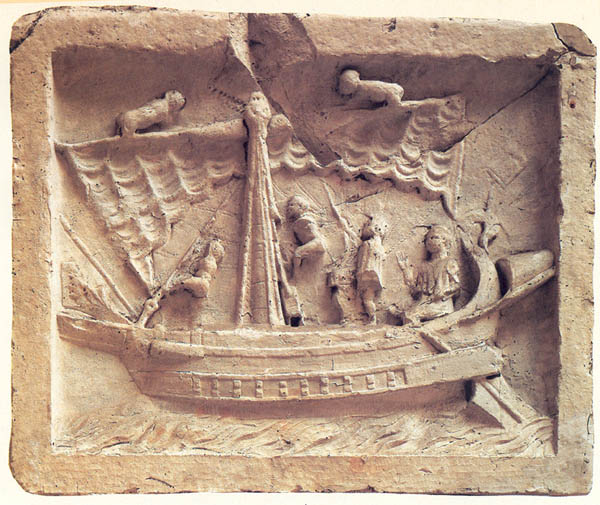
In the Acts of the Apostles, we are told that Paul made three missionary journeys. In almost every introduction to the New Testament I have seen, the author discusses St. Paul’s journeys in terms of places and dates; his concern is to establish the location of the cities Paul visited and to fix the exact time he visited them. But when Paul himself speaks of his travels he emphasizes, not the “where” or the “when,” but the “how.” For instance, in defending himself against attacks on his authority in the church of Corinth, Paul writes:
“Three times I have been shipwrecked; a night and a day I have been adrift at sea; on frequent journeys, in danger from rivers, danger from robbers, … danger in the city, danger in the wilderness, danger at sea, danger from false brethren; in toil and hardship, through many a sleepless night, in hunger and thirst, often without food, in cold and exposure” ( 2 Corinthians 11:25–27 ).
By this catalogue of hardships, the Apostle underlines his dedication to his ministry. But for us, too much is left unsaid for the evocative potential of Paul’s description to be fully realized. Paul’s contemporaries could easily have filled in the picture from their own experiences. We who travel at great speed and in security and comfort, however, need to transport ourselves consciously to a very different world if we are to appreciate the conditions under which Paul passed a great part of his life, and that contributed to the experiences that became integral to his theology.
Since Paul himself gives us no details, we must extrapolate; what he encountered would have been similar to what others, who lived a century before or after, experienced.
With minor localized exceptions, peace reigned throughout the Roman Empire for 200 years after Augustus Caesar’s (Octavian’s) accession to power in 30 -->B.C. --> During this time, travel conditions remained the same. From scattered references by Greek and Roman writers, we can recreate a rather detailed picture of what it was like to travel in the first century -->A.D. --> This has been done in an excellent study entitled Travel in the Ancient World by Lionel Casson (London: Allen & Unwin, 1974). But Casson’s material needs to be supplemented by information from a source that he inexplicably ignores; that is, from The Golden Ass, 1 a Latin novel written by Apuleius, who was born about 123 -->A.D. --> This novel describes the adventures of Lucius, a man turned into a donkey, who undergoes many misfortunes at the hands of a series of owners before finally recovering his own form as a man. The action takes lace in the area between Corinth and Thessalonica, where Paul also went, and provides invaluable 039 insights into life outside the major cities, as well as conditions of travel.
Paul’s first missionary Journey took him from Syria to Cyprus and then to Pisidia (part of modern Turkey) ( Acts 13–14 ). His second journey, across Asia Minor into Europe, is narrated by Luke in Acts 15–18 . The journey can also be reconstructed from hints scattered throughout the Pauline Epistles. The only difference between the account in Luke and in the Epistles is the date. Luke places Paul’s journey after the Jerusalem conference ( Acts 15 ), which took place in 51 or 52 -->A.D. -->, when the apostles worked out a compromise permitting Jewish and Gentile Christians to eat together. From Paul’s own letters it is clear that this journey must have taken place before the Jerusalem conference, probably between 45 and 51. 2 On his third journey, Paul revisited many of the cities where he had preached during his second journey ( Acts 18:22–21:16 ).
In Paul’s time, as today, how you traveled depended on how much money you could afford to spend. Paul was not a rich man. The impression he gives in his letters is that he had no significant personal financial resources. He seems to have had nothing beyond what he could earn and the sporadic gifts sent to him by various churches ( 2 Corinthians 11:8–9 ; Philippians 4:14 ). As an itinerant artisan, a tent-maker ( Acts 18:3 ), he was far better off than an unskilled worker of the laboring class, but no artisan became rich. It would have been as much as Paul could do to earn his daily bread, even if he had enjoyed a stable situation with a regular clientele. But Paul garnered much of his work from fellow travelers on the road, or he had to begin anew in a strange city where he had no reputation to attract business.
In these circumstances, Paul certainly traveled on foot. A large selection of wheeled vehicles was available to travelers, but to rent or buy one would 040 have been beyond his means. What about a horse? Except by military dispatch riders, horses were not used to travel long distances. Riding came easily only to those born on horseback, for saddles were rudimentary, and stirrups unknown. A donkey could certainly have borne some of Paul’s baggage, but this would only have increased his expenses without increasing his speed. Moreover, a donkey could be requisitioned by any soldier or official who needed it. Several decades earlier, the philosopher Epictetus had advised donkey owners to surrender their beasts immediately on being requested to do so, in order to avoid being beaten up by soldiers (Discourses 4:1.79). Requisitioning by soldiers was so common that it is even illustrated by an episode in Apuleius’s Golden Ass (9:36–10:12).

How far could Paul expect to go in a day? In some travel narratives the number of days needed to cover a known distance is recorded; the average daily distance is about 20 miles. 3 An anonymous traveler known as the Bordeaux pilgrim, who visited the Holy land in 333 -->A.D. -->, kept a famous diary that has survived. From Faustinopolis to Tarsus he followed the Roman road laid down when Pompey moved his legions into the East m 63 -->B.C. -->, through the Cilician Gates. Paul took this road in reverse when he traveled from Tarsus to Galatia. According to data given by the Bordeaux pilgrim, the distances were as follows: a
From Tarsus to Faustinopolis, then, was 62 Roman miles. But in between, as the chart shows, were several inns and posts. A traveler would normally spend the night at an inn ( mansio ). A post ( mutatio ) was simply a staging-point where animals could be changed.
Thus, a normal day’s journey for those traveling by carriage was from inn, roughly 25 Roman miles or 22 modern miles. Those who walked, as 041 Paul did, would have had to extend themselves to cover this distance. It is unlikely that Paul could have maintained such an average for long periods, particularly when the road was hilly.
If Paul says that he was “in hunger and thirst, often without food, in cold and exposure” ( 2 Corinthians 11:27 ), it is obvious that on occasion he found himself far from human habitation at nightfall. He may have failed to reach shelter because of weather conditions; an unusually hot day may have sapped his endurance; mountain passes may have been blocked by unseasonably early or late snowfalls; spring floods may have made sections of the road impassable (he claims to have been “in danger from rivers”)( 2 Corinthians 11:26 ); or fierce hailstorms may have forced him to take refuge. The average height of the Anatolian plateau (present day central Turkey) is 3,000 feet above sea-level, but great sections of it rise to double that and extreme variations of temperature are the rule. The mountainous territory through which Paul Passed in northern Greece would have been only marginally better.
Anyone living in the vicinity of a Roman road, and particular near a post or an inn, was subject to requisition by Roman military, as well as civilian officials. Not only could their animals and vehicles be “borrowed” but they themselves could be pressed into service as porters or drivers. In these circumstances, the ordinary traveler did not get much sympathy. So many demands were made upon those who lived near the road that they would not be apt to offer aid gratuitously. Paul, in consequence, could not count on free hospitality. Despite the traditional generosity of the poor to their own kind, he would have had to pay for both food and lodging—which meant that he had to earn money as he traveled.
Fortunately, Paul had a trade that was much in demand among travelers. As a tent-maker he had the skill to make and repair all kinds of leather goods, not just the animal skins used to make tents, Travelers were shod in leather sandals and often wore hooded leather cloaks. They carried water and wine in leather gourds. Animals were attached to carriages and carts by leather harnesses. Sometimes, the wealthy even carried tents in case they were caught in the open at nightfall. Repairing torn pieces of leather or broken stitches no doubt provide Paul with the means to pay his way. Of course, he had no control over when the demand for his services would come. He could be summoned just as he was starting out from the inn in the morning. He could be involved in a breakdown on the road. He could be kept working late at night by a customer anxious to make an early start next day. Worst of all, he could be commandeered by a soldier or official to repair the soldier’s or official’s equipment. For this, he was unlikely to be paid and all such work meant delay— another reason why Paul sometimes found himself 042 far from where he planned to be at nightfall.
When Paul made it to an inn, he could not look forward to a night of total repose. The average inn was no more than a courtyard surrounded by rooms. Baggage was piled in the open space where animals were also tethered for the night. The drivers sat around noxious little fires fueled by dried dung, or slept on the ground wrapped in their cloaks.
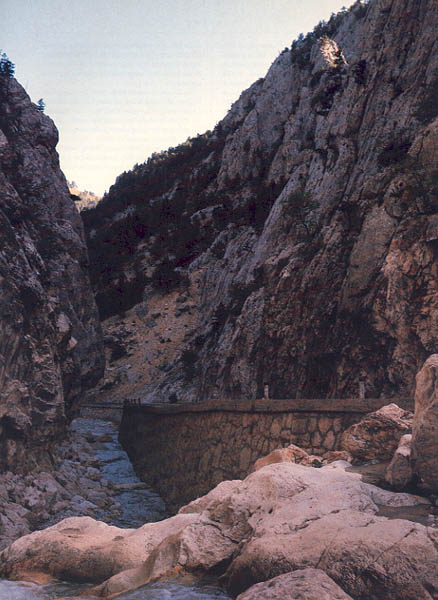
Those who could afford better rented beds in the rooms. The snorting and stamping of the animals outside was sometimes drowned out by the snores of others who shared the room, anyone of whom might be a thief. Paul’s anxiety that he might lose the tools of his trade was hardly conducive to a sound night’s sleep. And sound sleep was made infinitely more difficult by that perennial occupant of all inns, the bedbug.
The menace posed by the bedbug is graphically— and amusingly—described in a tale from the Acts of John written in the third century -->A.D. --> about a journey from Laodicea to Ephesus. 4
“On the first evening we arrived at a lonely inn, and while we were trying to find a bed for John we noticed a curious thing. There was one unoccupied and unmade bed, so we spread the cloaks which we were wearing over it, and begged him to lie down on it, while all the rest of us slept on the floor. “But when John lay down he was troubled by the bugs. They became more and more troublesome to him, and it was already midnight when he said to them in the hearing of us all, ‘I order you, you bugs, to behave yourselves, one and all. You must leave your home for tonight and be quiet in one place, and keep your distance from the servants of God.’ And while we laughed and went on talking, John went to sleep, but we talked quietly and, thanks to him, were not disturbed. “Now, as day was breaking, I got up first, and Verus and Andronicus with me, and we saw by the door of the room which we had taken an enormous mass of bugs. We were astounded at their great number. All the brethren woke up because of them, but John went on sleeping. When he woke up, we explained to him what we had seen. He sat up in bed, looked at the bugs, and said, ‘Since you have behaved yourselves and listened to my correction, you may go back to your own place.’ When he had said this, and had got up from the bed, the bugs came running from the door towards the bed, climbed up its legs, and disappeared into the joints” (#60–61).
Paul and his traveling companions must have scratched through many a weary night wishing that they had the power to rid themselves of the pest by means of a simple word!
Danger from robbers is another worry Paul mentions in his catalogue of apostolic sufferings in 2 Corinthians 11:26 , and indeed robbers were almost as pervasive as bedbugs. Casson describes a commonly held, but erroneous, view of travel conditions in the Roman Empire at the time: “The through routes were policed well enough for the traveller to ride them with relatively little fear of bandits… Wherever he went, he was under the umbrella of a well-organized, efficient legal system.” 5 This was true, however, only to the extent that the Emperor was conceived as a universal protector; in many instances, he did not function in that way. Two episodes from Apuleius’s Golden Ass illustrate the real situation. In one, Lucius, still in the form of an ass, has been driven toward a robbers’ hideout in the mountains. In a town on the way, he decides to invoke the name of the emperor, with the following result:
“It suddenly struck me that I could use the way out open to every citizen, and free myself from 044 my miseries by invoking the name of the Emperor. It was already daylight, and we were going through a populous town to which a market had attracted a good crowd. In the middle of these groups, all made up of Greeks, I tried to invoke in Greek the august name of Caesar. I got as far as a distinct and powerful ‘O’ but the remainder, the name of Caesar, I could not pronounce. The robbers, not liking the discordant sound of my voice, took it out of my hide” (3:29).
The point is no less clear for being made with sophistication and wit. The poor had no access to the emperor, and could not effectively claim his intervention.
Powerful and influential personalities were in a different situation. Apuleius’s second story concerns a disgraced procurator who was on his way into exile on the island of Zakynthos. The procurator and his escort were spending the night at a small inn at Actium when it was attacked by robbers. The robbers were beaten off by the procurator’s escort, but the procurator’s wife, who had volunteered to go into exile with him, was so incensed that she returned to Rome and asked Caesar to exterminate the brigands. There was a happy ending.
“Caesar decided that the gang of the brigand Hemus should no longer exist, and it immediately disappeared; such is the power of an imperial wish. The whole gang, chased by detachments of soldiers, ended up by being cut to pieces” (7:7).
As these stories reflect, imperial authority was exercised on the personal demand of those with enough clout to reach the emperor, not by any formal institution.
It was difficult, as well, to invoke the protection of lesser officials, since provincial governors had no permanent forces to perform regular police functions. Although they moved around their territories holding judicial sessions at selected towns, and auxiliary bodyguard units could be used to intervene if necessary, the frequency of a provincial governor’s visits to outlying towns depended on the whim of the official. Many were less than conscientious; even those who took their duties seriously made no effort to cover their territories systematically. 6
Apuleius gives a picture of the small towns in northern Greece through which Paul passed that makes them sound similar to the frontier towns of the Wild West that had no sheriff. Individuals had no one but themselves to defend their rights; they often took the law into their own hands. According to The Golden Ass , towns were often run by influential families in their own interest. Thus, we find a outpoor man dispossessed with impunity “by a rich and powerful young neighbor, who misused the prestige of his ancestry, was powerful in local politics, and could easily do anything he liked in the town” (9:35). Just before being turned into an ass, Lucius is warned.
“Take care to return early from your dinner. A gang of young idiots, all from the best families, disturb public order. You will see cadavers strewn in the street. And the auxilia of the governor, far away as they are, cannot rid the city of such carnage” (2.18).
The poor were defenseless before such casual brutality. How could they appeal to the governor? And if they ever reached him, would he accept their version of events?
Neighbors could sometimes band together against outsiders. Apuleius tells the story of a group of robbers who sidle into a town and, by cautious questions in the market, discover the house of the town’s moneylender. The moneylender becomes aware of what is going on, however; when the robbers come to his house that night, he is ready. As the chief robber slips his hand through the keyhole in order to pull the bolt, the owner nails it to the door, and runs to the roof to summon help (4:9–11). A similar story is narrated in 4:13–21. Such justice, of course, was highly localized. One could avoid a charge of murder simply by moving to another town (1:19). Runaway slaves were in little danger of being caught (8:15–23). On the other hand, if feelings ran high, thieves were simply executed on the spot (7:13).
Little imagination is needed to appreciate how vulnerable Paul was under such conditions. He was the stranger, the outsider. There was no one to whom he could turn for aid. He had no neighbors or friends, and could be easily victimized in innumerable ways. I think it very likely that this sense of vulnerability is what lies behind his repeated stress on his “weakness” ( 1 Corinthians 9:22 ; 2 Corinthians 11:29 ).
If the towns were chaotic, anarchy ruled in the countryside. Even in the relatively populous region between Athens and Corinth, the section of this road called the Sceironian Rocks was notorious for the number of its highwaymen. Highwaymen, however, were by no means the only “danger in the wilderness” ( 2 Corinthians 11:26 ) that Paul experienced.
Another danger sounds rather banal. Not all the Roman roads Paul walked were as well constructed as the famous Via Egnatia, which he took from Neapolis to Philippi and then on to Thessalonica via Amphipolis and Apollonia ( Acts 17:1 ). The Via Egnatia was a via silice strata , paved with hard igneous rock and bordered with raised stones outside of which was an unpaved track for pack animals 045 and pedestrians. Most of the other roads in the East were paved only near towns. In the countryside the road was a via glarea strata , an unsealed br gravel road. On these roads, the danger from flying stones thrown up by passing vehicles was a menace the walking traveler had to live with.
Wild animals were another danger. The story of the Golden Ass is set in an area well known to Paul, the area between Beroea and Thessalonica. As recounted by Apuleius, it was to this region that the rich man from Corinth came to collect wild beasts for his gladiatorial show (10:18). Apuleius refers explicitly to bears (4:13; 7:24), wolves (7:22; 8:15) and wild boar (8:4). Travelers in this story are armed with throwing-spears, heavy hunting-spears, bows and clubs (8:16).
Paul could have encountered some of these wild animals. When he was sent off from Beroea “as far as the sea” ( Acts 17:14 ), presumably he went to Pydna, where the harbor may have remained functional, even though the town itself moved inland in the Roman period. As the crow flies, the distance between Beroea and Pydna is 31 miles (50 krns) over mountainous terrain, a habitat of wild animals.
Several segments of Paul’s second missionary journey were by sea. He sailed from Troas to make his first European landfall at Neapolis, the port of Philippi ( Acts 16:11 ). Certainly the return journey from Corinth via Ephesus to Caesarea was also by sea ( Acts 18:18–22 ).
Combining land and sea travel was common in the eastern Mediterranean. At the beginning of the second century -->A.D. -->, Pliny the Younger wrote to the Emperor Trajan,
“I feel sure, Sir, that you will be interested to hear that I have rounded Cape Malea [the southern tip of Greece] and arrived at Ephesus with my complete staff after being delayed by contrary winds. My intention now is to travel on to my province [Bithynia] panly by coastal boat and partly by carriage. The intense heat prevents my traveling entirely by road, and the prevailing Etesian winds [north winds that blow from July to September] make it impossible to go all the way by sea” (Letters, 10:15, cf. also 10:17).
As an official, Pliny could requisition boats and carriages at will. Paul had to make do with what was available. When he left from Troas, it is likely that he simply took the first boat sailing to Greece, without being too particular about its specific destination. Since it was summer he could be sure of finding a boat. This would not have been true during the rest of the year, however. In winter, the Mediterranean was effectively closed to travel. Luke notes that “The voyage was already dangerous because the Fast [Yom Kippur, celebrated near the autumnal equinox] was already over” ( Acts 27:9 ). And Pliny the Elder advises us that “Spring opens the sea to voyagers.” ( Natural History , 2:47). Storms blew regularly in winter; the violence of these winter storms is well documented. Paul’s trip to Rome started so late in the season that one storm he endured lasted nearly three weeks ( Acts 27:19 , 27 ). Josephus records a case where a ship sent to sea in winter on an urgent military mission hit three continuous months of storms ( Jewish War , 2:200–203). Not unreasonably, the ancients considered sea travel highly risky between March and May and during September and October. Between November and February, however, it was extremely dangerous. We can easily understand why Paul wintered in Malta, rather than continuing his travels, after his shipwreck ( Acts 28:11 ), and why he considered wintering in Corinth ( 1 Corinthians 16:6 ).
Storms were not the only reason the seas were usually closed in winter. Sailors plotted a course by the sun and stars, as well as by landmarks. In winter, fog or heavy cloud cover would cut off their navigational guides, easily leading to shipwreck. Therefore, ships usually did not stray far from land. Particularly in a crowded archipelago, sailors preferred to move from one land sighting to another in daylight. Thus, on the run from Troas to Neapolis, Paul’s ship spent the night at Samothrace ( Acts 16:11 ), and on the trip from Troas to Miletus ( Acts 20:6–16 ), the ship made frequent stops—at Assos, at Mitylene, at a place opposite Chios, and finally at Samos. Cicero describes a similar journey in 51 -->B.C. -->:
“Even in July sea travel is a complicated business. I got from Athens to Delos in six days. On the 6th we left; Piraeus for Cape Zoster. A contrary wind kept us there on the 7th. On the 8th we reached Kea under pleasant conditions. We had a favorable wind for Gyaros. Thence to Syros, and on to Delos, the end of the voyage, each time more quickly than we would have wished. You know the Rhodian aphracts; nothing rides the sea as badly. So I have no intention of rushing, and do not plan to move from Delos until I can see all of Cape Gyrae [the southern tip of Tinos]” ( Ad Atticum , 5:12.1).
The prevailing wind in the sailing season was called the Etesian wind. It blew from the northern quadrant (northwest to northeast), and most 046 consistently from the northwest. Thus, any sea journey to the southeast was likely to be a delight. When Agrippa I (10 -->B.C. --> to 44 -->A.D. -->) was returning to Palestine to take over the tetrarchy of his uncle Philip, the Emperor Caligula advised him not to take the overland route to Syria, but, as quoted by Philo,
“to wait for the Etesian winds and take the short route through Alexandria. He told him that the ships are crack sailing craft and their skippers the most experienced there are; they drive their vessels like race horses on an unswerving course that goes straight as a die” (Philo, In Flaccum , 26—[trans. Casson]).
The ships referred to are the great clippers that brought Egyptian grain to Rome. These were the biggest and best ships of their day. A contemporary description gives their length as 180 feet, their beam as 50 feet, and their depth, from the deck to the bottom of the hold, 44 feet. 7 From Rome to Egypt, they ran in ballast at their best point of sailing and could carry several hundred passengers. The journey from Rome to Alexandria lasted 10 to 20 days.
Things were very different on the return trip from Egypt to Rome. The rig of that time did not allow ships to sail close to the wind; their keels were not deep enough and they lacked jibs. 8 Thus, they could not retrace their outward route, but were forced north and east toward the southern coast of Asia Minor. They had to remain at anchor when the winds were adverse and make short dashes when conditions turned favorable.
It is obvious why Paul, of his own free will, never took a ship going west. When he traveled from the Middle East to Europe, he always went overland through Asia Minor, thereby avoiding the frustration of being delayed in port by adverse winds. On the return trip, however, he always took a boat. Once the island of Rhodes had been left astern, it was a straight run to the Phoenician coast ( Acts 21:1–3 ). It certainly saved him several weeks of foot slogging.
Pliny the elder argued that “the sea-sickness caused by rolling and pitching are good for many ailments of the head, eyes, and chest” ( Natural History , 31:33)! We will never know whether Paul agreed with this assessment.
Paul sailed west only once—to be tried by the emperor ( Acts 25:12 ). The centurion who escorted Paul obviously knew the wind patterns. In the ports of the southern coast of Asia Minor, he looked for a ship going to Rome; in Myra in Lycia, the centurion found a grain carrier ( Acts 27:5 , 38 ). Even if we were not told it was an Egyptian grain carrier, we could have deduced as much from the number of passengers, 276 in all ( Acts 27:37 ). Luke graphically describes the difficulties caused by adverse winds ( Acts 27:7–8 ), and the short-lived euphoria produced by a favorable breeze ( Acts 27:14 ).
There were no passenger vessels sailing regular schedules in Paul’s day. Cargo ships took passengers on a space available basis. The procedure is described by Philostratus in his Life of Apollonius of Tyana :
“Turning to Danis, Apollonius said, ‘Do you know of a ship that is sailing for Italy?’ ‘I do,’ he replied, ‘for we are staying at the edge of the sea, and the crew is at our doors, and a ship is being got ready to start, as I gather from the shouts of the crew and the exertions they are making over weighing the anchor!’’ (8:14).
This vignette omits the haggling over the fare with a hard-eyed owner or his representative who was determined to get the maximum the market would bear. Presumably, maximum utilization of equipment was as much a concern then as it is today, but the ship’s departure had to await the coincidence of a favorable wind with favorable omens. Passengers, too, had to wait; they could not afford to go too far away because the vessel might sail at any moment.
Since passengers were nothing more than an incidental benefit to the owner, the ship provided water, but neither food nor services. Passengers were expected to furnish their own provisions, other than water, for the duration of the voyage. They had to cook for themselves, which meant taking turns, after the crew had been fed, at the hearth in the galley. The fire might be doused by a stray wave, or rough conditions might mean the fire had to be extinguished before passengers had finished cooking, since loose live coals could do irreparable damage to a wooden boat in a very short time.
Passengers had to live on deck; there were no cabins on the average coastal vessel. Apart from a little shade thrown by the mainsail, no shelter was provided. The more experienced travelers brought small tents to protect themselves and their provisions. Tents would also be useful when the boat anchored for the night, often at a port where there was no inn. Frequently, the boat anchored in a small cove whose only amenity was a spring of clear water.
If Paul needed companions on the road for the slight degree of security they provided, a friend was equally necessary on board. It would be difficult for one person to carry on board the provisions 047 necessary for an extended voyage, and it was imperative to have someone to keep an eye on them. The fact that tents were in use both ashore and on board gave Paul an opportunity to earn at least some of his passage money.
The discomfort of a sea voyage was intensified by fear. Travelers went by ship only when there was no real alternative. In the world in which Paul lived, the sea was considered dangerously alien. Farewells tended to assume that the friend taking the ship might never be seen again. Poems were written to memorialize the solemn departure. For instance, in order to wish Virgil a safe voyage to Athens, Horace composed a poem in which he evoked the invention of a boat with the words, “A heart enclosed in oak and triple-bonded bronze first committed a frail bark to the dangerous deep,” and so the human race “was launched on the forbidden route of sacrilege”( Odes , 1:3.9 and 16). In other words, in this satirical poem, Horace is saying that the ship was first conceived by a sadistic degenerate whose mission was to destroy humanity. Without this fatal discovery Virgil would not be putting his life at risk by sailing to Athens.
Such sentiments were well warranted, for shipwrecks were common. “Three times I have been shipwrecked, a night and a day I have been adrift at sea,” Paul tells us ( 2 Corinthians 11:25 ). The graphic description of a shipwreck Luke gives in Acts 27:39–44 is confirmed by other travelers. For example, listen to Dio Chrysostom (40–120 -->A.D. -->):
“It chanced that at the close of the summer season I was crossing from Chios with some fishermen in a very small boat, when such a storm arose that we had great difficulty in reaching the Hollows of Euboea in safety. The crew ran their boat up a rough beach under the cliffs, where it was wrecked. [Dio is befriended by a hunter who tells him] ‘These are called the Hollows of Euboea, where a ship is doomed if it is driven ashore, and rarely are any of those aboard saved, unless like you they sail in very light craft’” ( Discourses , 7:2–7).
Only the most urgent business justified Dio’s risking 96 miles of open sea between the island of Chios and the wild, indented east coast of Euboea. He survived only because the light fishing boat would be maneuvered through the surf. A larger boat would have been pounded to pieces further out to sea so that few if any survivors would have made it to shore. Conditions may not have been as violent off the Malta coast where the ship carrying Paul to Rome went down, because all managed to make ashore either by swimming or by holding on to loose planks ( Acts 27:41–44 ).
On at least one occasion Paul found himself “adrift on the open sea” ( 2 Corinthians 11:26 ), apparently as a result of some other kind of mishap. On the open sea, a smaller boat might be run down by a bigger one or break a plank on a heavy piece of flotsam. The survivors of an accident like this had no means of sending an SOS. Even if they were spotted by another vessel, the limited maneuverability of ancient ships made it difficult to change course to pick them up. Human life was cheap; if it was too difficult or simply too inconvenient to pick up survivors, they would be left where they were. We don’t know whether Paul was rescued by a passing ship or whether a lucky current washed him ashore. In either event, he was lucky to have spent only 24 hours in the water. And he would have been less than human had he not faced his next voyage with increased trepidation.
I have tried to give something of the reality behind Paul’s impassioned words in 2 Corinthians 11:25–27 . When we understand this reality, we better understand Paul’s dedication. I suspect our admiration for his perseverance would be even greater if we knew more about how he tried to ensure his security and earn his way.
Some of the areas through which Paul passed are spectacularly beautiful; yet this seems not to have influenced him in any way. On the other hand, his experiences as a lonely traveler almost certainly affected his theology. His pessimistic view of human nature may have been born of the ethos of his age, but it was surely reinforced by what he encountered at the inns and seaports of Greece and Asia Minor. His own poverty forced him to rub shoulders with the most downtrodden and brutalized elements in society. He no doubt felt the impact of the forces that made these elements of society what they were. He himself felt the force of a value system that the poorer elements of society could not escape. His own struggle against the insidious miasma of egocentricity would have sharpened his consciousness of sin and at the same time strengthened his dedication to the salvation of its victims. “Who is weak, and I am not weak? Who is made to fall, and I do not burn with anger?” ( 2 Corinthians 11:29 ).
In the Acts of the Apostles, we are told that Paul made three missionary journeys. In almost every introduction to the New Testament I have seen, the author discusses St. Paul’s journeys in terms of places and dates; his concern is to establish the location of the cities Paul visited and to fix the exact time he visited them. But when Paul himself speaks of his travels he emphasizes, not the “where” or the “when,” but the “how.” For instance, in defending himself against attacks on his authority in the church of Corinth, Paul writes: “Three times I have […]
You have already read your free article for this month. Please join the BAS Library or become an All Access member of BAS to gain full access to this article and so much more.
Join the BAS Library!
Already a library member? Log in here.
Institution user? Log in with your IP address or Username
Except for Tarsus, these towns are not mentioned in the Bible. But at the time the Bordeaux pilgrim lived, they existed along the route Paul took.
See in particular Fergus Millar. “The World of the Golden Ass,” Journal of Roman Studies 71 (1981) pp. 63–75.
J. Murphy-O’Connor, “Pauline Journeys Before the Jerusalem Conference,” Revue Biblique 89 (1982) pp. 71–91. This table is based on the calculations presented in Robert Jewett, A Chronology of Paul’s Life (philadelphia: Fortress Press, 1979). pp. 59–61.
Cf. R. Jewett, op. cit, p. 138, note 54.
Except for minor modifications, the translation is that of G. C. Stead in E. Hennecke-W. Schneemelcher, New Testament Apocrypha , 2 (London Lutterworth Press, 1965), pp. 243–244.
Op. cit., p. 122.
Cf. G. P. Burton, “Proconsuls, Assizes and Administration of Justice Under the Empire,” Journal of Roman Studies 65 (1975) pp. 92–106.
The description of Lucian in Navigium , 5 is cited by Casson, op cit, pp.158–159.
On this whole question see Lionel Casson, Ships and Seamanship in the Ancient World (Princeton University Press, 1971).
The Missionary Journeys and Epistles of the Apostle Paul

Here is a summary of the years of St. Paul’s journeys and his epistles. The detailed chronology follows.
- At Damascus 37-40 AD
- First Journey 45-47 AD
- Second Journey 51-53 AD
- Third Journey 54-58 AD
- Imprisonment in Judea 58-60 AD
- Voyage to Rome 60-61 AD
- Imprisonment in Rome 61-63 AD
- Post-Imprisonment Journeys 63-67 AD
- First Thessalonians 52 AD
- Second Thessalonians 52 AD
- First Corinthians 57 AD
- Second Corinthians 57 AD
- Galatians 55-57 AD
- Romans 57-58 AD
- Ephesians 62 AD
- Philippians 62 AD
- Colossians 62 AD
- Philemon 63 AD
- Hebrews 64-65 AD
- Titus 64-65 AD
- First Timothy 64-65 AD
- Second Timothy 66-67 AD
The Chronology
The crucifixion, resurrection, and ascension of Jesus Christ occurred in the spring of 32 AD. The the day of Pentecost occured (Acts 2), then the stoning of Stephen, which Saul (St. Paul) participated in before his conversion (Acts 7:59). In about 37 AD, Jesus Christ speaks to Saul (St. Paul) on the road to Damascus. St. Paul is led blind to Damascus (Acts 9:8). After the visit by Ananias, St. Paul then goes to Arabia and returns to Damascus where he spends 3 years (Galatians 1:17-18 and Acts 9:22-23). In 37 AD King Aretas took control of Damascus when Emperor Tiberius Caesar died. St. Paul departed from Damascus at night, being let down from the city wall in a basket (Acts 9:25 and 2 Corinthians 11:32). This could not have been after 40 AD, the year that King Aretas died.
St. Paul met with Barnabus, Peter, and James in Jerusalem (Acts 9:26 and Galatians 1:18-19). St. Paul then goes to Caesarea and Tarsus (Acts 9:30) and St. Peter goes to the house of Cornelius (Acts 10). Barnabus gets St. Paul and they stay in Antioch (Syria) for one year (Acts 11:26). This must be between 41 AD (beginning of Claudius Caesar’s reign) and 44 AD (Acts 11:28). The Disciples are called Christians for the first time at Antioch (Acts 11:26). James, brother of John, is killed by Herod Agrippa I (Acts 12:2). Herod Agrippa I dies in 44 AD (Acts 12:23).
The first journey of St. Paul begins when St. Paul, Barnabus, and St. Mark set out from Antioch (Acts 13:4). This journey started after 44 AD and ended a “long time” (Acts 14:28) before 50 AD. They left Antioch for Seleucia and sailed to Cyprus, large island 100 miles off Syrian coast. There they went to Salamis and Paphos where St. Paul met Bar-Jesus the sorcerer (Acts 13:4-6). Then they sailed to Perga in Pamphylia, which is now southern Turkey. From here, St. Mark returns to Jerusalem. At Antioch in Pisidia (not to be confused with the one in Syria), St. Paul and Barnabas turn to the Gentiles (Acts 13:46). Then it was on to Iconium, where they abode a “long time” (Acts 14:3), Lystra, where St. Paul is stoned, but lives (Acts 14:19), and Derbe. Then they retraced their steps back through Lystra, Iconium, and Antioch (in Pisidia) (Acts 14:21). St. Paul and Barnabas went throughout Pisidia, Pamphylia, then to Perga, Attalia, and sailed back to Antioch in Syria (Acts 14:24-26) The first journey ends in Antioch, Syria, where St. Paul and Barnabus stay there a long time (Acts 14:28).
The dates for the events from 50-60 AD are found by counting backwards from the succession of Felix’s reign as Procurator in Judea by Porcius Festus in 60 AD. Should one want to check these dates for accuracy, one should start at 60 AD and work backwards. In about 50 AD, St. Paul and Barnabus go to the council in Jerusalem 14 years after St. Paul’s conversion (Galatians 2:1-9 and Acts 15:2). Judas and Silas return to Antioch (Syria) with Barnabus and St. Paul where they continued some days (Acts 15:35-36), possibly in the winter of 50-51 AD. The second journey begins, possibly in the spring of 51 AD. St. Paul takes Silas through Syria and Cilicia (now southeastern Turkey). They came to Derbe and Lystra, where they find Timothy, who goes with St. Paul and Silas throughout Phrygia and Galatia. But they are forbidden by the Spirit to go into Asia or Bithynia. They passed through Mysia to Troas, the island of Samothracia, and then to Neapolis in Macedonia (now northern Greece). At Philippi, God opens the heart of Lydia and the Philippian jailer (Acts 16:14-34). Passing through Amphipolis and Appolonia, they came to Thessalonica, where St. Paul taught for 3 weeks. After teaching some in Berea, St. Paul departed ahead of Silas and Timothy, southward into Achaia (now southern Greece), to Athens, possibly for the winter of 51-52 AD (Acts 17:14- 15). St. Paul then makes his first visit to Corinth where he stays a year and a half (Acts 18:5). This may have been from the spring of 52 AD to the fall of 53 AD. Here, St. Paul met Aquila and Priscilla, who had just come from Rome, from which Claudius Caesar had banished all Jews. Silas and Timothy rejoin St. Paul. First Thessalonians was written from here in about 52 AD (1 Thessalonians 3:1-2, 6). We know that it was written from Corinth, and not from Athens, because Silas and Timothy had already rejoined St. Paul (1 Thessalonians 1:1 and Acts 18:5). Second Thessalonians was also written from Corinth. We know that it was soon after the first letter, because like the first letter, Silas was with St. Paul when second Thessalonians was written. After St. Paul leaves Corinth, there is no further mention of Silas traveling with St. Paul. St. Paul left by boat with Aquila and Priscilla to Cenchrea and then across the Aegean Sea to Ephesus. Aquila and Priscilla stay there where they would later meet Apollos (Acts 18:19 and 26). St. Paul sails on to Caesarea and then goes up to Antioch in Syria, where the second journey ends. St. Paul stayed a while (Acts 18:23). This may have been the winter of 53-54 AD.
The third journey begins with Galatia (central region of Turkey) possibly in the spring of 54 AD and then Phrygia (Acts 18:23). Then St. Paul arrives at Ephesus where he stayed for 3 years (Acts 20:31) probably from the fall of 54 AD to the fall of 57 AD. St. Paul meets disciples of John the Baptist. He preached in the synagogue for 3 months (Acts 19:8). He disputed daily in the school of Tyrannus for 2 years (Acts 19:9-10), so that all that dwelt in Asia heard the word. St. Paul sent Timothy and Erastus ahead into Macedonia, but St. Paul stayed in Asia for a season (Acts 19:22). St. Paul wrote 1 Corinthians near the end of this stay in Ephesus (1 Corinthians 16:8,19), probably in 57 AD. It was not written with Timothy, who St. Paul had sent ahead into Macedonia (Acts 19:22). St. Paul foresaw his route of travel for the next four or so years in Acts 19:21-22. This agrees with his plans in 1 Corinthians 16:1, 3, 5, 8-10. Note how the “great door” opened to St. Paul and “many adversaries” in verse 9 compares with the events in the Ephesian amphitheater in Acts 19:23-41. In 1 Corinthians 3:6 St. Paul says “Apollos watered”. This refers to Apollos teaching in Corinth when St. Paul was at Ephesus, (Acts 19:1).
St. Paul had rejoined Timothy when Second Corinthians was written (2 Corinthians 1:1). St. Paul had come to Troas and continued to Macedonia (2 Corinthians 2:12-13 and 7:5), which seems to correspond to Acts 20:1. St. Paul also talks of a third visit to Corinth in 2 Corinthians 13:1 and 12:14. So Second Corinthians was most likely written in the fall of 57 AD from somewhere in Macedonia (northern Greece), possibly Philippi. In 2 Corinthians 12:1-4, St. Paul says 14 years ago I ascended into heaven. From 57, going back 14 years to 43 AD, this puts us back before St. Paul’s first journey, probably when he was at Antioch in Syria. After going through Macedonia (northern Greece), St. Paul came to Achaia (southern Greece) where he stayed 3 months (Acts 20:2-3), making third visit to Corinth. This is where he spent the winter of 57-58 AD (1 Corinthians 16:5-8). Romans was written at this time (Romans 15:23-26 and 1 Corinthians 16:1-3). Going back to Macedonia (Acts 20:1), they were at Philippi (northeastern Greece) in the spring of 58 AD in the “days of unleavened bread” (Acts 20:6).
Then they sailed to Troas, where a young man fell out of a window, and St. Paul raises him from the dead (Acts 20:7-12). Then St. Paul went to Assos, Mitylene, Chios, Samos, Trogylium, and Miletus (now in southwestern Turkey). From here, St. Paul addresses Ephesian elders whom he had called to meet him (Acts 20:17-38) in the spring of 58 AD (Acts 20:16). Sailing to Coos, Rhodes, Patara, and passing on the south side of Cyprus, they came to Tyre (which is now in Lebanon) where they stayed one week. Then they went south to Ptolemais and to Caesarea where they stayed many days (Acts 21:10). Then St. Paul goes to Jerusalem, where the third journey ends.
Here let us pause to look at the question: When was Galatians written? Galatians was written when St. Paul was not in prison and when neither Silas or Timothy were with him (Galatians 1:1). It was written after the council in Jerusalem (Acts 15:1-32 and Galatians 2:1-10) and after St. Paul’s second visit to the region on his second journey in about 51 AD (Acts 16:1-6). Since they were “so soon removed” from grace (Galatians 1:6), it must have been before the prison years of 58-63 AD. So it could have been written when St. Paul was alone in Athens in the winter of 51-52 AD, which would make it St. Paul’s first letter. But this is unlikely, since St. Paul was only in Athens a short time (Acts 17:15). Or it could have been written from Antioch between St. Paul’s second and third journeys in the winter of 53-54 AD (Acts 18:22-23). But this is also unlikely because St. Paul would have probably mentioned that he would be coming to them soon on his third journey. It could have been written from Corinth in the winter of 57-58 where St. Paul wrote Romans. But most likely, it was written from Ephesus during St. Paul’s 3 years there from 54-57. St. Paul had recently passed through the region of Galatia “… strengthening all the disciples …” (Acts 18:23) and spent far more time in Ephesus where he could have gotten the unfavorable report about the churches in Galatia (Galatians 1:6) which was relatively nearby.
The third journey ends at Jerusalem in 58 AD. St. Paul is beaten by the Jews, preaches to them (Acts 22:1-21), and is brought before the Sanhedrin. Jesus Christ tells St. Paul that he will go to bear him witness in Rome. Many Jews vow to kill St. Paul (Acts 23:12). In 58 AD, St. Paul is taken to Governor Felix (reigned 53-60) at Caesarea, “many years” (Acts 24:10) after 53 AD and 2 years before the end of Felix’s reign. St. Paul then spends 2 years in prison in Caesarea in Judea. In 60 AD, Governor Portius Festus’s reign begins. St. Paul appeals to Caesar (Acts 25:11). Some days pass, then Herod Agrippa II hears St. Paul.
The voyage to Rome begins – St. Paul, still a prisoner, sails to Sidon with Luke and Aristarchus (Acts 27:1-2) on the way to Italy. They sailed to Myra (now southern Turkey) and on to Lasea, a large island of Crete, 50 miles southeast of Greece, where much time was spent (Acts 27:7-13). In the fall of 60 AD, they reached Melita, a small island south of Sicily. St. Paul was bitten by a poisonous snake but lived. St. Paul healed the father of Publius and others. St. Paul (still captive) spends the winter of 60-61 AD (Acts 28:11) on the island with his captors. In the spring, they sailed on to Syracuse (on the island of Sicily), then to Rhegium (on the southern tip of Italy), then to Puteoli (on the western coast of Italy). The voyage to Rome ends – St. Paul spends 2 years in his own hired house (Acts 28:30) as a prisoner in Rome from 61-63 AD. During this time he wrote Ephesians, Philippians, Colossians, and Philemon. In about 62 AD, St. Paul wrote Ephesians before Timothy came to him (Ephesians 1:1) while in prison in Rome (Ephesians 3:1, 4:1, and 6:20). Also in about 62 AD, St. Paul wrote Philippians from prison (Philippians 1:7) in Rome (4:23) with Timothy (1:1). St. Paul wrote Colossians from prison (Colossians 4:18) in Rome in about 62 AD with Timothy (1:1) and fellow prisoner, Aristarchus (4:10). St. Paul, with Timothy, wrote Philemon from prison in 63 AD (Philemon 1:1).
St. Paul after the imprisonment in Rome – We know that St. Paul had further journeys after he was released from the prison in Rome in 63 AD. After his release, he wrote the epistles of Hebrews, Titus, First Timothy, and Second Timothy, not necessarily in that order, although Second Timothy was apparently his last. This took place after the events recorded in the book of Acts, so all of our information comes from various statements that St. Paul makes in his letters. In them are clues that St. Paul may have traveled to some or all of the following places: Colosse, Spain, Corinth, Miletus, Troas, Crete, Nicopolis, Philippi, Italy, Judea, Ephesus, and Macedonia. This allows for the possibilities that St. Paul traveled to more about as many diverse places as in all of his previous journeys combined. There are probably several possible ways that one could reconstruct the sequence of these travels which would not disagree with scripture. Since we do not know which one would be correct, we will just list what we know about the journeys. Thus, the references below are not intended to be chronological, although they all occurred after St. Paul’s release from prison in 63 AD.
In Philemon 22, St. Paul foresaw his release and tells those in Colosse to prepare him lodging. We know that Philemon was written to the Colossians because of Archippus (Colossians 4:17 and Philemon 2), Onesimus (Colossians 4:9 and Philemon 9-10), and others (Colossians 4:10-14 and Philemon 23-25). Also, while in prison in Rome St. Paul wrote to those in Philippi that he may be coming to visit them (Philippians 1:26). In Romans 1:10, 15:24 and 28, and 16:1, 3, and 5 St. Paul speaks of aspirations of eventually going to Spain. Did he ever do this in his final years? The Bible does not say whether he did or not. We do however have the account of the century author, St. Clement of Rome, regarding St. Paul: “After preaching both in the east and west, he gained the illustrious reputation due to his faith, having taught righteousness to the whole world, and come to the extreme limit of the west, and suffered martyrdom under the prefects” (The First Epistle of Clement to the Corinthians, Chapter 5). The “extreme limit of the west” may be Spain. We do not know for sure.
At some time after being released from the prison in Rome, St. Paul went to Corinth and Miletus (2 Timothy 4:20). He also went to Troas (2 Timothy 4:13), Crete (Titus 1:5), and Nicopolis for the winter (Titus 3:12). St. Paul leaving Titus in Crete must have been during a period of liberty after St. Paul’s imprisonment in Rome ended in 63 AD. St. Paul did not go there during the first 3 journeys. There is no mention of Titus or of any preaching on Crete in Acts 27:7-13, on the voyage to Rome. St. Paul says he will send Artemas or Tychicus to Titus. He tells Titus to come to Nicopolis where St. Paul has determined to winter (Titus 3:12). The letter to Titus was probably written around 64-65 AD. There are three cities called Nicopolis: (1) in Achaia (southern Greece), most likely the one to which St. Paul was referring, (2) 15 miles west of Jerusalem, and (3) in the area that is now Romania. The book of Hebrews was apparently written from Italy (Hebrews 13:24). Timothy had been released from prison (Hebrews 13:23) and was coming to St. Paul. St. Paul was apparently at liberty as well, since they planned to then go to visit the Hebrews. This could have been in Judea, as St. Paul says, “… for you had compassion of me in my bonds …” (Hebrews 10:34). This must have been in reference to St. Paul’s imprisonment in Caesarea from 58-60 AD. Hebrews was probably written around 64-65 AD.
St. Paul had told Timothy to stay and teach in Ephesus when St. Paul went to Macedonia (1 Timothy 1:3). During the third journey, St. Paul had done the opposite, staying in Ephesus himself, and sending Timothy with Erastus to Macedonia (Acts 19:22). So First Timothy was written around 64-65 AD during a period of liberty after St. Paul’s Roman imprisonment of 61-63 AD. St. Paul said he was hoping to come to Timothy in Ephesus shortly, but may have to tarry long (1 Timothy 3:14-15). Timothy was in Ephesus where he received both First Timothy and Second Timothy (1 Timothy 1:3, 2 Timothy 1:16-18, 4:14, 4:19, Acts 19:33, and 1 Timothy 1:20). Second Timothy may have been written from prison (2 Timothy 1:8) with St. Paul ready to die (2 Timothy 4:6-8), possibly about 66 AD. Yet he asks Timothy to come to him before winter (2 Timothy 4:9 and 21). St. Paul was probably martyred sometime around 67 AD.
May the blessings of this missionary Apostle be with us all.
Posted by Fr. Moses Samaan
His eminence metropolitan serapion celebrates the divine liturgy at st. mark coptic orthodox church.
Feb 18, 2024
On the 2nd Sunday of the blessed Month of Amshir, February 18, 2024, His Eminence Metropolitan Serapion Celebrated the Divine...
His Eminence Metropolitan Serapion celebrates the Nativity Feast at Holy Annunciation Coptic Orthodox Church
Jan 7, 2024
On the eve of Saturday, January 6, 2024, His Eminence Metropolitan Serapion celebrated the Divine Liturgy of the Nativity...
Comment on the Vatican’s Permission of Blessing of Same-Sex Couples
Dec 20, 2023
https://youtu.be/nyfUM1rGv80 In the Name of the Father, the Son, and the Holy Spirit, One God. Amen. On December 18, 2023, the...
Schedule of the Funeral Prayer in Loving Memory of Archdeacon Jacob Abedelmalak
Dec 1, 2023
The arrangements for the Schedule of the Funeral Prayer in Loving Memory of Archdeacon Jacob Abedelmalak. May God response his...
Celebrating the Divine Liturgy of the Feast of Transfiguration at Christ the Savior American Coptic Orthodox Church!
Aug 19, 2023
On the 13th day of the blessed month of Mesore, Saturday August 19, 2023, His Eminence Metropolitan Serapion accompanied by...
How to go to Heaven
How to get right with god.

What were the different missionary journeys of Paul?
For further study, related articles, subscribe to the, question of the week.
Get our Question of the Week delivered right to your inbox!

A quick guide to St. Paul’s travels according to today’s map
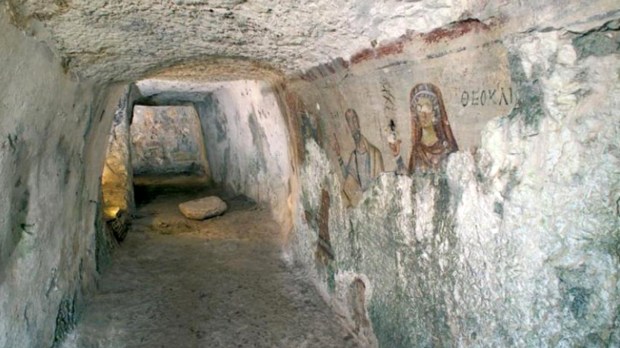
Ephesus Foundation USA
Please consider a gift for Aleteia! Help us spread the joy of Christ's victory. Aleteia depends on your support.
Join our Lenten Campaign 2024.

A comprehensive map of all the journeys taken by St. Paul in his lifetime is yet to be completed . But what we know for sure is that Paul, who used to be called by his Jewish name Saul of Tarsus before converting to Christianity, spent about 30 years sailing around the Mediterranean basin and visiting what were considered to be the major cities of his time.
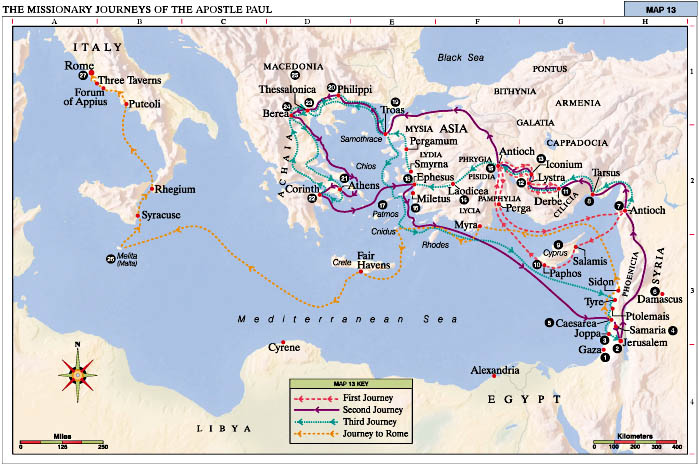
Sources disagree on an exact list of locations that Paul visited during his lifetime, but what’s sure is that during the three journeys described in Acts 13-14 , Acts 15-17 and Acts 18-20 he visited many historical cities that are considered the backbone of Western civilization. From Athens to Corinth, passing through Antioch and Ephesus, here is a summary of Paul’s travels , including an indication of where those locations are on today’s map.
What’s considered Paul’s “first journey” started in the year 45 and ended in 49 . Together with Barnabas, a Cypriot Jew converted to Christianity, Paul traveled across the island of Cyprus, Barnabas’s homeland, preaching the Gospel in several synagogues. They then set sail from Paphos, on the southwest coast of Cyprus, and reached the port of Perga, in Anatolia, modern-day Turkey.
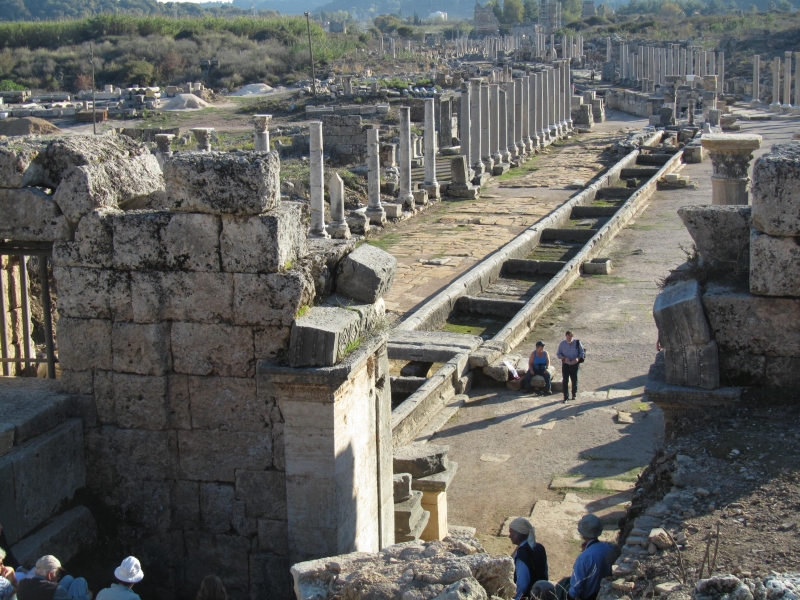
From Perga they finally reached Antioch of Pisidia, where Paul began to spread the word to the local Jewish community. Initially, his message was very well received, leading to an invitation to speak during Sabbath (the holy day), but part of the community soon turned envious about the strong popularity enjoyed by a foreign preacher and eventually managed to push Paul out of the city.
Paul and Barnabas then left for Konya, a city just south of Ankara, in present-day Turkey, but were forced to leave again, this time for the nearby town of Lystra. Here Paul healed a sick man and the local pagan community began to believe he was sent by God. But soon enough, the same people who contested him in Konya reached Lystra and instigated a group of locals to stone Paul, forcing him to flee. He then reached the city of Derbe, also in modern-day Turkey, and from there back to Lystra, Konya and finally Antioch of Syria on the Orontes, a city of ancient Syria now in modern-day Turkey, where his journey originated. Here Paul reports that, through his message, many pagans got to know the word of God.
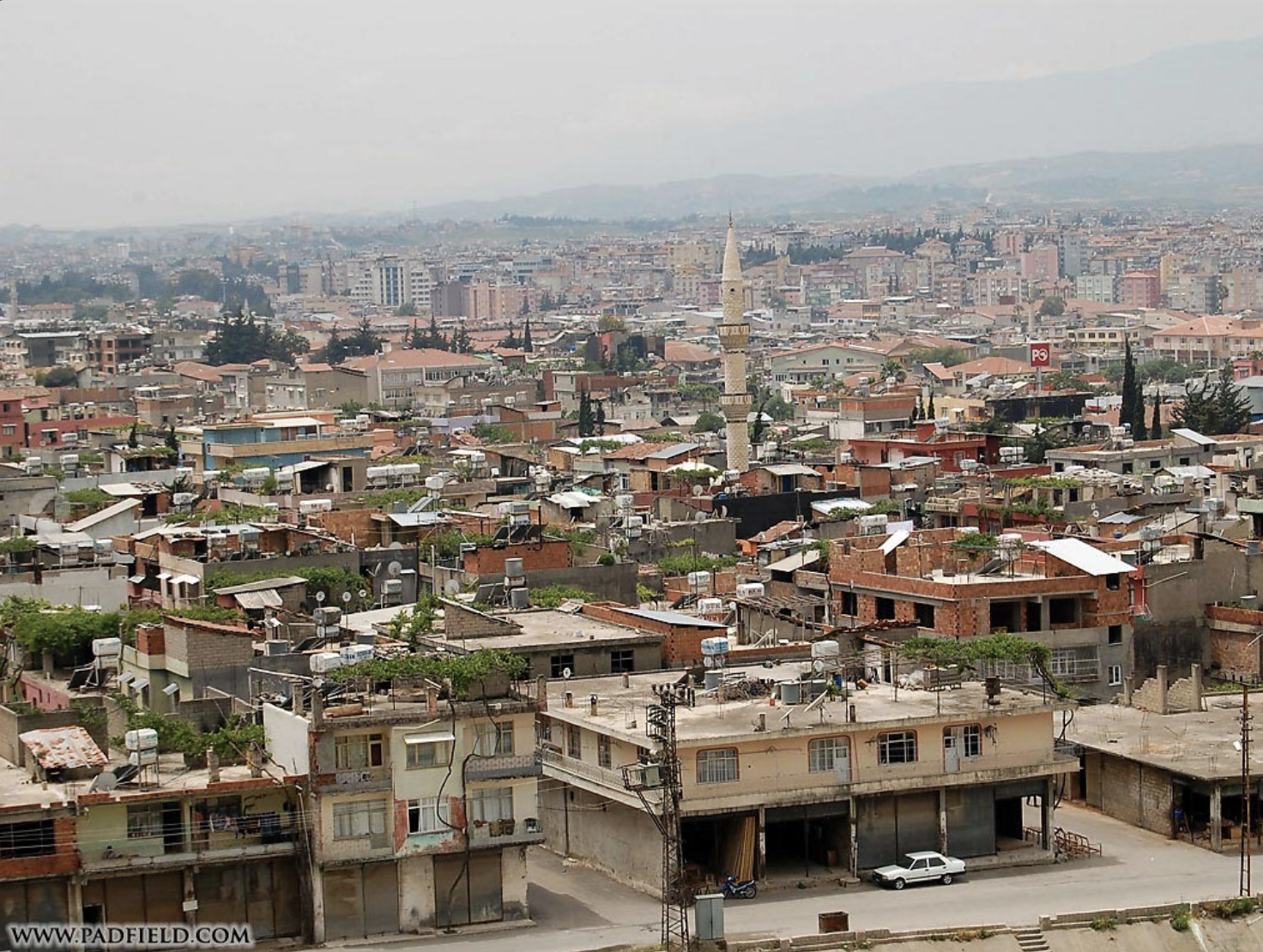
Second trip
Paul’s second journey started in the year 49 and ended in 52 . This time, Paul hit the road to check back on those early Christian communities he helped found during his first trip.
He was accompanied by Silas, a leading member of the early Christian community, and Timothy, the son of a Greek man who was a dear companion to Paul. The group headed to Lystra, then through Phrygia, an ancient kingdom on the Sangarios River in modern day Turkey; then to Galatia, an area in the highlands of central Anatolia, also in present-day Turkey, that was inhabited by Gallic people of the Hellenistic period, and finally to Troad, a city in north-west Anatolia, present-day Turkey.
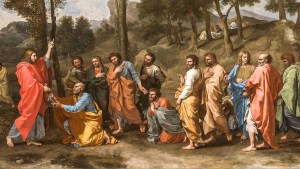
Here, Paul had a vision of a man asking him to bring the Gospel to Macedonia , and then set off to reach the European mainland for the first time. By way of Samothrace, a Greek island in the northern Aegean Sea, and Neapolis, known today as the Greek city of Kavala, they reached Philippi, a Roman city in the first district of Macedonia, which today stands as one of Greece’s UNESCO World Heritage Sites.
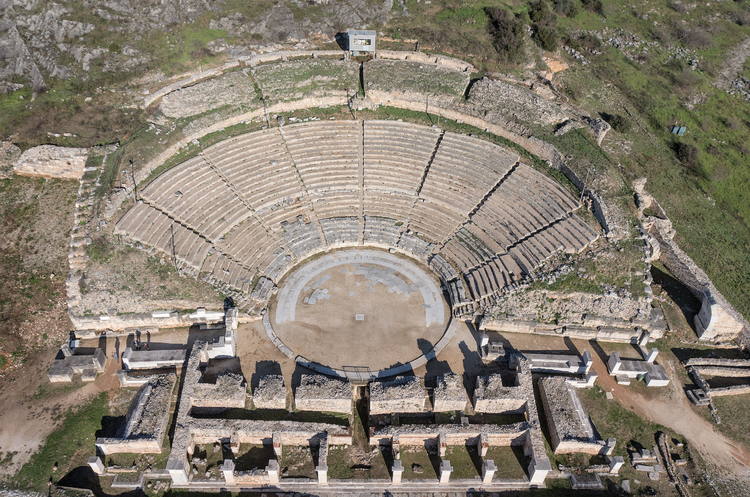
Here, Paul was hosted by Lydia, a woman who worked as a dealer in purple cloth from the city of Thyatira. But soon enough, a group of hostile locals pushed authorities to arrest Paul and his companions. However, thanks to a providential earthquake, the group managed to escape Philippi’s jail. Eventually, local magistrates learned that Paul and his travel companions were Roman citizens and officially let them free. The Philippian community soon grew to become an important Christian center, to which Paul later addressed the Epistle of Paul to the Philippians.
After Philippi, the group reached Thessaloniki, in present-day northern Greece, where they were hosted by Jason, a Jewish man who had converted to Christianity. Here, even if his mission was somehow successful, Paul was quickly forced to leave after a group of local Jews reported his evangelization activities to local pagan authorities.
They then left for Berea, an important port city, now known as Veria, in Macedonia, north of Greece, but the same group that kicked them out of Thessaloniki soon caught up with them and pushed them to leave Berea as well.
The group hit the road once again and reached Athens, which had been severely damaged by Roman attacks in 146 B.C. but was still considered the capital of philosophy and knowledge of what was then the known world. Here Paul engaged in conversation with many public intellectuals in both synagogues and public squares and was eventually invited to give a speech to Athenian citizens from the Aeropago , a marble hill just above the Acropolis. According to Luke (Act 17, 11-33) it is here that Paul proclaimed his famous speech about “the Unknown God” to to the pagan thinkers of Athens.
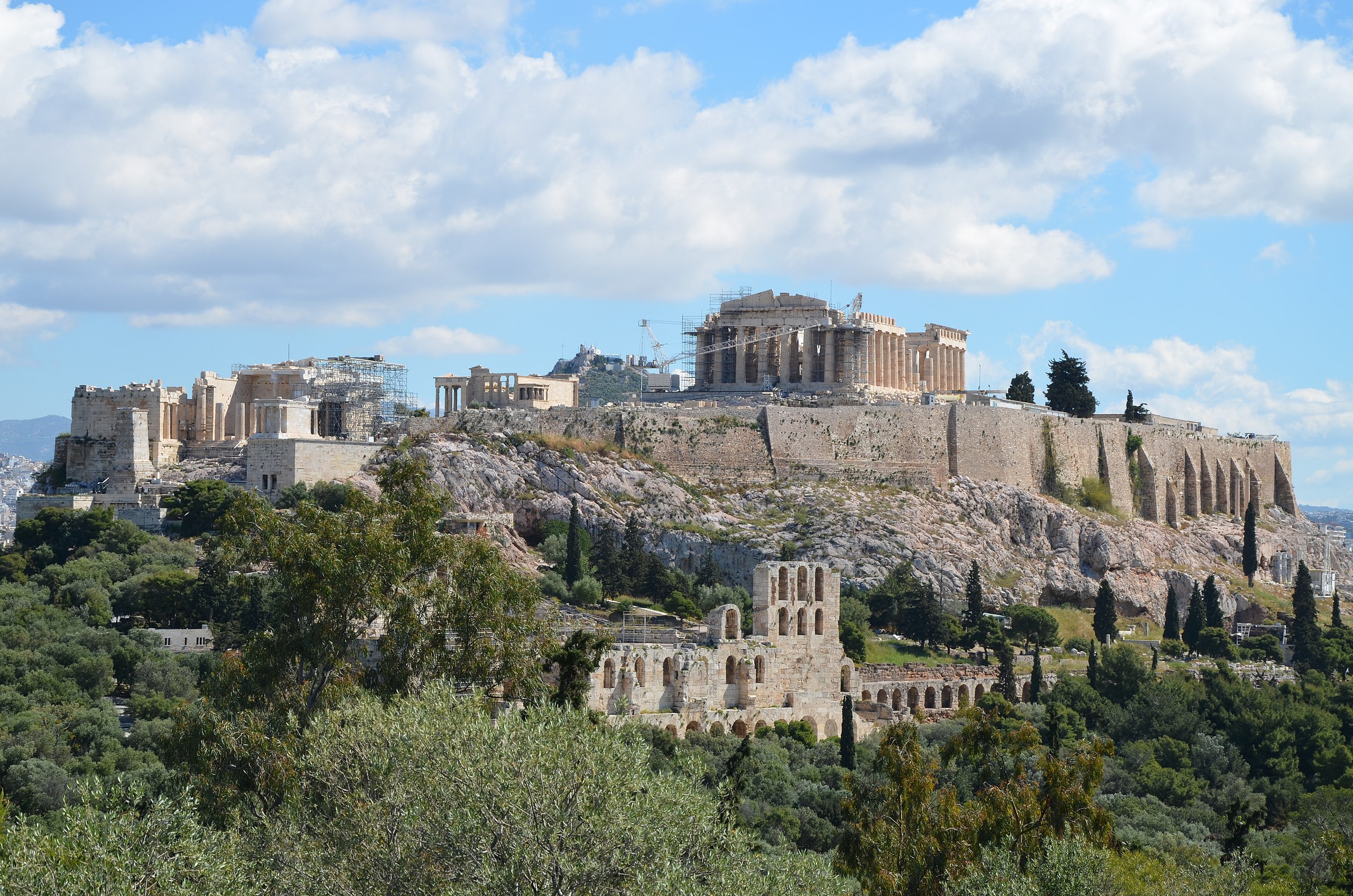
From Athens, Paul headed to Corinth, capital of the Roman province of Acaia in present-day south-central Greece. Here he stayed with the married Christian couple Priscilla and Aquila , who had been exiled by the Roman emperor Claudius in 49-50. In Corinth Paul engaged in prolific speeches that led to many conversions, but he was subject to hostility from groups of local Jews. However, Roman pro-consul Gallio adopted a neutral stance regarding Paul religious mission and decided to let him free.
Together with Priscilla and Aquila, Paul set sail for Syria and reached Ephesus and from here Caesarea, in modern day north-central Israel, and eventually back to Antioch.
Third journey
Paul’s third journey took place between 52 and 57 . He first headed back to Galatia and Phrygia to check on the communities he helped set up during his previous trips. He then set sail for Ephesus , an ancient Greek city in present-day Turkey, which at the time was the capital of the Roman province of Asia and home to the famous temple of Artemis-Diana, which was considered one of the seven wonders of the world. Here Paul baptized 12 disciples who had previously received a penitential baptism by John the Baptist, and together with companions he helped evangelize nearly all the local inhabitants.
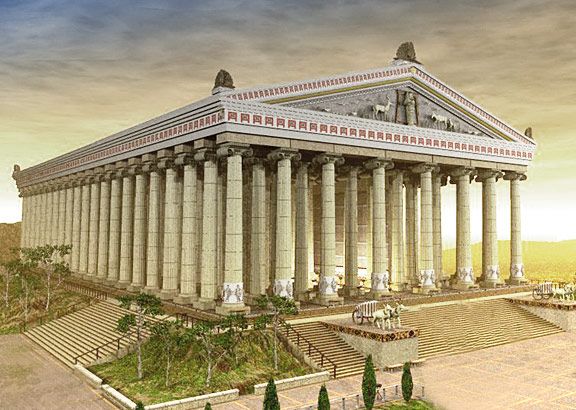
After a winter break in Corinth, Paul headed back to Ephesus , but hostility from local Jews forced him to leave for Antioch, Syria. From here he departed for more Greek cities—including the islands of Lesbos and Samos—and reaches Miletus, in modern-day Turkey.
Here he pronounced his famous speech dedicated to the “Ephesian elders, ” in which he recommended that the leaders of the communities he helped found take on his mission and preserve the values of vigilance, disinterest and charity. In 58, Paul decided to head toward Jerusalem , so he set off on an arduous sailing trip that made stops at a new harbor almost each day, including the islands of Kos and Rhodes in modern-day Greece. He finally reached Jerusalem where he stayed with Mnason of Cyprus, one of the people he helped convert on one of his early trips.
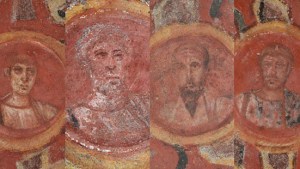
Paul then visited James, who advised him to talk to the most traditionalist Jews at the Temple. Here Paul was recognized by the Jews of Asian provinces, and once again faced hostility. Claudius Lysias, the local Roman tribune, intervened and put Paul in jail before even knowing that he is a Roman citizen. This was the start of what many refer to as the “Passion Pauli,” in which St. Paul’s dedication to his evangelization mission led to his arrest, beating, torture, and eventual death in Rome at the order of Emperor Nero in 62-64.
Make sure to visit the slideshow below to discover some of the greatest works of art representing the Road to Damascus, the decisive moment in the life of Paul, the Apostle to the Gentiles.
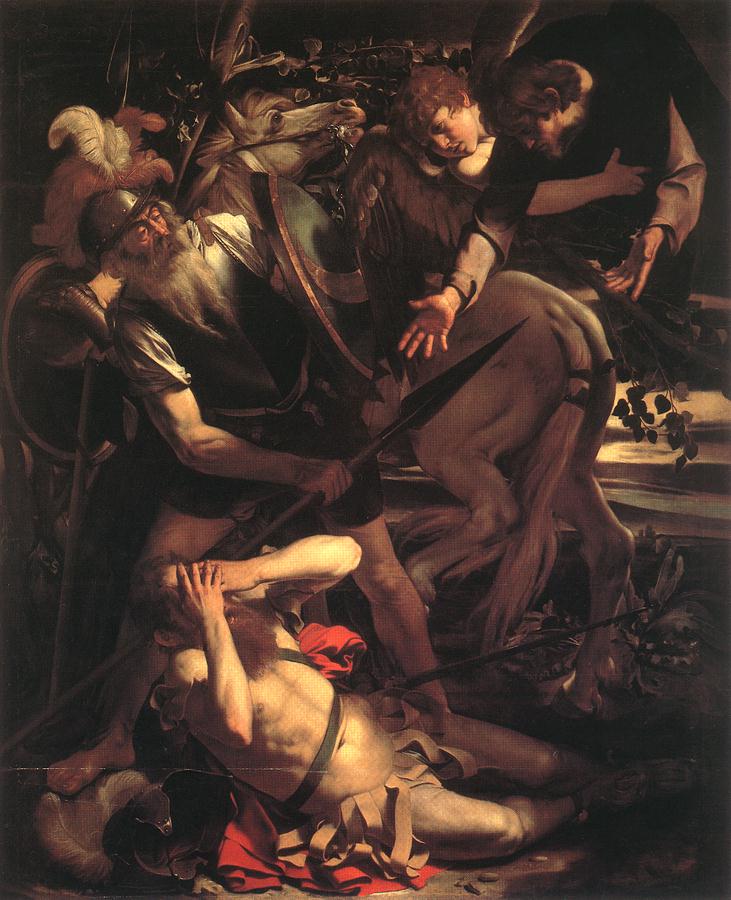
Enjoying your time on Aleteia?
Articles like these are sponsored free for every Catholic through the support of generous readers just like you.
Thanks to their partnership in our mission, we reach more than 20 million unique users per month!
Help us continue to bring the Gospel to people everywhere through uplifting and transformative Catholic news, stories, spirituality, and more.
Support Aleteia with a gift today!
Apostle Paul's Second Missionary Journey Map
Late summer 49 a.d. to late autumn.
Pharisaic Judaizers come down to Antioch (Acts 15:1, 5) in the late summer of 49 A.D. and teach that circumcision is necessary before a person can be saved. Paul, Barnabas, Titus and certain others (Galatians 2:1 - 2) are sent to Jerusalem to confer with other apostles, elders and brethren concerning the relationship between circumcision and salvation.
The gathering of Paul and countless others to discuss this huge controversy in the early church is commonly referred to as the Jerusalem Conference. This conference occurs in the Fall of 49 A.D. around the time of the Feast of Tabernacles (Acts 15:2).
Paul and Barnabas have a private meeting with the apostles James, Peter and John about the circumcision question (Galatians 2:4 - 10). They agree that circumcision is not required for Gentiles to be saved. The ministry of Paul and Barnabas is confirmed.
The Question of Circumcision
The circumcision question is discussed further among the conference attendees. Peter offers his judgment then Paul and Barnabas tell the conference about the miracles and wonders God has wrought among the Gentiles through them (Acts 15:12). James then renders his judgment (Acts 15:13 - 21).

The apostles, elders and the whole church agree with James that the Gentiles do not need to be circumcised in order to become a believer and receive salvation. The conference has Judas (Barsabas) and Silas travel with the two evangelists to Antioch to deliver a letter, written by James, summarizing what was decided in Jerusalem regarding the circumcision question (Acts 15:30 - 32).
Late Autumn 49 A.D.
Paul and Barnabas stay in Antioch a certain number of days until they have a sharp disagreement over whether to take John Mark with them on another missionary journey. The argument becomes so heated that they separate (Acts 15:36 - 41).
Late Autumn 49 to Late Summer 50
Paul takes Silas with him to Tarsus. From there they travel to Derbe and Lystra. It is in Lystra that he meets Timothy, who would become his frequent traveling companion, fellow laborer in spreading the gospel and his best friend (Acts 16:1; 1Timothy 1:2, 4:14).
The apostle has Timothy circumcised (Acts 16:3). He then takes him and Silas to churches in the regions of Galatia (Iconium) and Phrygia (Antioch) to deliver the decision rendered at the Jerusalem conference.
Forbidden to Preach
Paul, as he journeys to the northwest of Antioch, desires to preach the gospel in western Asia. God's spirit, however, forbids him to do so (Acts 16:6). The apostle and his group continues to travel north toward the region of Mysia. He wants to travel East to the province of Bithynia but again is forbidden to do so (Acts 16:7). Him and his companions then decide to go to the port city of Troas on the Aegean Sea.
It is in Troas that Luke, the writer of the book of Acts, joins Paul and company. God then gives him a vision of a man in Macedonia (Greece) begging him for help (Acts 16:8 - 9). The group then immediately boards a ship, which sails near the island of Samothrace (Samothracia), then arrives at Neapolis (Acts 16:10 - 11).
First European Convert
From Neapolis the group goes to Philippi, where a woman named Lydia hears Paul's preaching. On Pentecost in 50 A.D. Lydia is baptized along with her entire household (Acts 16:12 - 15).
Paul, while in Philippi, casts a demon out of a female slave (Acts 16:16 - 18). Her masters, however, angry that they have lost the ability to make more money from the slave's demonic divination, stir up the city against him and Silas. The two evangelists are arrested, beaten and put in prison (Acts 16:19 - 24).
Soon after the evangelists arrive in jail a miraculous earthquake causes all the cell doors to open and the bonds of all prisoners to be loosed. This event leads to the conversion of the prison guard.
Evangelizing Thessalonica
A freed Paul and Silas, along with Timothy and Luke, travel through the cities of Amphipolis and Apollonia and arrive in Thessalonica (Acts 17:1). In Thessalonica Paul visits a Jewish synagogue and for three consecutive Sabbaths (Saturdays) explains why Jesus is the Old Testament prophesied Savior of Mankind (Acts 17:2 - 4).
Although many believe what is said certain Jews, envious of the Gospel's success, form a mob and start a riot (Acts 17:4 - 5). The riotous crowd go to the house of Jason seeking him and Silas. When they are not found, the crowd drags Jason and some brethren to the local civil magistrates and accuses them of wrongdoing (Acts 17:5 - 8). In a short time, however, Jason and the brethren are let go.
The Noble Bereans
Paul and Silas preach in a synagogue in Berea. The Bereans are not only willing to listen to what they have to say they also verify what is preached against the Old Testament scriptures (Acts 17:11 - 12). Many Bereans come to believe the Gospel. Unfortunately, Jews from Thessalonica arrive in the city seeking to cause more trouble for him (Acts 17:13).
Paul immediately leaves for the coast and sets sail for Athens while the rest of his party stay in Berea (Acts 17:14). In Athens he requests Timothy and Silas come to the city (Acts 17:15).
Debate in Athens
The apostle, while waiting in Athens for his traveling companions, preaches the Gospel to any Athenian who would listen. Some who hear his message are Jews and devout people. Others are Epicureans (followers of Epicurus) who believe the highest aim of man is to seek a pleasant life while other are Stoics. The Stoics believe that man's happiness consists of bringing himself into harmony with the universe.
After hearing some of Paul's message the Epicureans and Stoics take him to the Areopagus (or Mars Hill as the Romans call it) to further explain what he teaches (Acts 17:16 - 19).
On Mars Hill Paul uses an altar he saw dedicated to "an unknown god" as a springboard for teaching the crowd about the real God that can be known (Acts 17:19, 22 - 23).
Late Summer 50 to Autumn 52 A.D.
Paul leaves Athens and travels to Corinth. It is in Corinth that he first meets Priscilla and Aquila. Since both he and the couple make a living as tentmakers he stays at their house. He preaches the gospel every Sabbath in the synagogue. Silas and Timothy join him in Corinth. (Acts 18:1 - 5). The synagogue eventually splits and a new church is formed. After the split he stays and teaches in Corinth for a year and a half.
In the winter of 51 A.D. Paul is brought before the judgment seat of Gallio (Acts 18:12 - 18) and is released. He remains in Corinth until the Spring of 52 A.D. when he then travels to the port city of Cenchrea. In the city he has his head shaved due to a vow he took (Acts 18:18). He soon boards a ship and travels to Ephesus with Priscilla and Aquila.
In Ephesus Paul preaches in a synagogue but soon leaves the couple behind so that he can be in Jerusalem to celebrate the Feast of Tabernacles (Acts 18:19 - 21). He sails from Ephesus to Caesarea, then travels to Jerusalem. After keeping the Feast he returns to Antioch (Acts 18:21 - 22).

- Upcoming Cruises
- Switzerland
- Netherlands
- Africa (Continent)
- Lake Kariba
- Christmas/New Year
- Past Cruises
- The African Dream
- MS Celestyal Crystal
- MS Celestyal Journey
- MS Infante D. Henrique
- MS La Belle de l’Adriatique
- MS Michelangelo
- MS Rhone Princess
- MS Swiss Diamond
- MS Swiss Ruby
- MS Viva Gloria
- MS Viva Moments
- MS Viva One
- MS Viva Two
- MS Viva Voyage
- MS World Navigator
- MS World Traveller
- Travel Updates
- Newsletter Specials Sign-Up
- Travel Insurance
Steps of Paul - Cruising the Eastern Mediterranean
October 14, 2023, 8 days | 7 cities | 2 countries.
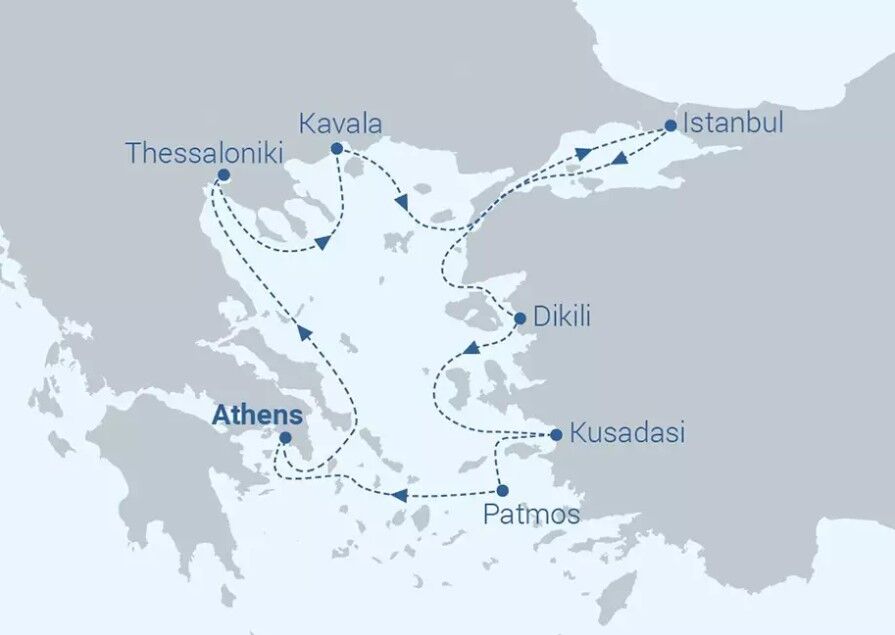
Join us on a mesmerizing voyage to discover the romance and the mystery of the Eastern Mediterranean as we follow in the footsteps of St. Paul the Apostle. As we journey through the emerald waters of the sun-soaked Cyclades and the stunning coastline of Turkey, this wonderful 7-night adventure invites you to explore iconic landmarks, savor authentic cuisine, and discover the trials and tribulations of St. Paul’s epic journey to the Eastern Mediterranean region.
As you explore the captivating coastal towns and discover charming Byzantine monuments you will learn about how St. Paul’s controversial ideas sparked riots and cast him into prison. Along the way, you will have the opportunity to visit famous landmarks including the Hagia Sophia, the Holy Grotto of the Apocalypse, the Faustina Baths of Miletus, and ancient Ephesus, the best-preserved historical site in the Eastern Med.
This cruise is not exclusive to Teeming River Cruises. Teeming River Cruises is partnering with Celestyal Cruises on their recently upgraded Celestyal Journey. The cruise will be booked with Celestyal as our provider and Teeming River Cruises will assist in setting up your cruise details
Important: Cabin selection is by category, specific cabins selected will be honored if possible.
Boarding is from 11:00a – 2:45p. Ship departs at 4:00p
Your fascinating 7-night Steps of St. Paul journey begins in the magical city of Athens. The Greek capital is one of the oldest cities in the world and home to the iconic landmark of the Acropolis. Take your time to discover the heritage, history, and culture that is firmly embedded in the heart of this captivating modern metropolis before joining us onboard as we head for Thessaloniki.
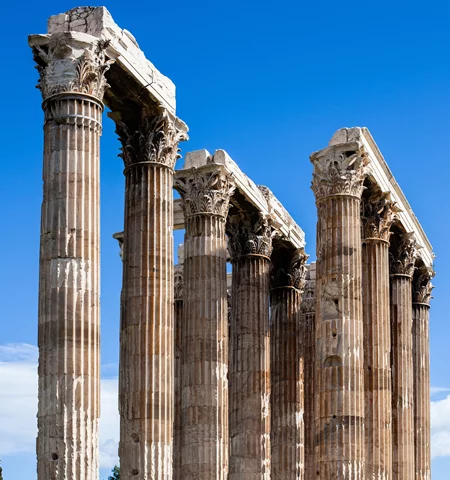
Following the path of St. Paul’s Second Missionary in Europe, leads you beyond the imposing Byzantine walls that guard the sophisticated port city of Thessaloniki. The beguiling architecture and meandering cobblestone streets are a pleasure to explore, topped only by the captivating site of the biblical city Berroia, known today as Veria. Join your expert guide to hear all about St. Paul’s tribulations as he tried to win over the noble Jews that lived here.
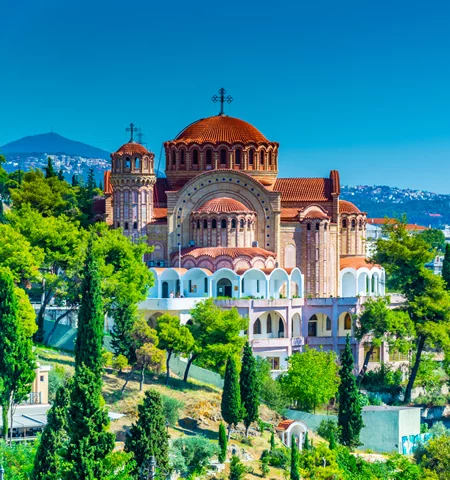
The seaport resort of Kavala perched on the slopes of Mt Symvolo offers spectacular panoramic views. It was here that St. Paul baptized the first Greek and European Christian convert, Lydia, and gave his first sermon. Visit the open-air baptistery, the monument that honors that Saint, and the prison ruins where he was held captive with St Silas, or join the specialist guide for a fascinating excursion to Neapolis and Philippi.
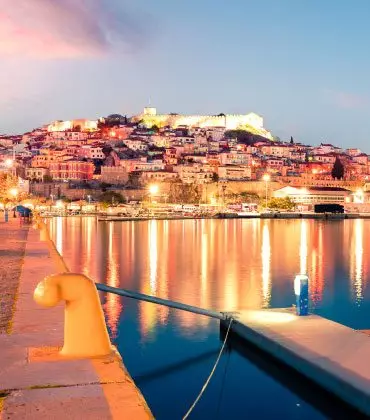
The vibrant city of Istanbul straddles the continents of Europe and Asia via the Bosphorus Strait. Here you can visit the lavish Byzantine and Imperial mosques which pierce Istanbul’s skyline with their towering minarets. The iconic Sultanahmet (Blue) mosque, the Romanesque Hippodrome, Topkapi Palace, and the world-famous Church of Hagia Sophia are just a few of the enigmatic attractions to admire.

Snaking its way along the beautiful coastline of Turkey’s seafront city of Dikili is a lush landscape of green forestry and expansive golden sands. Sparkling crystalline turquoise waters complete the captivating scenery. Here you have the opportunity to visit the Ancient Pergamon and the ancient Acropolis. The remains of the healing temple of Asklepion is the final stop of the day.
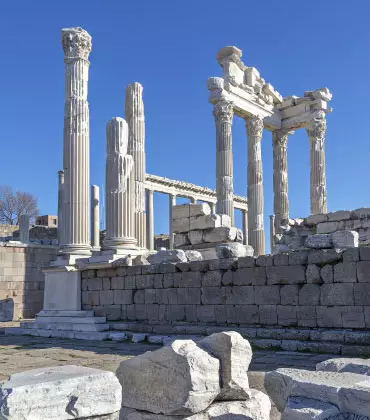
In Turkey’s picturesque seaside resort of Kusadasi, St. Paul wrote a letter to the Ephesians and preached at the Great Theatre of Ephesus. The second-largest city of the Roman Empire is also the home of one of the Seven Wonders of the Ancient World – the Temple of Artemis. You will learn about this and more on our complimentary tour to ancient Ephesus and the city of Miletus.

Patmos is the smallest of the Greek Dodecanese islands and also its most spiritual. The tranquil island is famously known for being the location where John the Apostle experienced the vision that inspired the Book of Revelations. The last remaining disciple was banished to Patmos by Rome. Follow in the footsteps of pilgrims to St John’s Monastery and the Holy Grotto of the Apocalypse.

We arrive back in the Greek capital of Athens early, giving the entire day to do as you please in the beating heart of Greece. However, you don’t have to leave us just yet. Our expert guides are waiting to escort you on a mesmerizing trip to either the ancient Corinth and Bema of St Paul or show you the highlights of the ancient Acropolis.
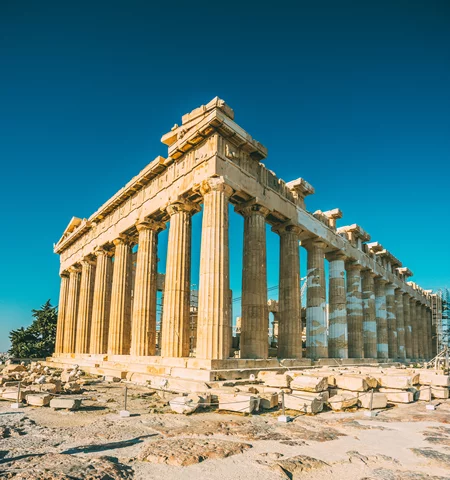
Cabin Options

Availability & Pricing
Prices per person based on double occupancy
Reserve Your Cabin
Junior balcony suite, exterior staterooms, what's included in the cruise, highlights and notes, our onboard services have you covered. whether you need the finishing touch to your evening outfit or a souvenir for your loved ones back home, our onboard shops have got it all – and the goods are tax-free capture the moments that matter with our professional photographers, so those memories can last forever. wi-fi is available as an add-on to your booking..
WHAT’S INCLUDED:
This fare includes:
- Complementary dining
- Onboard entertainment
- Daily activities
- Specially selected meal drinks
- Complimentary $80 shore excursion discount
Not included
Airfare, transfers, excursions, port fees, travel insurance, personal expenses, baggage services
Instagram Code:

- Africa (continent)
- Why Teeming
- Terms and Conditions
- Newsletter Subscription
- In the News

IMAGES
VIDEO
COMMENTS
Paul's missionary journeys helped spread the gospel throughout much of the ancient world. Over the course of his ministry, the Apostle Paul traveled more than 10,000 miles and established at least 14 churches. The Book of Acts records three separate missionary journeys that took Paul through Greece, Turkey, Syria, and numerous regions you won ...
Here is a map of Paul's second missionary journey to help you follow along: Paul's second missionary journey is recorded in Acts 15:36—18:22. A year or two after completing their first missionary journey, Paul suggested that he and Barnabas revisit the churches they had planted. A disagreement arose over whether or not John Mark, who had left ...
After Paul's first missionary journey, he and Barnabas returned to Syrian Antioch and reported the great number of Gentiles in modern-day Turkey who had believed.They stayed "no little time" there (Acts 14:28). While in Antioch, Paul and Barnabas were met by a group who came down from Judea ("down" refers to elevation; Jerusalem sits at 2,582 feet above sea level, and Syrian Antioch ...
Paul's Second Missionary Journey. 16 Paul went first to Derbe and then to Lystra, where there was a young disciple named Timothy. His mother was a Jewish believer, but his father was a Greek. 2 Timothy was well thought of by the believers [] in Lystra and Iconium, 3 so Paul wanted him to join them on their journey. In deference to the Jews of the area, he arranged for Timothy to be ...
Paul took four missionary journeys. Paul's first three missionary journeys are recorded in the book of Acts. The fourth is alluded to in Paul's letters. On the first missionary journey Paul went through Cyrus, Pamphylia, and Galatia. On his second missionary journey he went through Galatia, Macedonia, and Achaia.
Paul's Journeys. Paul traveled over 10,000 miles proclaiming the gospel of Jesus Christ. His journeys on land and sea took him primarily through present day Israel, Syria, Turkey, and Greece. Paul walked the roads built by the Romans to facilitate their control over their Empire. Travelers took to the roads in as large a group as they could find.
Maps of Paul's 2nd Missionary Journey. As you can tell, Paul's second journey is longer than his first, with LOTS of stops. We have covered the major events in these cities, but seeing a map is always nice. It helps give you a visual of where he and his team went. Down below, you will find a map of Pauls's 2nd journey route.
You are here: Home 1 / Timelines 2 / Paul's First and Second Missionary Journeys. First Missionary Journey and Jerusalem Council - Acts 13-15. Second Missionary Journey - Acts 16-18:22. This map with captions will guide you through the apostle Paul's first and second missionary journeys as they are described in the book of Acts.
Map 24 Paul's Second Missionary Journey . Acts 15:40-41 Paul is joined by Silas ('Silvanus' in Latin - see 1 Thessalonians 1:1, 2 Thessalonians 1:1, 2 Corinthians 1:19 & 1 Peter 5:12). Silas is from the Jerusalem Christian community (see Acts 15:22-35). They travel through Syria and Cilicia encouraging the new believers there (see 2 on ...
Paul's Second Missionary Journey approx. 51 A.D. Found in Acts 15:39-41; Acts 16-17; Acts 18:1-22. This is a map, Life and Work of St. Paul (1879) by Farrar. ... Life and Work of St. Paul (1879) by Farrar (Click image to enlarge) Search Results in Other Versions. Search Results by Book. BLB Searches. Search the Bible ...
This enables you to more easily relate our studies with other studies, references, and maps, which most likely adhere to the same scheme. The four journeys of Paul are... 1st missionary journey (Acts 13:4 to 15:35). 2nd missionary journey (Acts 15:36 to 18:22). 3rd missionary journey (Acts 18:23 to 21:17). Journey to Rome (Acts 27:1 to 28:16).
Paul's 2 nd missionary journey is recorded in Acts 15:36-18:22. After a short stay in Antioch, Paul wanted to go with Barnabas on another journey. But a sharp dispute arose (with John Mark being the center of the debate) and the two split. Barnabas ended up back in Cyprus with John Mark and Paul took a different route throughout Asia Minor ...
Several segments of Paul's second missionary journey were by sea. He sailed from Troas to make his first European landfall at Neapolis, the port of Philippi (Acts 16:11). Certainly the return journey from Corinth via Ephesus to Caesarea was also by sea (Acts 18:18-22). Combining land and sea travel was common in the eastern Mediterranean.
The first journey of St. Paul begins when St. Paul, Barnabus, and St. Mark set out from Antioch (Acts 13:4). This journey started after 44 AD and ended a "long time" (Acts 14:28) before 50 AD. They left Antioch for Seleucia and sailed to Cyprus, large island 100 miles off Syrian coast. There they went to Salamis and Paphos where St. Paul ...
The following is a brief chronicle of these missionary journeys: 1st Missionary Journey (Acts 13-14): Answering God's call to proclaim Christ, Paul and Barnabas left the church at Antioch in Syria. At first, their method of evangelism was to preach in the town synagogues. But when many of the Jews rejected Christ, the missionaries recognized ...
What's considered Paul's "first journey" started in the year 45 and ... CC BY-SA 2.0. The Acropolis of Athens, where St. Paul was asked to give a speech about the "Unknown God" to the ...
The second missionary journey followed just after the Council of Jerusalem. It took place from 49-52. Paul went to Asia Minor where he dreamt about a man from Macedonia who begged him to come to his land to preach the Gospel. Paul heeded the dream and the Good News was shared in Europe. The third missionary journey in 53-58 included the nearly ...
Late Autumn 49 to Late Summer 50. Paul takes Silas with him to Tarsus. From there they travel to Derbe and Lystra. It is in Lystra that he meets Timothy, who would become his frequent traveling companion, fellow laborer in spreading the gospel and his best friend (Acts 16:1; 1Timothy 1:2, 4:14). The apostle has Timothy circumcised (Acts 16:3).
The missionary activity of Paul described in Acts 15:40 - 21:15, covering the years of c. 50 - 58, is commonly divided in to the "Second" (15:40 - 18:22) and "Third" Journeys (18:23 - 21:15). Paul himself subsumes his activities of these years into a general description covering all of his evangelizing. He envisioned an arc extending ...
The first journey begins when Paul, Barnabas, and Mark set out from Antioch (Acts 13:4). This journey started after 44 AD and ended a "long time" (Acts 14:28) before 50 AD. They left Antioch for Seleucia and sailed to Cyprus, large island 100 miles off Syrian coast. There they went to Salamis and Paphos where Paul met Bar-Jesus the sorcerer.
Paul (also named Saul of Tarsus; c. 5 - c. 64/65 AD), commonly known as Paul the Apostle and Saint Paul, was a Christian apostle who spread the teachings of Jesus in the first-century world. For his contributions towards the New Testament, he is generally regarded as one of the most important figures of the Apostolic Age, and he also founded several Christian communities in Asia Minor and ...
Saturday, October 14, 2023. Athens, Piraeus (Greece) Details. Arrival: 11:00a. Depart: 4:00 pm. Boarding is from 11:00a - 2:45p. Ship departs at 4:00p. Your fascinating 7-night Steps of St. Paul journey begins in the magical city of Athens. The Greek capital is one of the oldest cities in the world and home to the iconic landmark of the ...
In this major two- part documentary series, one of our most familiar and best loved TV personalities, DAVID SUCHET, undertakes an epic journey spanning the M...